The Top Cities to Visit in Trentino Alto Adige, Italy
:max_bytes(150000):strip_icc():format(webp)/martha_bio-56a3c8865f9b58b7d0d3b5fe.jpg)
James Martin
The Trentino-Alto Adige, or South Tyrol, region is Italy's northernmost region. It's mountainous and has lots of rivers and lakes to explore. Medieval towns and castles dot the region and it's a great place to go for Christmas markets because of the Austrian influence.
The A22 Autostrada (the line shown on the map) runs through the center of the region from the Brenner pass in the north and continues south to Verona and beyond. A major rail line also runs near the autostrada. To the north of Trentino-Alto Adige is Austria. A small section of Switzerland abuts the region's northwest corner. To the east is the Veneto region , and to the west is Lombardy and the Lakes region.

Provinces of the Trentino Alto Adige Region
The Trentino-Alto Adige region is broken into two provinces. The southern province of Trentino is mostly Italian speaking while in the northern province of the Alto Adige, called Sudtirol or the South Tyrol, the inhabitants speak mostly German and towns have both an Italian and a German name. The South Tyrol was part of Austria-Hungary before being annexed by Italy in 1919.
Both provinces are bordered by mountains and have good opportunities for skiing and winter sports as well as mountain hiking from late spring through early fall. Our Trentino-Alto Adige Map shows the most interesting towns to visit in the region.
Trentino Province (Southern) Principal Towns
- Trento , on the train line between Italy and Munich, is the capital of the province. Trento has a 14th century Duomo, a castle, some handsome 15th-16th century buildings, the 11th century Torre Civica (tower), and a 13th century palazzo.
- Rovereto is often overlooked by tourists but is a nice place to visit. Rovereto's streets are lined with old palaces and stately buildings. There is a war (and peace) museum in town, too.
- Madonna di Campiglio is one of the best ski resorts in the Dolomites with many miles of ski slopes of all levels, but it's also popular for its summer residences. There are lots of lodging options here.
- Riva del Garda is on the northern tip of Lake Garda which protrudes a little into the Trentino region. Riva is a popular summer resort, especially for Austrians and Germans.
Alto Adige (Northern) Principal Towns
- Bolzano or Bozen is the capital city of the province and is on the train line from Italy to Munich. Bolzano had a good medieval center and Gothic Duomo. Castel Roncolo has some good medieval frescoes.
- Bressanone or Brixen has a good medieval center with porticoed walkways, fine buildings, and a river. Bressanone has a heavy German influence and many people still speak German rather than Italian.
- Merano or Meran has been a popular spa and resort town for a couple of hundred years because of its mild climate. The medieval town is on the right bank of the river Passirio. There's a 15th century castle and walkways along the river and in the nearby hills.
Food and Wine of the Trentino-Alto Adige
The cuisine in the Trentino-Alto Adige is a cross between Italian and Austrian so you'll find dumplings, canederli , as well as meat filled ravioli. Speck , a smoked ham, comes from this region. Beef, pork, hare, and venison frequent the menu as does trout. Apples and mushrooms play a large part in the cuisine, too. Good DOC wines are produced in the hills including Pinot, Riesling, and Traminer whites and Cabernet and Merlot reds.
Italy's Dolomites Region: The Complete Guide
Best Italian Lakes to Visit on Your Vacation
The Top 23 Things to Do in Italy
Best Places to Go in Northern Italy's Veneto Region
The 15 Best Destinations in Italy
The Top 10 Things to Do in Bolzano, Italy
A Guide to Italy's Wine Regions
The Lakes of Northern Italy
Get to Know Lake Garda in Italy
Where to Go for the Holidays in 2019
Lombardy Cities Map and Travel Guide
The 14 Best Things to Do in Verona, Italy
Switzerland Travel Guide
The Geography of Italy
Northern Italy's UNESCO World Heritage Sites and Cities
Veneto Region of Northern Italy: Tourist Map With Cities

Northern Italy
Trentino is sure to amaze you with its immense natural heritage, the spectacular splendour of the dolomites and fascinating sites steeped in history.
Discover Trentino’s culture of slow travel, taking the time to savour every corner among nature and cultural trails and educational farms. You will find hundreds of hotels offering wellness centres for truly relaxing holidays for the whole family in some of Italy's most beautiful villages, set in unique landscapes.
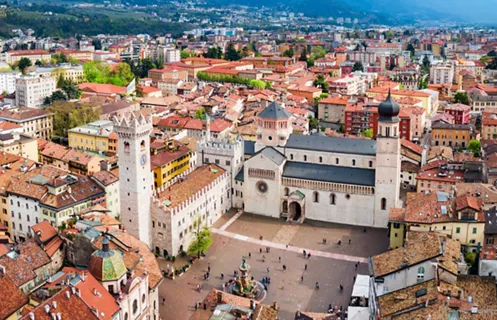
Trento unites the charm of its important history with the beauty of a village at the foot of enchanting mountains. A much sought-after destination for those who love history and nature, the forests and snow, as well as culture and good food. Trento is a city with many things to offer: at Christmas it hosts a much-loved and lively market, there is rich cultural life, in part thanks to the historic, prominent university, and everything is close at hand, in a delightful historic centre that can be explored in just a few hours.
What to see in Trentino
- Art & Culture
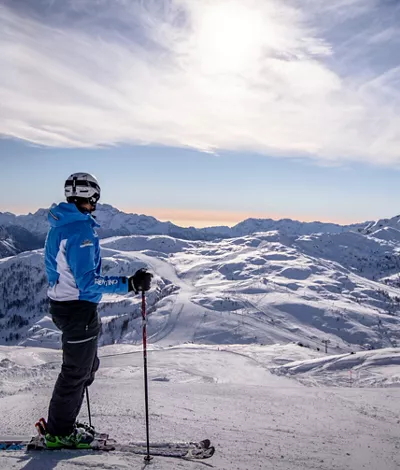
Five not to be missed ski resorts in Trentino
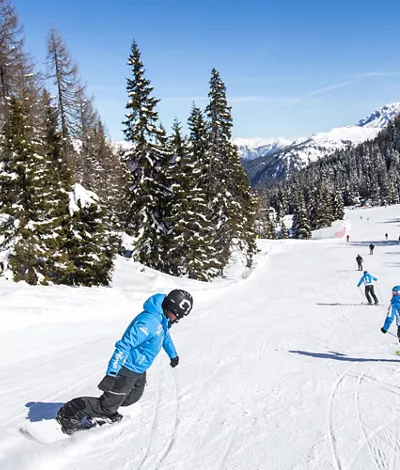
Madonna di Campiglio
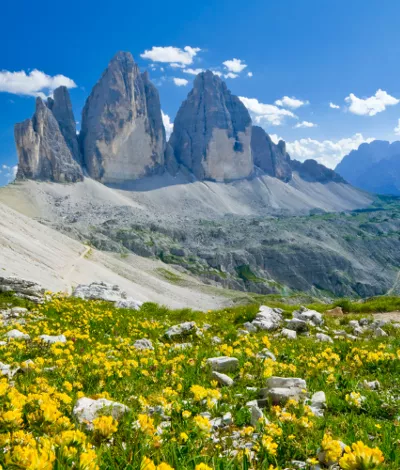
In the Dolomites, discovering winter flowers
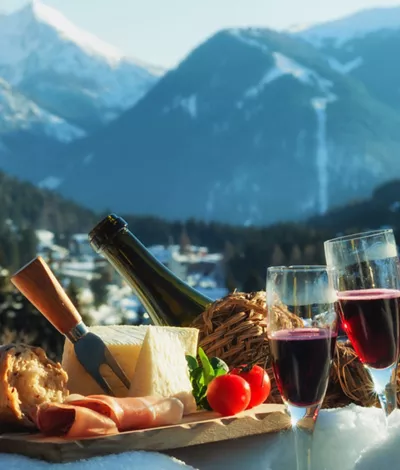
High altitude gourmet cuisine: 5 chalets in the Trentino Region
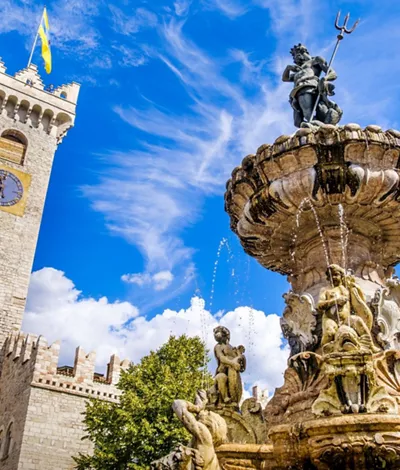
Trento, a precious mix of nature, history and culture
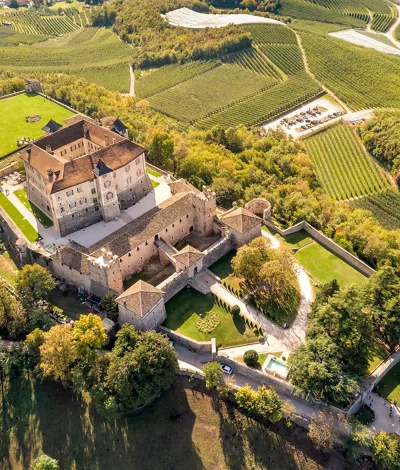
Trentino on the road
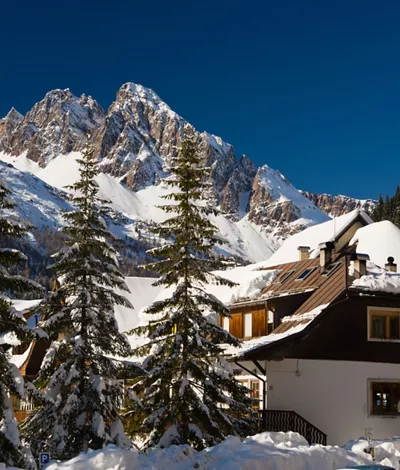
San Martino di Castrozza
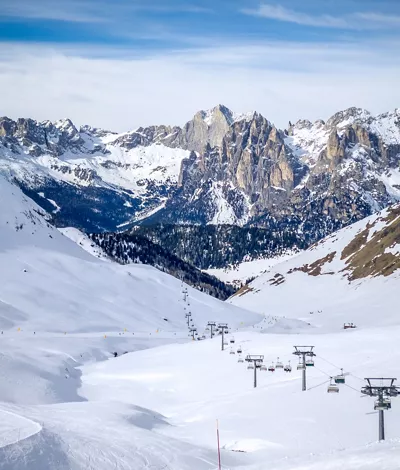
The Val di Fassa, where you can fall in love with the Dolomites
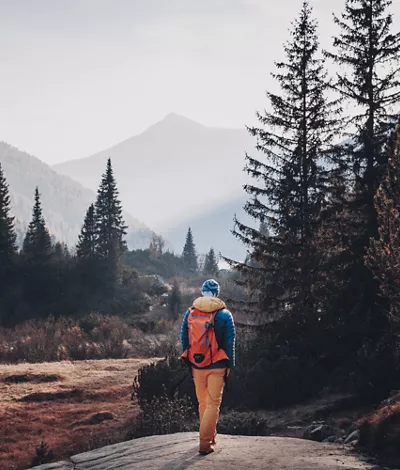
5 special places to discover Trentino foliage
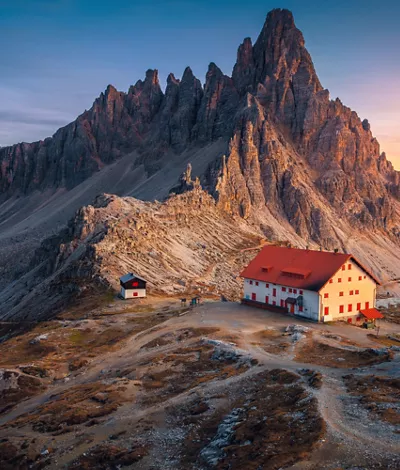
Where to admire the Dolomites at sunrise with sunrise tours
Pozza di fassa, thermal spas and hiking against the backdrop of the pink mountains of trentino.
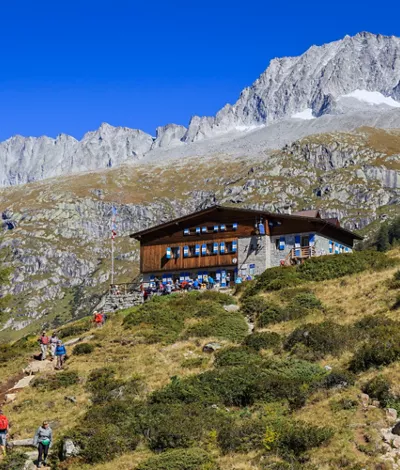
Fumo Valley: the precious pearl of western Trentino
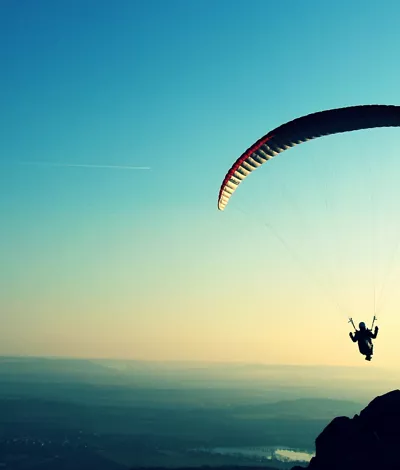
Paragliding in Trentino, adrenaline and thrills on the roof of Italy
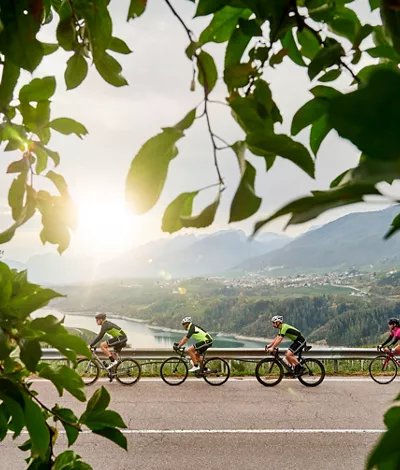
Trentino: pedalling in nature with the scent of wines and apples
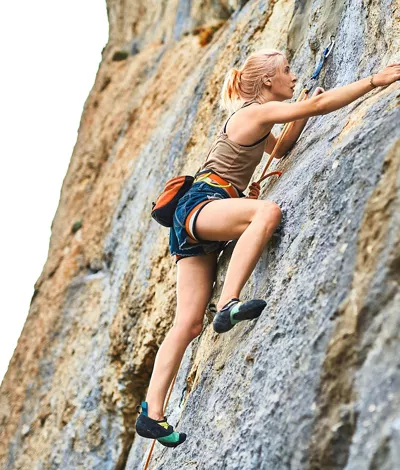
In Trentino, climbing with a view of Lake Nembia
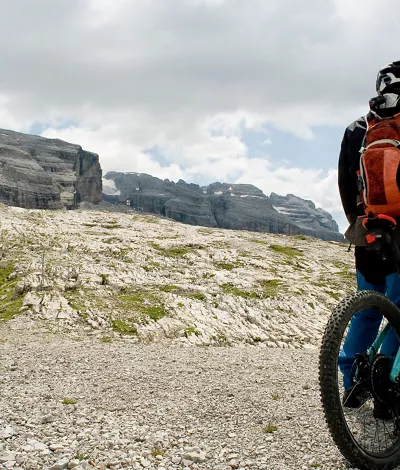
The Trentino district: surrounded by the Dolomites, a new paradise for bike trail enthusiasts
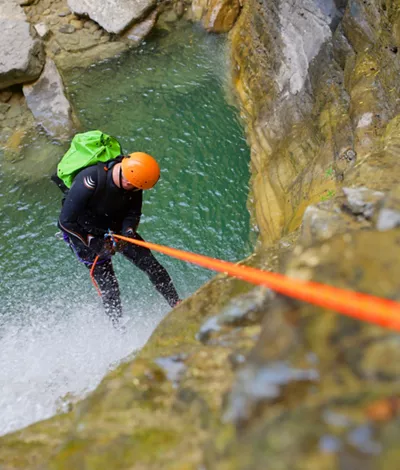
Canyoning in Trentino: an adventure along the waters of the Chiese river

Val di Fiemme, a skiers paradise
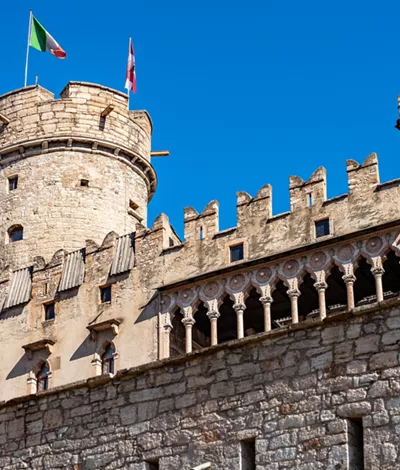
Trentino: the Cultural Path dedicated to History and Art
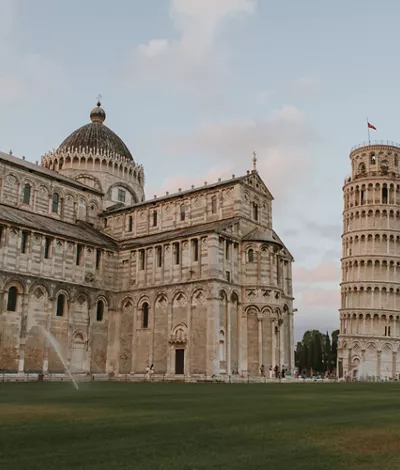
Italian cities of art best equipped for smart working
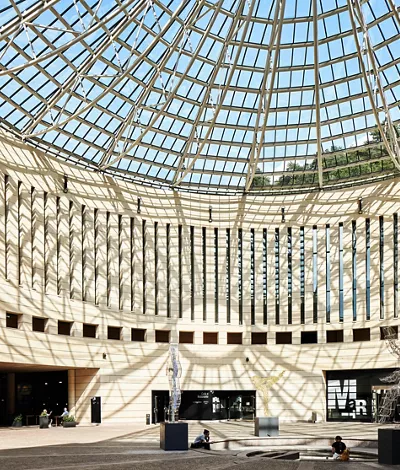
In Trentino, along the trail combining art and nature
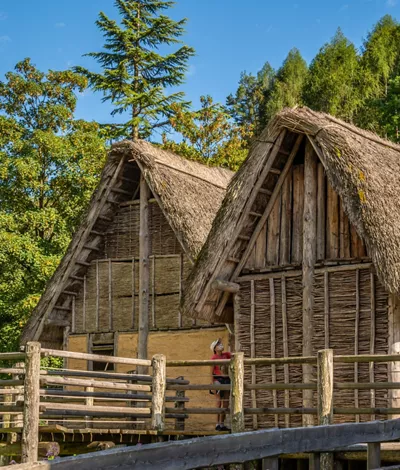
Prehistoric pile-dwelling sites in the Alps
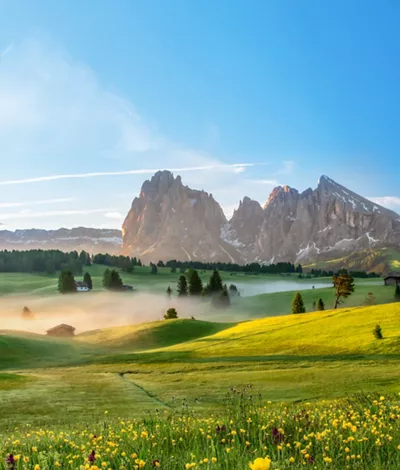
The Dolomites: the most beautiful architectural work in the world
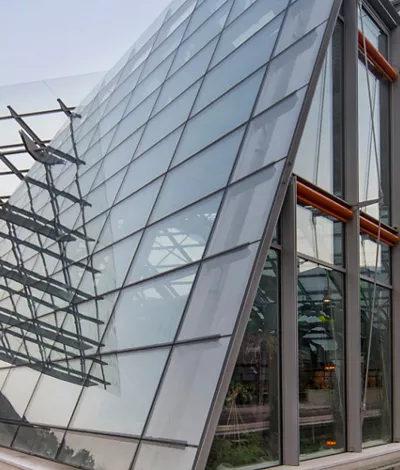
Along the path of science and nature in the Dolomites
Inspiration for living the italian way.
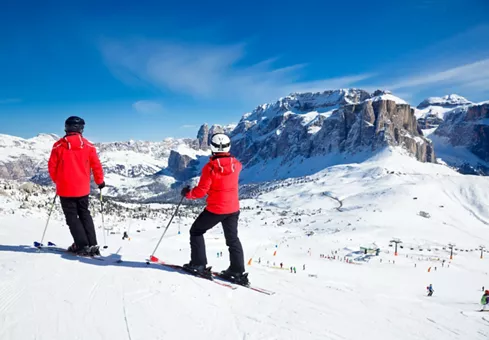
Skiing in the paradise of the Dolomites: the Dolomiti Superski area
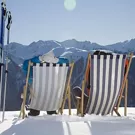
In the Dolomites between spas and skiing, a wellness boost

Snow for everyone!
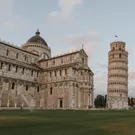
With its immense artistic heritage and the spectacular Dolomites
Trentino is sure to amaze you with its immense natural heritage, the spectacular splendour of the Dolomites and fascinating sites steeped in history. Discover Trentino’s culture of slow travel, taking the time to savour every corner among nature and cultural trails and educational farms. You will find hundreds of hotels offering wellness centres for truly relaxing holidays for the whole family in some of Italy's most beautiful villages, set in unique landscapes.

Continue living like an Italian
Subscribe to the Newsletter so as not to miss places, events and experiences for experiencing the best side of Italy: the authentic one.
Keep up to date
Would you like to learn about the most authentic experiences to be had in Italy, stay up to date on the most interesting events, discover our special offers and receive lots of insider hints and tips?
Save your favorite places
Create an account or log in to save your wishlist
Do you already have an account? Sign in
Trentino-Alto Adige Travel Guide
Book your individual trip , stress-free with local travel experts
- roughguides.com
- trentino-alto-adige
- Travel guide
- Itineraries
- Local Experts
- Travel Advice
- Accommodation
Plan your tailor-made trip with a local expert
Book securely with money-back guarantee
Travel stress-free with local assistance and 24/7 support
Carlo DeSando
Wonderful Time in Italy We were covered from the moment we landed in Rome. The drivers were great, the connections were flawless, and it was well-planned a...
Draped across the high Alps, where Italy, Austria and Switzerland collide and their cultures blur, Italy’s northernmost region is a major draw for holiday-makers who mostly come for winter skiing, summer hiking and tranquil year-round vistas. However, in past times this region was far from today’s peaceful vacation paradise; a string of castles along the Adige (Etsch) Valley bear witness to the cut and thrust of medieval politics, and World War I saw prolonged and ferocious fighting, with Italian and Austrian troops battling it out in the harsh conditions of the Alpine ridges. Armies of brightly attired skiers and sturdily booted hikers have long since replaced the troops, invading the sunny slopes on ski and board or marching along one of the hundreds of dramatic trails that crisscross the landscape.
What to see in Trentino-Alto Adige
The cuisine of trentino-alto adige, activities in trentino-alto adige, the dolomiti di brenta, the catinaccio and gruppo di sella, alpe di siusi (seiser alm), cortina d’ampezzo, merano and around, parco nazionale dello stelvio, tailor-made travel itineraries for italy, created by local experts.

8 days / from 2622 USD
Experience the hit TV show 'The White Lotus' in Sicily
Stay in beautiful Taormina with gorgeous views of Mount Etna and discover Sicily, including famous filming locations. Go on exclusive wine tastings, discover the Greek theater in Taormina with a private guide, visit other Sicilian towns and enjoy the crystal clear water on this week-long trip.

8 days / from 3258 USD
Enchanting Italian Lakes
Experience the picturesque lakes of Northern Italy, including Lake Garda, Como, Lugano and Maggiore; explore the charming Borromean Islands – former favourites of Ernest Hemingway – and stroll the romantic streets of Verona and Milan. All of this, and much more, with this self-drive trip!

16 days / from 3258 USD
From Venice to Florence: A Grand Tour of Northern Italy
From the atmospheric canals of Venice and the picturesque coastline of Cinque Terre, to the trendy designer boutiques of Milan and the Renaissance-infused streets of Florence, Northern Italy has plenty to offer. Experience it all with this comprehensive trip.
As its double-barrelled name suggests, the region is made up of two areas: Trentino, the southern part, is 98 percent Italian-speaking and the cuisine and architecture belong predominantly to the south rather than the Alps. By contrast, the mountainous terrain around Bolzano – known both as the Südtirol (South Tyrol) and Alto Adige – was only annexed to Italy at the end of the World War I. Here, onion-domed churches dot vineyards and forests, street signs are in German and Italian and the landscape is redolent of illustrations from the Brothers Grimm. German is the dominant tongue though immigrants from Italy’s south rarely speak anything other than Italian. Both Trentino and Alto Adige enjoy autonomy from central government, along with one of the highest standards of living in Italy.
The region is dominated by the barren, jagged rock walls of the Dolomites. Some of the most eye-catching peaks in Europe, these vast massifs have been eroded over the last 200 million years into a weird and wonderful array of needles, towers and pinnacles. In 2009 the range was added to the UNESCO World Natural Heritage List for their unique geology – they began life around 250 million years ago as a giant coral reef beneath the ancient Tethys Ocean – and for their diverse ecosystem abundant in rare flora and fauna. Numerous cable cars rise from the region's small resorts enabling you to hike at 2000–3000m, with a web of well-marked trails lasting from a gentle day-hike to a two-week trek. Views of this spectacular landscape can also be savoured from the comfort of luxurious spa hotels, with first-rate regional cuisine and a unique selection of treatments from bathing in thermal water to "dry baths" involving lying swaddled in sheep's wool or mountain hay.
Down in the valleys, Trentino-Alto Adige has a flourishing cultural scene, with cutting-edge galleries and museums, such as Trento's MUSE science museum and Bolzano’s Museion gallery . The regional capital Trento has an atmospheric old centre and an enviable quality of life, while Bolzano , Alto Adige’s chief town, with its star attraction the famous “Ice Man”. Verdant hillsides planted with vineyards can be visited as part of the Strada del Vino wine-tasting route, and the valley floor is carpeted with apple trees which produce the principal ingredient for Südtirol’s delicious strudel.
Both Trento and Bolzano are transport hubs, reachable by train via Verona and Innsbruck, and by bus from Bergamo and other airports. The scenic Great Dolomites Road links Bolzano with Cortina d’Ampezzo. Merano, in the northwest, is another hub, serving the Val Venosta (Vinschgau) and its side valleys which take you deep into the mountains of the Parco Nazionale dello Stelvio, straddling the border with Lombardy.
The Italianization of the Tyrol
The South Tyrol (Südtirol) was Italy’s reward for cooperating with the Allies during World War I. But when Mussolini’s Fascists came to power in 1923 the region was renamed Alto Adige after the upper reaches of the Adige River, and despite the fact that German speakers outnumbered Italian speakers by around ten to one, a process of sometimes brutal Italianization was imposed on the area. Cartographers remade maps, substituting Italian place names (often made up) for German; people were forced to adopt Italian names; the teaching of German in schools was banned and stonemasons even chipped away German inscriptions from tombstones. World War II then intervened, and by 1946, Austria and Italy came to an agreement ratified under the Paris Peace Treaty that Austria would give up its claim to the region on condition that Italy took steps to redress some of the cultural damage perpetrated under Fascism.
Successive governments have channelled funds into the area allowing the region more independence than ever before and much greater say in local law. Over the last few years, Italy has moved closer into the European Union, and its central and regional governments have become more tolerant of ethnic diversity and, increasingly, German is the language of preference in Südtirol.
Alto Adige cuisine has Germanic traditions, while Trentino cooking blends mountain influences with Italian flavours. The hearty traditional food is great for refuelling after a day of hiking or skiing and the quality of produce is exceptional, even in the simplest mountain hut. For finer dining, adventurous chefs are reworking old recipes to fashion much lighter dishes, and it is well worth trying out some of the pricier restaurants we list for a new take on local specialities.
A traditional meal starts with some kind of salami ( lucaniche in local dialect), often paper-thin slices of salt beef, or Tyrolean canederli – bread dumplings spiked with speck (smoked ham) often served in broth ( brodo ). You’ll also see strangolapreti (bread and spinach gnocchi) and schlutzkrapfen (spinach-filled pasta) on the menu. Fresh lake and river fish, game and rabbit are popular as secondi , as are venison goulash or boiled cured pork with sauerkraut. Desserts are often based on apples, pears or plums, readily available from the local orchards. Other sweet treats include apfel strudel , sachertorte and kaiserschmarren , a scrambled pancake with raisins.
A highlight of the year for food- and wine-lovers is the autumn Törggelen season, when everyone heads for the hills to sample the new vintage and snack on mountain ham and roast chestnuts, followed by a walk.
Vines have been cultivated here since before Roman times, and Trentino-Alto Adige produces more DOC wines than any other region in Italy. Most famous are the Pinot Grigios and Chardonnays, which are bright and aromatic from being grown at high altitudes and in cool conditions. These also provide wine makers with the raw material for some outstanding traditional-method sparkling wines, often marketed under the spumante Trentino Classico label. Despite the excellence of the whites, including the aromatic slightly sweet Gewürztraminer, local wine makers actually make more reds often with local varieties like Teroldego and Schiava (known as Vernatsch in German-speaking areas). Red wines made from Schiava are good when young: look out for the pale red Kalterersee (Caldaro) and the fuller, fruitier St Magdalene (Santa Maddalena); those made from the Lagrein grape variety are more robust, such as the strong, dark Lagrein Dunkel, or the Kretzer rosé from Bolzano’s vineyards at Gries. Also worth seeking out is the rare vino santo (not to be confused with vin santo from Tuscany) from Trentino’s Valle dei Laghi – a luscious dessert wine made from local Nosiola grapes.
Festivals and events in Trentino-Alto Adige
Wine-related festivities abound across the region with almost every village celebrating its vintages, harvest or related traditions – ask local tourist offices for details. The biggest wine bash, the Festa in Vino takes place in the sixteen towns along the South Tyrolean Wine Road from mid-May to mid-June, with tours, music, tastings and myriad other events. The month of events comes to a climax with the Night of the Cellars when wine producers throw open their doors on the final night.
There are plenty of summer concerts, but possibly the best event is the Suoni delle Dolomiti series of jazz, folk and world music concerts by artists from all over the world: the concept is an original one – you hike (sometimes with the artists) to the chosen location, which may be a wood, perhaps, or a rocky gully, then listen to the concert . Performances are in the early afternoon and sometimes at dawn. In the best Central European tradition, vast Christmas markets take over the historic centres of Trento and Bolzano , as well as most towns in the region.
This section of the italian Alps offers some exhilarating hiking, often subject to snow, ice and scorching sun in the same day. There are plenty of opportunities for day-walks in stunning scenery that are within average capabilities, and routes are well established and well signposted. Alternatively, consider tackling one of the longer trails known as alte vie (literally “high ways”). Four of these run north–south between the Val pusteria (pustertal) and the Veneto; four from the Val d’isarco (eisacktal) south; and two from Bolzano , with plenty of mountain huts along the way for meals and overnight accommodation. Some of the initial ascents are strenuous, but once you are up on the ridges the paths level out and afford stupendous views across the valleys and glaciers. parts of the trails are exposed, or have snowfields across them, but there are usually detours you can take to avoid these. In Trentino two well-planned circuits provide spectacular views, the Dolomiti Panorama Trek and the Dolomiti Brenta Trek.
Some 20 km to the south of Trento and a mere 13 km from Lago di Garda, Rovereto is a small picturesque town, with stylish palazzi containing university faculties which give the town a youthful, lively atmosphere. Its main attraction is the outstanding mart gallery, though it's also home to the world's largest ringing bell, at Colle di Miravalle, which tolls a hundred times daily to honour those who died in the war. The bell is in a little park, where there are lovely views which you can admire while listening to the bell toll.
Things to do in Rovereto
Despite Rovereto having a population of only 40,000 this sleepy town still has a surprising amount of things to do. Not to miss spots are Piazza Rosmini, Palazzo Pretorio and Palazzo Sbardellati. The highlight of Rovereto is Rovereto Castle, considered to be the best example of alpine fortification. Built in the 14th Century, the castle has progressed with history and has been used for various purposes throughout time.
The vineyards, as with most places in Italy, are picture-perfect. Bike rides and walks are the best way to immerse yourself, especially if you wish to stop off for tasters along the way. For Mozart fans, visit St. Marks Church, where the young Mozart held his first public concert.
Designed by Mario Botta, MART (Museo di Arte Moderna e Contemporanea) hosts world-class exhibitions and is one of Trentino's unmissable experiences. The spectacular building, with spacious galleries wrapped around a central circular atrium flooded with light, is impressive enough even before you view the art inside. Skilfully curated, themed exhibitions use works loaned from institutions and individuals around the world as well as drawing on the gallery’s collection of 30,000 paintings, design pieces and sculptures by names including Lichtenstein, Rauschenberg and Warhol (as well as lesser-known locals such as Italian Futurist Fortunato Depero, Giorgio de Chirico and Giorgio Morandi). A smaller branch nearby, the Casa d'Arte Futurista Depero displays Depero's large cloth collages, tapestries, furniture and other design pieces.
With their saw-toothed peaks and glaciers, the Dolomiti di Brenta, northwest of Trento, have a rougher character than the better-known Dolomitic peaks to the east – and their trails are far less well-trodden. While they are steep, few peaks rise above 3000m, and the paths are easy to follow, though the walking is strenuous. Climbers come here for the towers of Cima Tosa and Cima Brenta, accessible by vie ferrate – iron “ladders” knocked into the rock. If you are looking for easier strolls, Val Genova has a gentler beauty, with a woodland path taking you past a number of waterfalls cascading down the mountainside.
The range is circled by a good but slow and winding road, the southern half of which passes through the quiet lake resort of Molveno. The Trento-to-Madonna di Campiglio road takes you past the frescoed churches and wooded valleys of the Valle Rendena before arriving at Campiglio itself, the best base for skiing in the area, and a transport hub for walkers and climbers. The northern half of the Brenta mountains is bounded by the Val di Non and the Val di Sole, both served by the privately run Trento–Malè railway.
Vie ferrate
Vie ferrate (literally “iron ways”) are an Italian phenomenon, consisting of fixed metal ladders, pegs and cables that climbers clip onto with karabiners, making otherwise difficult routes accessible. Many vie ferrate began life in the late nineteenth century as mountaineering took off as a sport in Europe; Alpini troops put others in place during World War I to help the climbs that were a matter of survival for the soldiers fighting in the mountains. In the decades since then, volunteers from local Club Alpino Italiano groups have created many more.
Kompass maps show vie ferrate as a line of little black dots or crosses, so you can easily avoid them – they are definitely not for beginners or vertigo-sufferers. To use them, you need to be confident belaying and have the proper equipment (including helmet, ropes, two self-locking karabiners and a chest- or seat-harness). Incidentally, it’s not advisable to climb a via ferrata in a thunderstorm either, as it might just become one long lightning conductor.
Once you’ve done a few straightforward paths up in the mountains you may be inspired to tackle some ferrate, and there are plenty of specialist guides around who can show you the ropes – though you'll need to book at least a week ahead in high season. Guides charge by the hour, so save money by getting a small group together. Many of the rifugi are run by mountain guides, or you can enrol on a mountain skills course: both Trentino and Alto Adige provincial tourist offices keep lists of guides and mountaineering schools. Alternatively, contact the Collegio Guide Alpine del Trentino , an organisation for Alpine guides in Trentino: for Alto Adige, contact Verband der Südtiroler Berg- und Skiführer .
The Catinaccio (or Rosengarten) range is one of the best-known sights in the Dolomites, its unmistakable bare-rock pinnacles appearing on brochures, guides and myriad souvenirs. This immense wall of stone along the edge of the 3000m-high massif takes on a famously rosy glow at sunset, and the mountain plays a lead role in the area’s best-known myths and legends. Trails across this mountain are popular with mainly Italian and German walkers and, although the zigzag paths to the peaks can be crowded in August, once you’re above the cable-car line, there’s plenty of wilderness to lose yourself in.
Access is simple enough from Vigo di Fassa, the main place to stay in the Val di Fassa, which splits off from the Val di Fiemme north of Predazzo at Moena. If you travel these roads and trails, you pass through one of the heartlands of Ladino culture.
At the head of the Val di Fassa, Canazei makes a good springboard for the high plateaux of the Gruppo di Sella, and the gentler trail of the Viel del Pan, which leads down to the tiny resort of Arabba. On the northern side of the Sella group, Corvara is a much larger resort with a sizeable Ladin population.
Ladin country
The Ladins ( Ladini in Italian, Ladinisch in German) are a community of around thirty thousand people living in the Gardena, Badia, Fassa, Livinallongo and Ampezzo valleys around the Sella massif. They’re united by their ancient language – Ladin – which was once spoken over a wide area, from Austria down to the River Po (in what’s now Emilia-Romagna ). The Dolomitic Ladin language, preserved by the relative remoteness of the territory, is linked to Swiss Romansch (there are 40,000 speakers in the Swiss Engadine) and Friulano (more than forty thousand speakers in the Friuli region of Italy).
The history of the Ladins is recorded in their epics, which recount tales of battles, treachery and reversals of fortune. Around 400 AD, the Ladins were constantly threatened with invasion by Germanic tribes from the north and others from the Po Valley. Christianity later emerged as a major threat, but the Ladins absorbed and transformed the new religion, investing the new saints with the powers of more ancient female divinities.
The Museo Ladin de Fascia, Strada la Pieif 7 (wistladin.net), between San Giovanni and Vigo di Fassa, is devoted to traditional Ladin working life and provides a fascinating introduction to Ladin culture, with intriguing exhibits on the language and history. It also has exhibits scattered throughout the territory, including a restored nineteenth-century cooperage (Botega da Pinter) at Via Dolomiti 3 in Moena; a restored watermill (Molin de Pezol) at Via Jumela 6 in Pera di Fassa; and a working, antique sawmill (La Sia) at Via Pian Trevisan in Penia, just outside Canazei. Tourist offices throughout the area have details of festivals, exhibitions and events.
The grasslands of the Alpe di Siusi (Seiser Alm), to the east of Bolzano , are Europe’s largest Alpine plateau, extending over sixty square kilometres above the rest of the valley bordered by Sciliar (Schlern), a flat-topped, sheer mountain which splits off at one end into two peaks. The lush summer pastures 2000m above sea level are superb for mountain biking and hiking, especially now that the area, protected by the Parco Naturale dello Sciliar, is closed to road traffic (except for guests of hotels on the Alpe) between 9am and 5pm.
If you are travelling by bus to Siusi (Seis) from Bolzano you can stash mountain bikes in the luggage compartment of the bus. The service passes through FIÈ AM SCILIAR (Völs am Schlern), famous for inventing the curative “hay bath”.
Dubbed the “Pearl of the Dolomites”, Cortina d’Ampezzo is well and truly part of the mountains of Trentino-Alto Adige, even though it officially belongs to the Veneto region next door. An upmarket ski resort – think an Italian St Moritz – Cortina boasts a gorgeous setting, surrounded by a great circle of mountains, and it’s had a starring role in many films, including The Pink Panther and For Your Eyes Only.
After hosting the Winter Olympics in 1956, Cortina swiftly became the resort to be seen in and in the 1960s you were just as likely to spot movie stars such as Brigitte Bardot and Sophia Loren sauntering down the Corso Italia as people in ski boots. Nowadays, the VIPs it attracts tend to be titans of Italian industry – the Agnellis, Benettons, Barillas and the president of Ferrari all frequent the resort – and the population swells from seven thousand to around forty thousand during the ski season (roughly Christmas to Easter).
An hour north by train from Bolzano , Merano (Meran) lies in an attractive, broad stretch of the Adige (Etsch) Valley. Neatly tended apple orchards and vineyards cover almost every square inch of the lower slopes and valley floor, but when you look upwards the scale changes due to the two great mountain ranges – the Ortles (Ortler) and the Giogaia di Tessa (Texelgruppe) encircling the town. Closer geographically and in looks to the Swiss and Austrian Alps than the Dolomites, the grandeur of the landscape turns up a notch here – and a simple event like a summer storm becomes a drama, with the whole valley reverberating to the rumble of thunder.
A well-heeled spa town, relaxed, stylish and packed with affluent shoppers and spa-goers, Merano has a mild climate that attracted Central Europeans at the beginning of the last century after Empress Elizabeth of Austria – known as Sissi – chose the town for her winter cure. The époque bequeathed a resort of fin-de-siècle hotels, gardens and elegant promenades.
The Parco Nazionale dello Stelvio (or the Stilfser National Park) is one of Italy’s major national parks: it extends north to the Swiss Engadine and southwest into Lombardy and covers the whole Ortles (Ortler) mountain range. The park is topped by one of Europe’s largest glaciers (the Ghiacciaio dei Forni) and crossed by the Passo dello Stelvio (2758m), which misses being the highest pass in the Alps by just 12m.
Ski tourism has made its mark, and the park is as crisscrossed by lifts as anywhere in the Alps, but it’s still a remarkable place. People come here for the high trails and glacier skiing in summer, or for the chance of seeing wildlife such as the red and roe deer, elk, chamois, golden eagle and ibex. A railway line running from Merano to Malles and connecting buses from stations along the way into the side valleys makes all places of interest below easily accessible.
Crossing the Passo dello Stelvio
The white-knuckle drive across the Ortles mountains over the Passo dello Stelvio (Stelvio Pass) to Bormio follows a convoluted route consisting of 48 switchbacks and turns. Motorbikers love the thrills and the views while cyclists see the climb as the ultimate challenge – it’s often an important stage of the Girò d’Italia. It's one of the last Alpine passes to open to traffic each year, sometimes staying closed until July if there's been a late fall of snow. You can access the pass by bus from Malles, one early morning, the other mid-afternoon.
The end point of the route, Bormio, is a rather snooty resort with a sprawl of hotels in its cobblestoned core. The visitor centre at Via Roma 131/B can advise on accommodation as well as nature trails in the southern reaches of the Stelvio national park.
Top image: Panorama of the gorgeous Lake Garda surrounded by mountains in Riva del Garda, Italy © pointbreak/Shutterstock
Discover more places in Italy

The Rough Guides to Italy and related travel guides
In-depth, easy-to-use travel guides filled with expert advice.
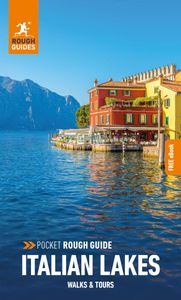
Find even more inspiration here

Planning your own trip? Prepare for your trip
Use Rough Guides' trusted partners for great rates
written by Rough Guides Editors
updated 03.09.2021
Ready to travel and discover Italy?
Get support from our local experts for stress-free planning & worry-free travels.
- Where to stay
- Travel advice
- user link user link
Discover South Tyrol
For your information.
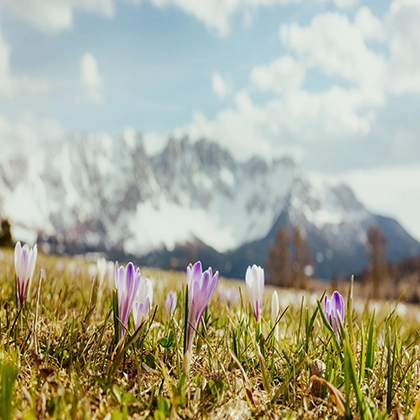
South Tyrol. Celebrating life
- Eating & Drinking
- Markets & Fairs
- Arts & Music
- Food, Wine & Tradition
- Sport events
- Guided tours
Search for places to stay
Experiences & events, from our hearts.
In South Tyrol we don't want to value anything too lightly. That's why we are responsible for our quality of life, nature, and unique products. We are driven to think outside the box and are eager to pave the way for innovation. With the passion lying in every one of us, it has all come true - because we love what we do and we do what we love.
Try it for yourself. In every experience, product and casual encounter.

Authentic flavour

Get out into nature

Cultural highlights in spring
South tyrol is....

We are South Tyrol

Arts and crafts
Getting to know inside out.
We'd like to show you how we live our life and culture. A culture that has long been shaped by German, Italian and Ladin influences. You'll get closer to South Tyrol in the blink of an eye.
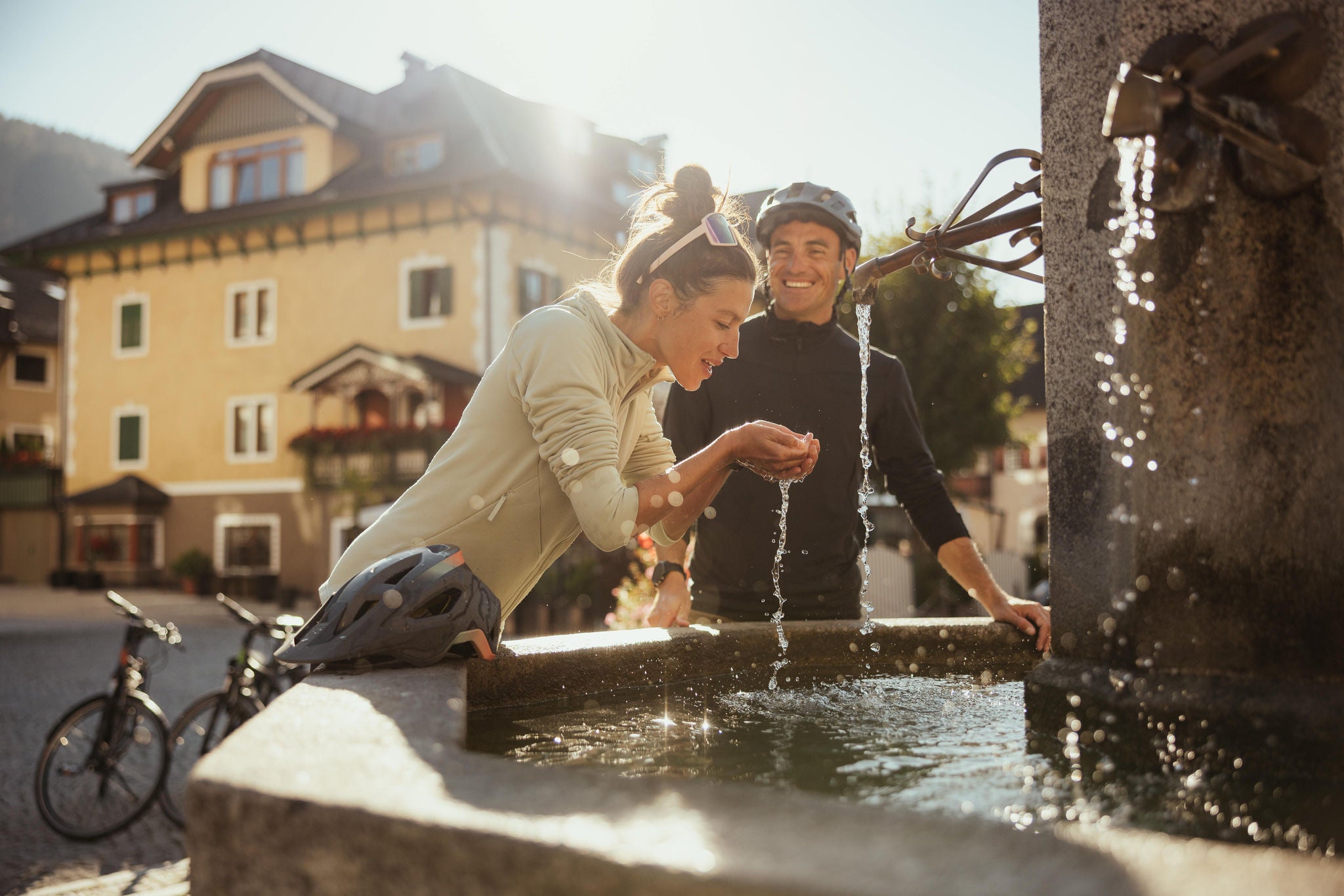
A guest in South Tyrol
Convivial, historic, in the mountains or in a wellness hotel with a sauna and infinity pool. Find the best accommodation.
Springtime experiences in Bolzano/Bozen
When snow starts to melt from mountains, the first signs of spring are easy to spot in Bolzano. March onwards, the temperatures become milder, days longer and Bolzano is in bloom. Anyone taking a walk in Bolzano wants to sit outside, at a bar located on the popular Waltherplatz square, to enjoy the delicate air of early spring with a coffee or an Italian aperitivo .
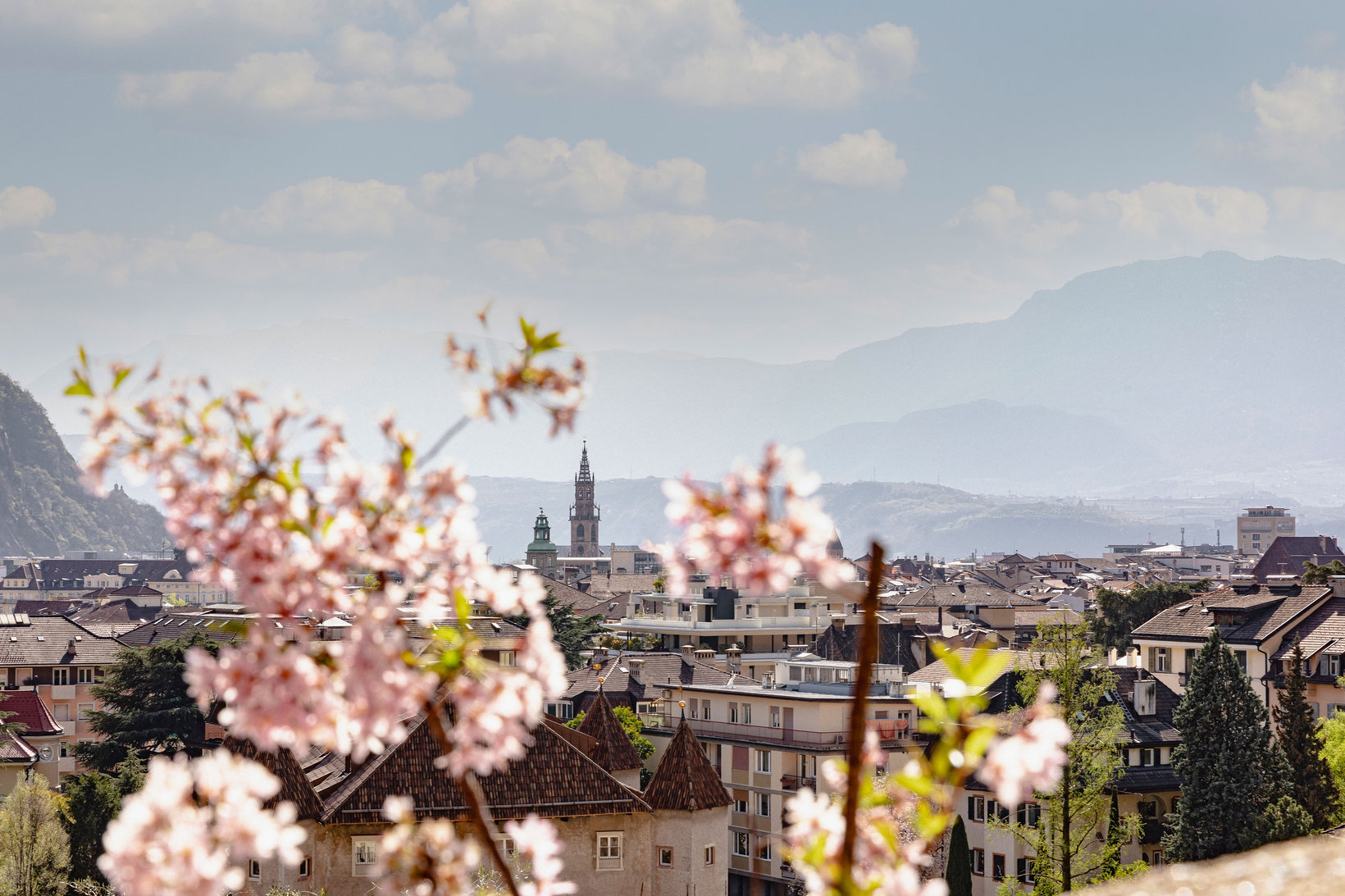
What can you experience in South Tyrol?
Draw inspiration from your stay in South Tyrol. You'll have a wide choice: quiet and active moments, winding alleys and sunny mountain slopes, products to taste and tranquil corners where to rest.

How South Tyrol cooks

Italy's most beautiful town centres

Alto Adige Wine Road

Hiking by the water

Products with quality

Awakening nature on the mountain
Spring in south tyrol.
We South Tyroleans are thrilled for the awakening of nature: we get our bikes out of the garage and plant colourful gardens. Are you a spring person too?
Your spring holiday can be as diverse as you want it to be. After putting your ski boots on, you can walk on a Waalwege canal trail past blossoming apple trees . But you can't call it a day yet. Wait until it'll be evening, and you'll be outside drinking an aperitivo in the warm spring air. Although South Tyrol is a small region, it combines at different altitudes and temperatures, urban charm and alpine silence . Come cycling , skiing , hiking or strolling. South Tyrol has it all.
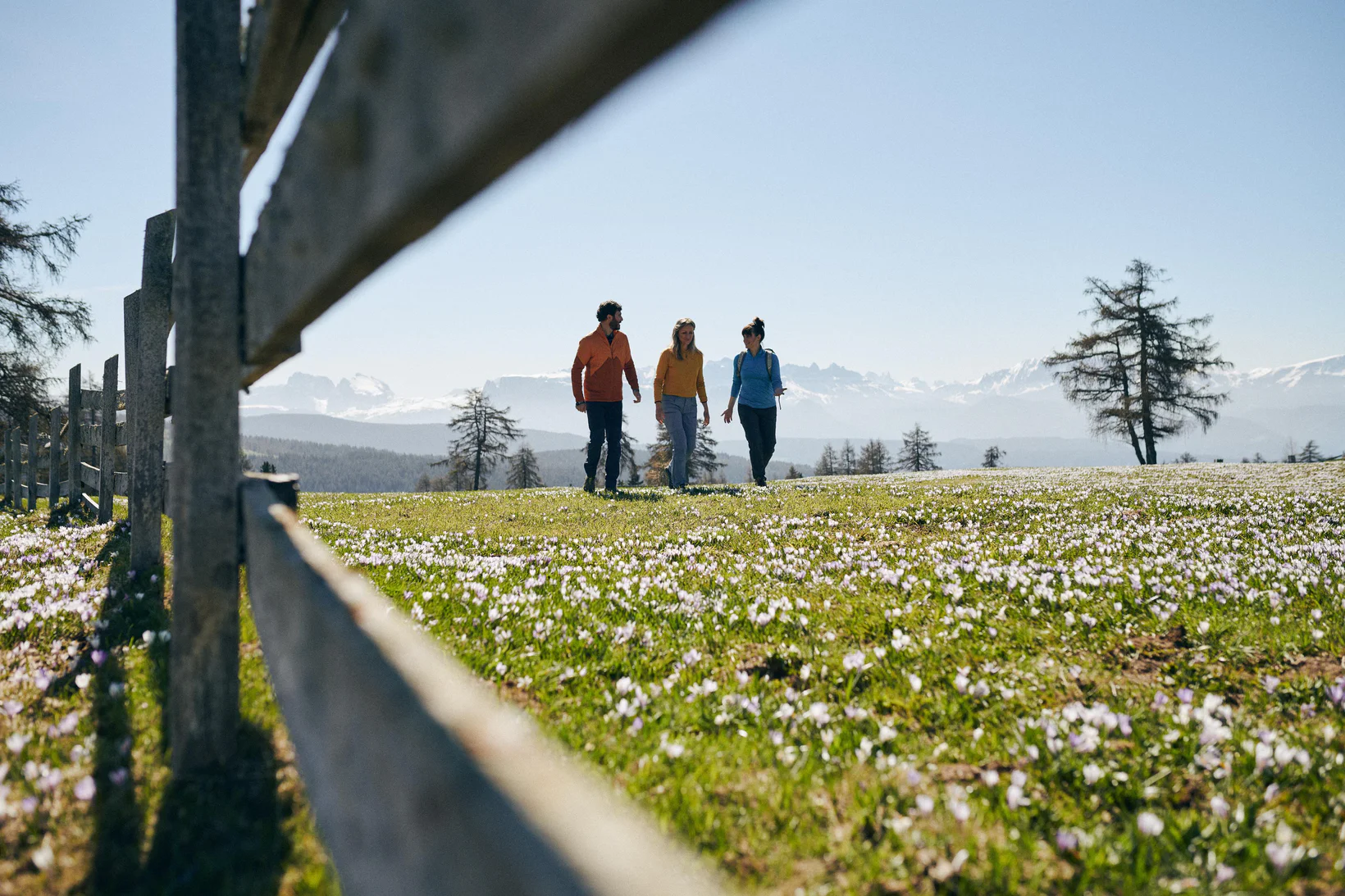
Our pioneers
A hotelier who's always seeking solutions to protect nature and a wool artist who creates unique and beautiful pieces with natural sources. What are the sources of motivation South Tyroleans tapped into?
For hotelier and head chef Hannes Rainer, nature is always at the forefront of decision-making. As a consequence, he runs his hotel Naturhotel Rainer in Jaufental/Valle di Giovo in the most sustainable manner possible.
When wool is processed, it undergoes a significant transformation at a local spinning mill nearby. Johanna Aichner’s prowess shines as she handcrafts home interior products with the finest wool, like carpets, cushion covers, and blankets.


5-day weather forecast
With the 5-weather forecast you won't let bad weather ruin your holiday in South Tyrol: that's a good way for a great planning. On a rainy day, visit a musuem or hit the slopes of a ski resort when the snow is falling down. Look at the sky clearing out and enjoy your time outside.
South Tyrol Newsletter
Join us for a fresh pack of exclusive offers, fun adventures, breathtaking views, local recipes and much more. Make the most of your vacation!
I consent to the processing of my data to receive communications in line with my interests
By clicking on the “ Subscribe to the newsletter ” button you accept the Terms and Conditions and the Privacy Policy
Confirmation email has been sent. Don't you find it? Check your spam folder.

I consent to the processing of my data to receive communications in line with my interests
By clicking on the “ Subscribe to the newsletter ” button you accept the Terms and Conditions and the Privacy Policy

Trentino alto Adige Region Italy: Map, Culture, and Cities to Visit
Trentino Alto Adige , also known as Trentino-South Tyrol or Südtirol, is an autonomous region in Northern Italy located in the Alps. The capital city is Trento , and the region covers an area of 13,607 km2 with a population of around 1.1 million. With its combination of Alpine peaks, green valleys, lakes, medieval castles, and modern cities, Trentino Alto Adige offers stunning natural scenery and a fusion of Austrian and Italian cultures. The current president of the autonomous region is Maurizio Fugatti since 2021 . The South Tyrolean People’s Party has dominated regional politics since the 1940s, reflecting the German-speaking majority in South Tyrol.
Where is Trentino region located in Italy?
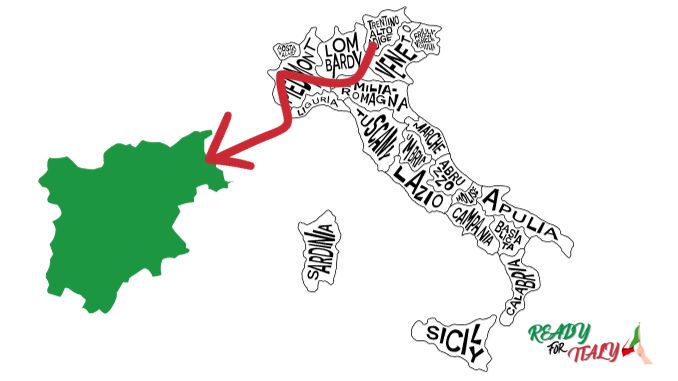
Trentino Alto Adige is situated in the northernmost part of Italy, in the central section of the Alps. It is Italy’s fifth smallest region but also one of the most culturally and geographically diverse.
To the north and east, it borders Austria, specifically the Austrian states of Tyrol and Salzburg. To the west, it borders the Swiss canton of Graubunden. Within Italy, it borders Veneto to the south, Lombardy to the southwest, and Emilia-Romagna to the west.
The northern location and extensive mountain ranges like the Dolomites isolate Trentino Alto Adige from the rest of Italy. This has allowed it to retain a distinct regional identity and culture different from other parts of Italy. Its history of rule by the Austro-Hungarian Empire and South Tyrol’s status as a majority German-speaking province give it closer ties to Austria and Switzerland.
The primary airports serving Trentino Alto Adige are Innsbruck Airport in Austria to the north and Verona Airport to the south in the Veneto region. Smaller regional airports include Bolzano Airport and Trento Airport. The region is well-connected to Italy’s railway network, with main train stations in Trento, Bolzano, and Merano. Bus networks operated by SAD, Trentino Trasporti, and SASA also connect towns and villages across steep mountain roads.
Where is South Tyrol located in Trentino, Italy?
South Tyrol, also referred to as Alto Adige in Italian or Südtirol in German, is an autonomous province in the northern part of Trentino Alto Adige bordering Austria and Switzerland.
It is Italy’s northernmost province, and the majority of its population speaks German as their first language. The capital and largest city is Bolzano, known as Bozen in German.
South Tyrol covers 7,400 km2, forming around 54% of the total land area of Trentino Alto Adige. It stretches from the peaks of the Dolomites mountain range in the east to the Ortler Alps in the west. The Adige River flows from the valley of Vinschgau/Val Venosta near the Swiss border southwest towards Bolzano.
To the north and east, South Tyrol shares an international border with Austria, in particular the Austrian state of Tyrol. To the southeast of Italy, it borders the Italian-speaking Trentino province and Belluno in the Veneto region. Trentino forms a territorial “wedge” that nearly divides South Tyrol into two separate parts.
What is the population of Trentino, Italy?
According to the latest official statistics from 2023, the total population of Trentino Alto Adige is approximately 1,075,317 people. Trentino province has around 543,450 residents, while South Tyrol province has around 549,737 residents.
The population density is quite low at 80 people per square km but unevenly distributed. While South Tyrol has a lower total population, it has a higher population density of 82 people per square km compared to 78 people per square km in Trentino. Mountain valleys and urban centers have higher densities than rural Alpine areas.
Bolzano is the largest city and provincial capital of South Tyrol, with a population of 106,107 residents within the city proper. Trento is slightly larger overall, with a municipal population of 118,046 residents.
Compared to Italy as a whole and many other regions that have recently experienced declines, Trentino Alto Adige has positive demographic growth. Its population has increased by over 5% between 2010 and 2020 due to positive natural growth and immigration. Tourism also increases seasonal populations. An estimated 11.5 million tourists visit Trentino Alto Adige each year, according to statista.com.
Map of Italy trentino alto adige
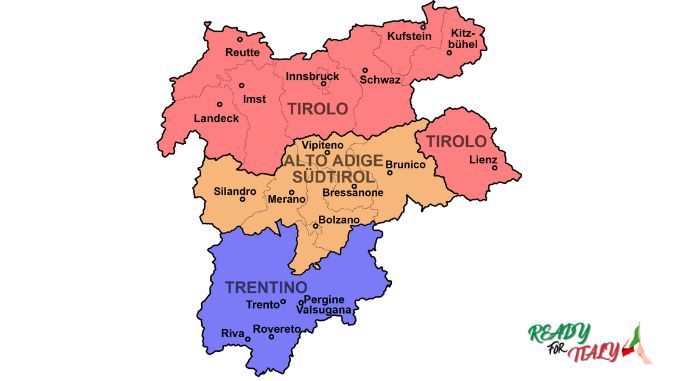
South tyrol map
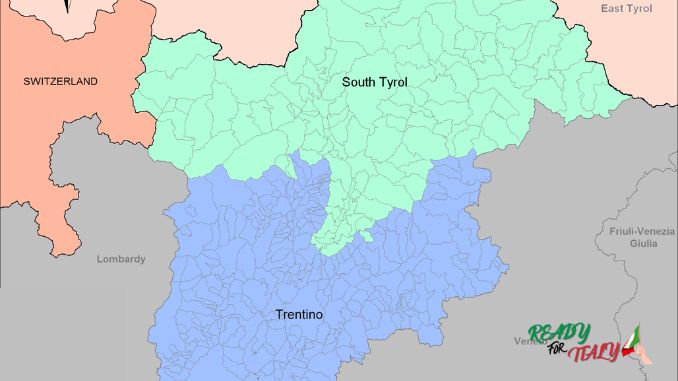
What are the Geographical features of Trentino alto Adige?
With a total area of 13,607 km2 , Trentino Alto Adige is dominated by mountains, valleys, and lakes . The varied terrain and biodiversity supports diverse ecosystems and makes it famous for outdoor tourism. Over a third of the region is protected through parks and reserves.
The most defining geographical feature is the Dolomites mountain range, part of the Southern Limestone Alps. They cover the northern and eastern sections of the region, including almost all of South Tyrol. The Dolomites are renowned for their jagged sawtooth peaks and sheer cliff faces made of pale-colored limestone and dolomite rock.
Major valleys carved between the mountain ranges include Val d’Adige, Val di Non, Val di Sole, Val d’Isarco, and Val Pusteria. These valleys provide crucial agricultural land and transportation routes to connect settlements.
Large lakes include Lake Garda, Lake Braies, and Carezza Lake. These glacial and riverine lakes located at different elevations provide habitats, drinking water, and recreation. The varied elevations, soils, and microclimates support diverse flora like mountain pines, holly, mushrooms, and wildflowers and fauna including ibex, chamois, marmot and eagles.
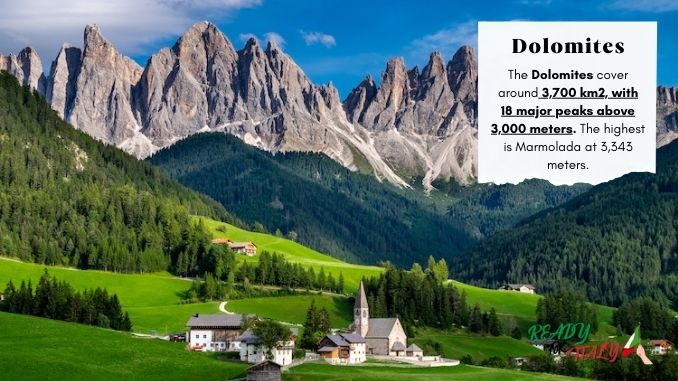
The Dolomites are a mountain range located in northeastern Italy, mainly within the provinces of Trentino Alto Adige as well as smaller sections in Veneto and Friuli. They form part of the Southern Limestone Alps and were designated a UNESCO World Heritage Site in 2009.
The Dolomites cover around 3,700 km2, with 18 major peaks above 3,000 meters . The highest is Marmolada at 3,343 meters . They were formed from coral reefs and marine life fossils dating back 200 million years ago, which were then lifted and eroded by glaciers, rivers, and weathering.
The Dolomites derive their name from the French geologist Déodat Gratet de Dolomieu, who, in the late 1700s, studied the unusual calcium magnesium carbonate rock that composes the peaks. The mineral dolomite was later named after him. The mountains display sheer vertical walls and towers with gray, pink, and pearl-colored bands.
The Dolomites provide spectacular vistas for hiking, climbing, skiing, and paragliding. Famous landmarks include the Tre Cime di Lavaredo peaks, the contorted limestone towers of the Sella Group, and the vast vertical gorge of Marmolada. The region has a high density of mountain huts, cableways, and ferrata climbing routes to experience the terrain.
What are the most Famous Cities to Visit in Trentino alto adige?
Based on visitor numbers, popularity, and attractions, some of the most famous and must-see cities to visit in Trentino Alto Adige include:
Bolzano is the capital city of South Tyrol province, with around 107,436 residents . It attracts over 2 million tourists annually who are drawn to its picturesque medieval old town, vibrant culture blending Italian and Austrian influences, fascinating museums, and surrounding scenery of vineyards and the Dolomites.
Major attractions of Bolzano include the Gothic cathedral, the archeological museum displaying the preserved body of Ötzi the Iceman, the Dominican Church, Hofburg’s former Imperial palace, the Cableway to Renon plateau, and the unique arcades and frescoes of the medieval city center. The city is bilingual in both German and Italian.
Merano is a popular spa town and health resort situated on the Adige River with around 35,119 residents . Its mild climate, gardens, castles, and spa facilities attract nearly 1 million visitors per year.
The attractions of Merano’s beautiful historical center include the Gothic St. Nicholas’ Church, the arcades of Via Portici Street, and the Thermal Baths. The surrounding region offers botanical gardens, juice groves, vineyards producing the red Teroldego wine, and mountain views, including the Tappeiner Promenade.
Trento is the capital city of Trentino province and the largest city in the region, with around 118,363 inhabitants . Set in a wide valley surrounded by vineyards and mountains, Trento combines a modern outlook with historic architecture and an ancient past.
Top attractions of Trento include the Roman ruins, medieval Castello del Buonconsiglio fortress, Cathedral of San Vigilio, frescoed historic palaces, and museums displaying antiquities, alpine archaeology, and art. Within the city are walking trails along the Fersina Creek and up to hilltop viewpoints. Trento sees around 750,000 tourists every year.
Rovereto is a small city with around 37,549 residents located 20 km south of Trento. It receives around 750,000 visitors annually drawn to its compact historic center, important museums, and surrounding scenery.
Places to see include the bell tower Torre Civica, Museo della Guerra detailing World War 1 history, Depero Futurist House museum, and Venetian palaces. The nearby hills and Lake Garda provide a beautiful setting for cycling, walking, and relaxing in cafes.
Bressanone, also called Brixen in German, is a picturesque town of around 22,728 inhabitants in South Tyrol along the Isarco River. With around 1 million annual visitors, its main attractions are the beautiful medieval facades, Baroque cathedral and cloister, Hofburg palace, and mountaineering museum.
The Alpine town is surrounded by vineyards and orchards in the valleys leading up to the imposing Dolomites peaks. Bressanone has an important artistic and cultural heritage in its churches, musical history, and frescoes. It hosts regular festivals, concerts, and markets in its atmospheric cobblestone streets.
Brunico is a charming historical town of around 16,978 inhabitants located 40 km northeast of Bolzano in South Tyrol. Surrounded by the majestic mountains of the Pustertal Valley, Brunico sees around 250,000 visitors annually.
The quaint medieval quarter is still surrounded by ancient city walls and watchtowers. Sights include the fortress-like Prince’s Palace, frescoed houses, Gothic churches with ornate carvings, and views of the mountains. The town serves as a gateway to the Val Pusteria and Dolomites for hiking, cycling, and winter sports.
Canazei is a scenic mountain town of under 5,000 inhabitants situated at 1,450 meters elevation in the heart of the Dolomites range. Surrounded by incredible views and ski slopes, it is a popular base for hiking, climbing, and skiing.
This tourist destination in the Fassa Valley receives around 500,000 annual visitors attracted by the Alpine ambiance, shops, restaurants, and easy access to lifts ascending the Sella, Marmolada, and Pordoi massifs. Activities include mountain biking, rock climbing, downhill skiing, and après ski.
Malè is a small alpine town of around 4,800 inhabitants located in the upper Val di Sole at an altitude of 850 meters. Set within the Brenta Dolomites peaks, it serves as a hub for outdoor sports, receiving about 500,000 tourists annually.
Attractions include its pretty historic stone houses and churches framed by mountain views. In winter, Malè is a center for skiing areas like Madonna di Campiglio via cable car access. Other activities include hiking, mountain biking, rafting, paragliding, horseback riding, and rock climbing.
What are the safest cities in Trentino alto adige?
Some of the top safest cities and towns to live in Trentino Alto Adige , according to crime statistics and safety indexes, of italy istat, include:
- Rovereto – Has the lowest crime rate in the region, and only 58 crimes reported per 10,000 population.
- Arco – Historic lake town with extremely low crime due to its small population of 16,000.
- Cavalese – Small medieval village popular with climbers and very safe.
- Cles – A rural town of 7,000 people situated in the valleys of Western Trentino.
- Pergine Valsugana – Provincial town with only 63 crimes per 10,000 inhabitants.
- Mezzocorona – Vineyard town near Trento with hardly any crime.
- Levico Terme – Popular spa town and one of Italy’s safest municipalities.
- Mezzolombardo – Agricultural and industrial town near Trento with few crime incidents.
These rural towns and small cities all report very little violent crime and benefit from strong community ties, engaged local police, low unemployment, and tourists who deter opportunistic crimes. They offer safety and a high quality of life.
What are the most dangerous cities in Trentino Alto Adige to Visit?
While Trentino Alto Adige has an overall low crime rate compared to other parts of Italy, the most dangerous cities to visit based on slightly higher reports of petty theft include:
- Bolzano – The capital city sees more pickpocketing and backpack thefts due to high volumes of tourists, especially around the train station. Still enjoys low violent crime.
- Trento – Has experienced some petty crimes in crowded tourist sites. Remains very safe by European standards, with 130 crimes per 10,000 people.
- Merano – Spa town has seen minor theft targeting tourists—very limited violent offenses.
- Riva del Garda – A busy lakeside town has pockets of opportunistic tourist theft. Few violent crimes occur.
These cities attract millions of visitors yearly, so petty theft is more likely to occur at crowded sites, transportation hubs, and nightlife areas. Violent crime rates are still extremely low. Exercising basic street smarts will minimize risks. Smaller towns and rural areas have negligible crime rates.
What is the Best Time to Visit Trentino Alto Adige Region in Italy?
The best time to visit Trentino Alto Adige depends on the type of trip, activities, and weather conditions sought:
Summer (June-August)
Summertime brings warm, sunny days perfect for hiking through alpine valleys and wildflower meadows. Mountain hut restaurants and towns are lively with cultural events. Daytime temperatures average 20-30°C, but it cools at night. Thunderstorms can occur. Prime season leads to higher accommodation prices.
Fall ( September-October)
Fall offers beautiful scenery as larch and deciduous trees turn golden colors. Days are sunny and mild, while nights are cool. Temperatures average 15-20°C. It’s ideal for harvest festivals, mushroom foraging, mountain sports before winter, and fewer crowds.
Winter (November-March)
The coldest months offer snow-covered landscapes perfect for skiing the slopes of hundreds of resorts, going on snowshoe walks, and Christmas markets. Average temperatures are below freezing, but sunny days can warm up. Expect cold nights below -10°C at higher elevations.
Spring (April-May)
In spring , wildflowers bloom as mountain valleys thaw and temperatures climb to 10-15°C on average. Melting snow swells rivers for whitewater rafting. Spring is great for hiking, biking, rock climbing before peak season, and seeing baby animals.
At higher mountain elevations, temperatures can be 10-15°C colder than valleys year-round. The region experiences some regional climatic variation. Inner valleys like Vinschgau are dry, while mountain areas get more rain and snowfall.
What is the traditional food of Trentino alto Adige?
The cuisine of Trentino Alto Adige combines the hearty, meaty dishes of Austria and northern Italy with local Tyrolean and alpine specialties using fresh regional produce. Some traditional and specialty foods include:
- – Speck – Smoked and salted ham, especially South Tyrolean Speck Alto Adige PGI.
- – Canederli – Flour, egg, cheese, and bread dumplings, often served in broth.
- – Strangolapreti – Spinach and bread dough dumplings similar to gnocchi.
- – Carne salada – Salted and cured beef, especially from cows in Val di Non.
- – Polenta – Cornmeal boiled into thick porridge and topped with stew or cheese.
- – Spätzle – Little hand rolled or pressed egg noodles.
- – Knödel – Bread or potato dumplings served in soup or with meat.
- – Goulash – Spicy beef stew seasoned with paprika.
- – Saurkraut – Finely shredded and fermented cabbage.
- – Sachertorte – Chocolate cake with apricot jam filling.
- – Kaiserschmarrn – Shredded pancake with raisins, often served for dessert.
- – Apple strudel – Flaky pastry with apple filling.
Traditional restaurants can be found across cities and villages. Farmhouse inns called Maso serve hearty meals. The region produces quality cold cuts, cheeses like Asiago, and beer like the Forst brand.
What are the most famous Trentino alto adige wine brands?
Trentino Alto Adige produces some of Italy’s most acclaimed white wines and sparkling wines due to the Alpine climate, high elevations, and mix of volcanic and glacial soils. Some notable labels include:
- Cantina Ferrari – The most eminent Trentodoc sparkling wine producer. Their vintage bottles are Italy’s answer to French Champagne using chardonnay and Pinot Nero.
- Alois Lageder – Biodynamic winemaker in Alto Adige known for layered whites like Pinot Grigio and Gewurztraminer from single vineyards.
- Foradori – Visionary winemaker Elisabetta Foradori makes terroir-driven reds like Teroldego and whites. Based in Trentino.
- Girlan – Specializes in elegant Pinot Nero and Chardonnay wines grown on the steep slopes around Lake Caldaro.
- Elena Walch – Major exporter crafting bold native and international varietals like Lagrein, Pinot Grigio, and Beyond the Clouds blend.
- Cantine Terlano is a prestigious producer of white wines located in the town of Terlano in South Tyrol, Alto Adige. It is a cooperative winery founded in 1893, representing 150 locals.
- Terlano vineyards- Terlano focuses on single-variety white wines that express the Alpine terroir. Their flagship wines are made from Pinot Bianco, Chardonnay, and Sauvignon Blanc. These whites are known for their elegance, complexity, and minerality from the porphyry, gravel, and clay soils.
- Pojer & Sandri – Traditional sparkling wines made using méthode Classico from cool climate vines around San Michele Appiano.
- Franz Haas – Prestigious Schiava, Lagrein, Pinot Nero, and Moscato from Alto Adige vineyards since 1880.
- Cantina Andriano – Quality co-op making expressive wines like Pinot Grigio and Nosiola from Trentino vineyards.
- Castel Sallegg – Historic estate in Caldaro producing mineral-driven Pinot Bianco, Pinot Grigio, and Sauvignon.
- Cantina Tramin – Top co-op crafting terroir-expressive single vineyard Gewurztraminer in Alto Adige.
The wines are noted for vibrancy, complexity, minerality, and precision, expressing the Alpine terroir. Many wineries emphasize sustainable practices and terroir integrity. The region combines winemaking tradition with innovation.
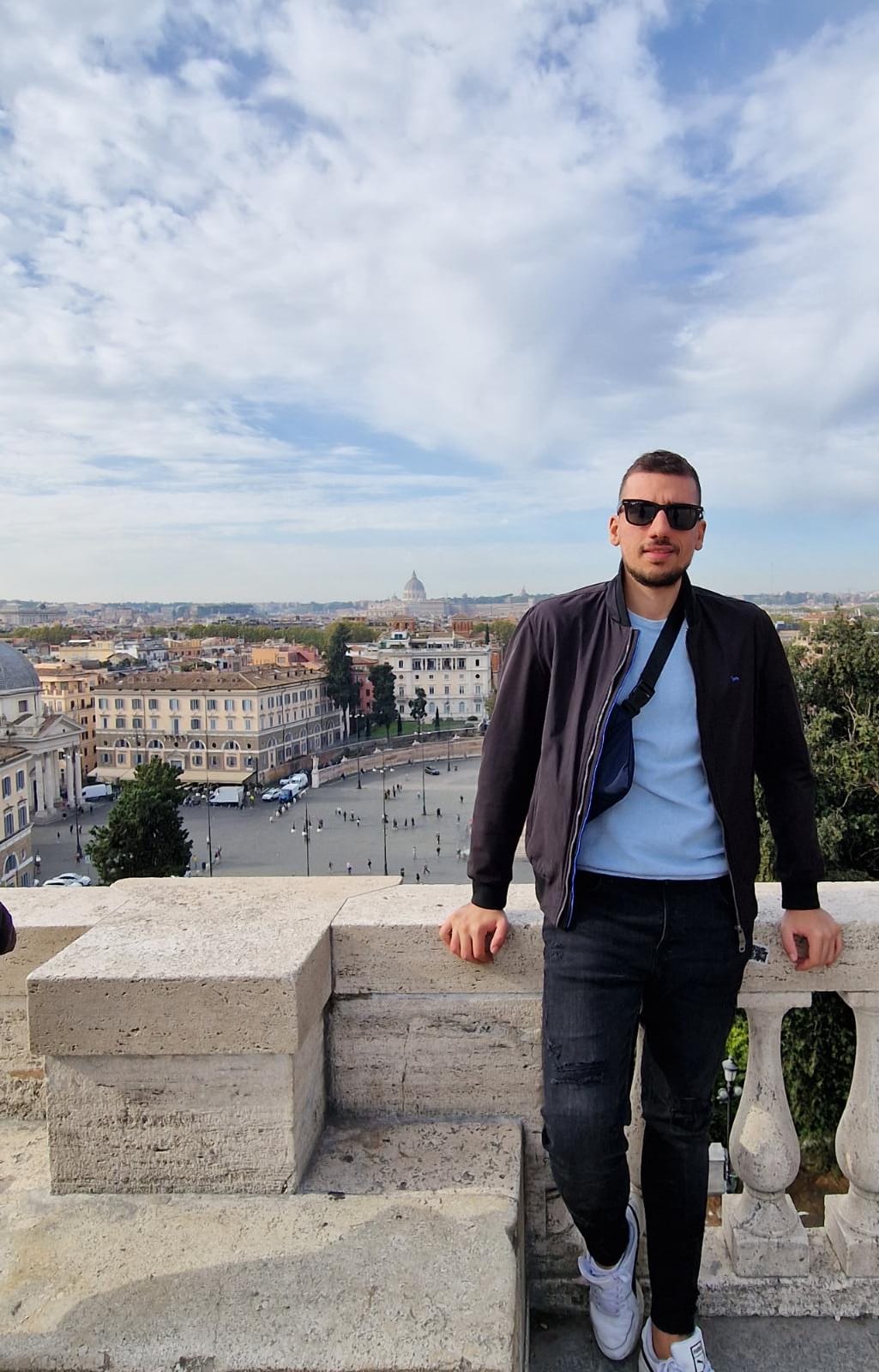
Hey, I’m Giovanni, an Italian that lives in Italy and the author of this website! I started this website because I like to travel, discover new places and share my knowledge about Italy with more people worldwide. I love writing about everything regarding Italy, its culture, history, and lifestyle. I hope you found value in whatever article you read, and if you have any remaining questions, don’t hesitate to contact me!
THE 10 BEST Trentino-Alto Adige Sights & Historical Landmarks
Trentino-alto adige landmarks.
- Churches & Cathedrals
- Points of Interest & Landmarks
- Architectural Buildings
- Historic Sites
- 5.0 of 5 bubbles
- 4.0 of 5 bubbles & up
- 3.0 of 5 bubbles & up
- 2.0 of 5 bubbles & up
- Budget-friendly
- Good for Kids
- Good for Big Groups
- Good for Couples
- Good for a Rainy Day
- Honeymoon spot
- Hidden Gems
- Good for Adrenaline Seekers
- Adventurous
- Things to do ranked using Tripadvisor data including reviews, ratings, photos, and popularity.
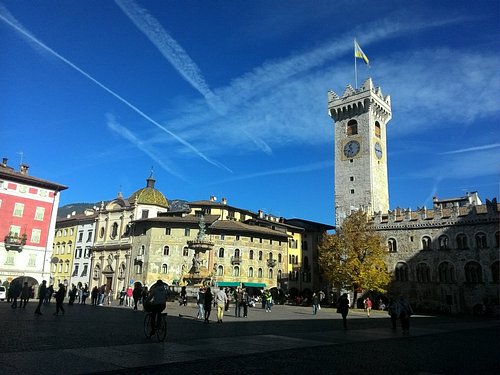
1. Piazza Duomo

2. Castello del Buonconsiglio Monumenti e Collezioni Provinciali
Recommended Sightseeing Experiences (82)
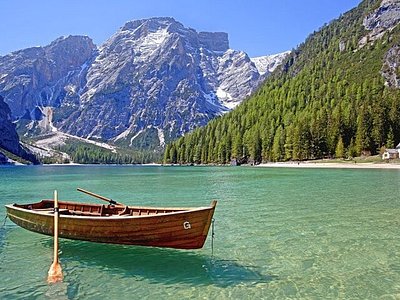
3. Old Ponale Road Path

4. Santuario di San Romedio
5. Merano Centro Storico
6. Lago di Tovel

7. Passo Sella

8. Funivia Pass Pordoi
9. Castel Thun

10. Castel Beseno
11. Lago di Resia
12. Piazza Walther
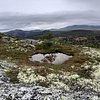

13. The Bastion
14. Maso Guez

15. Ortisei: Zona Pedonale
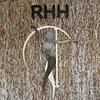
16. Lago DI Levico
17. Duomo di Bressanone
18. Bunker H
19. Medieval Village of Canale
20. Sentiero Viel del Pan
21. Chapel Santa Barbara
22. Col Rodella
23. Museo Storico Italiano della Guerra
24. Malga Fane

25. Passo San Pellegrino

26. La Terrazza delle Dolomiti
27. Castello di Taufers

28. Sentiero panoramico Busatte Tempesta
29. Abbazia di Novacella
30. Südtiroler Volkskundemuseum / Museo degli usi e costumi

What travelers are saying

- Guided tour of the interior in German
- Guided tour of the interior in Italian
- Visita guidata dell'interno in lingua italiana
- La Terrazza delle Dolomiti
- Cima Paganella
- Südtiroler Volkskundemuseum / Museo degli usi e costumi
- Passo Sella
- Santuario di San Romedio
- Funivia Pass Pordoi
- Chapel Santa Barbara
- Castel Beseno
- Old Ponale Road Path
- Gardena Pass

- What to do in Trentino Alto Adige: 10 unmissable places
- Places and Tours
The natural and artistic beauties of Trentino are unlimited. Discover with Visititaly ten unmissable places in this beautiful region

Trentino is rich in history and culture, and to discover all its beauty we have selected for you ten unmissable places that you must visit. Through its hidden valleys and small Alpine villages, you will immerse yourself in a magical place where nature, culture and history come together to convey an unforgettable experience.
Visiting Trentino allows you to enjoy many activities, such as trekking, cycling, and walking. You can spend a pleasant holiday discovering historical and fascinating places, giving you moments of peace and relaxation. Let's start the journey to discover our ten unmissable places in Trentino !
Discover Trentino in ten unmissable places

Each region has its own special features and beauty. Trentino offers magnificent experiences for an unforgettable weekend or holiday that will make you discover an area rich in history, beauty and culture. The lakes, mountains and activities to be practised can satisfy families, young people and experienced sportsmen seeking new challenges . But don't forget the cuisine of Trentino: the Italian culinary art has a thousand facets and here too you will find one more reason to appreciate what nature has to offer. Here are ten unmissable places in Trentino that you must know!
10. The city of Trento

Trento has a special history, made up of clashes for its dominance. A city with Roman origins, today it is a city rich in historical evidence and, at the same time, guardian of breathtaking natural beauty. It is one of ten unmissable places in Trentino to visit, to understand the historicity of these places . The Cathedral of San Virgilio overlooks Trento's main square and is dedicated to the city's patron saint. Over the centuries, the structure has undergone numerous modifications and additions. Today, it is a building in which Gothic and Baroque elements harmonise perfectly. Buonconsiglio Castle, together with other buildings, constitutes one of the most important museum centres in the whole of Trentino Alto Adige. It houses rich collections of works of art that tell the story of Trento's culture and art .

9. Monte Bondone

Monte Bondone, which can be easily reached from the city of Trento by skibus and public transport, is dotted with numerous beautiful trails immersed in alpine nature. From here, suggestive views can be admired, such as the three peaks Cornet, Dos d'Abramo and Cima Verde. This area is home to the Integral Nature Reserve and the Alpine Botanical Garden , which protect around two thousand varieties of plants and flowers. The mountain also has a rich offer of activities to do, both in winter and summer. Ski slopes, skating rinks, mountain biking and hiking, horse riding, paragliding, hang gliding: there is something for everyone! A true active holiday experience in Trentino , one of the ten places not to be missed in terms of nature.

8. The Brenta Dolomites

Included in the Adamello-Brenta Natural Park , the Brenta Dolomites are the only Dolomite group located west of the Adige River. Here you will find enchanted places, where silence becomes music. It is no coincidence that the Brenta Dolomites are often chosen as the backdrop for I Suoni delle Dolomiti (Sounds of the Dolomites), the high-altitude music festival that, every summer, features performances by musicians immersed in the majestic natural landscape. The echo of silence blends with the music, providing a highly evocative experience. We also recommend seeing the majestic Lake Tovel , where the crystal-clear water reflects the magnificent smooth dolomite walls, typical of the area. The lake is a popular destination for skiers, mountaineers and hikers. One of the main tourist resorts in the area, Madonna di Campiglio , has countless hiking trails. Among the most popular is the low-altitude itinerary, suitable for families and children, to the beautiful Vallesinella waterfalls, completely immersed in the deep green woods of the Adamello-Brenta Natural Park.
7. Val di Fassa, terrace of the Dolomites

The Val di Fassa is one of the most characteristic of the Dolomites. It contains numerous natural terraces from where it is possible to admire the spectacle of the enrosadira, a natural phenomenon due to the chemical constitution of the Dolomites (mainly magnesium and calcium carbonate) that makes the rocky walls particularly capable of reflecting sunlight. At every sunset and sunrise, in fact, the peaks of the Dolomites are tinged with a strong pink, orange and violet colour. The Punto Panoramico Sass Pordoi , at the Pordoi Pass, allows visitors to enjoy this wonderful colour spectacle. Here is the famous Terrace of the Dolomites, at an altitude of 2950 metres. You will feel as if you are one step away from heaven!
6. Moena and the green tourism

Moena is the largest town in the Val di Fassa and is known throughout the world as the Fairy of the Dolomites, underlining the attractiveness of its landscape. In recent years, Moena has become part of the Alpine Pearls, an association founded by Alpine tourist resorts to promote sustainable tourism. The village is very elegant and it is possible to do some classy shopping among the finest shops. In winter, Moena seems like an enchanted village: the snow-covered town centre transports you into a very captivating atmosphere. In summer, on the other hand, the village lends itself as a destination for long walks in nature, either on foot or by bicycle. It is the ideal destination for an ecological holiday, without the use of cars, in favour of sustainable mobility. In fact, the use of e-bikes and a small train that runs through all the village streets is encouraged.
5. The castles of Val di Non

In Trentino you can find many castles, Val di Non has the most and is on our list of ten unmissable places . Visiting them is a great emotion, talking to the owners is an unforgettable experience. The first to open to the public was Thun Castle and this gave a hint to the others. Not all of them are in optimal condition for a tour, but in the inhabited ones you will be able to breathe in the air of nobility that characterises them and see with your own eyes some details of the era in which they were built.
4. Lake Molveno

It is difficult to recommend just one lake in Trentino, but Lake Molveno is certainly among the most popular. What tourists like about it is not only its physical beauty, but the services it offers and the efficient organisation that makes it possible to enjoy a wonderful holiday here. Families will find meadows and beaches, and sportsmen and women can enjoy a variety of activities that satisfy everyone in the various seasons of the year. Excellent reasons to organise a holiday at Lake Molveno.
3. Village of Rango

It is considered one of the most beautiful villages in Italy. It still retains the charm of a mountain village, both in the architecture of things and in the layout of the streets. In the past, it was located on the imperial road that led from Lake Garda to Val di Sole. Strolling through the streets, you can admire numerous wooden statues.
2. The Peace Trail

The Sentiero della Pace (Peace Trail) is a route that connects several historical sites on the Italian-Austrian front relating to the First World War. It stretches from the Stelvio to the Marmolada and includes glaciated stretches, some snow-covered, and others at lower altitudes. In many sections it can be walked without being an experienced mountaineer, and the various trails are well signposted and constantly maintained. The spirituality of the route, combined with the mountain scenery, provides a great sense of peace and well-being.
1. Riva del Garda

A small part of Lake Garda is part of Trentino and offers many possibilities for recreation. Trekking trails, cycling paths and beaches to enjoy a relaxing break. Riva del Garda is worth at least a walk, to visit the beautiful old town centre and a lakeside promenade that offers an atmospheric spectacle with the wonderful colour nuances of the water. A bicycle tour along Lake Garda will let you discover fascinating views!
Discover 10 unmissable places to fall in love with Trentino

The ten unmissable places we suggest to discover Trentino have an undeniable charm. This region leaves beautiful memories for people who decide to visit it. Each stay will give you new ideas to return and enjoy unforgettable moments.
We recommend

Expedia Rewards is now One Key™
Trentino-alto adige.

Trentino-Alto Adige is an enchanting Italian region with romantic-looking castles, steep mountain peaks and relaxing spa towns. Austria and Switzerland border Trentino-Alto Adige to the north, making it a grand entrance to the rest of Italy. Race down the slopes at an alpine ski resort, go trekking along remote nature trails and enjoy the social scene in mountain villages.
Explore the Dolomites, a scenic mountain range with snow-capped peaks, dense woods and streams that cut through the landscape. Ski or snowboard your way through winter resorts such as Madonna di Campiglio and Selva Val Gardena. After days on the slopes, head into the villages in the evening for classic Italian cuisine and late-night cocktails.
In the warmer months, enjoy miles of hiking trails in Stelvio National Park. Wander through the historic Sentiero della Pace (Path of Peace), which follows important sites of the front line in World War I. Look for Golden Delicious apples growing along the Apple Trail in the Val di Non.
Castles in stunning settings provide impressive views across the region. Go to Beseno Castle, an imposing fortress that towers over the Adige Valley, and enjoy cultural reenactments and interactive activities suitable for the entire family. Other must-visit castles include Tirolo, Roncolo and Appiano.
Trentino-Alto Adige’s towns are packed with art and history. Visit Trento to see Buonconsiglio Castle and a beautiful Romanesque cathedral. Meander through the narrow streets of Bolzano, where pastel-colored terraced houses overlook the Piazza del Municipio. War history is a popular subject in Roverto. The topic is especially well-covered in the War History Museum and at Dante Castle’s Military Memorial.
For a scenic arrival, travel by train to either Trento or Rovereto. The region is a 1- to 2-hour drive or shuttle bus from surrounding airports. Once in Trentino, continue driving on the well-maintained roads or make use of local buses and trains.
Come and see why Trentino-Alto Adige is a popular skiing and hiking destination for travelers looking to be enchanted by Northern Italy’s stunning landscapes.
Cities in Trentino-Alto Adige

Riva del Garda

Selva di Val Gardena

Nago-Torbole

Corvara in Badia
- Other Cities in Trentino-Alto Adige

6 Reasons to Visit the Region of Trentino-Alto Adige in Italy
The region of Trentino Alto Adige is not along the typical tourist route when planning a trip to Italy. However, Trentino Alto Adige is an incredible place in northern Italy to visit. Perfect in winter and summer, stunning natural landscapes and a blend of Italian and Austrian heritage await!
In Trentino Italy, you’ll have the opportunity to experience scenic towns and villages, lush valleys, historic castles, delicious local cuisine, and, of course, the dramatic mountain peaks of the Dolomites.
In this article, let’s uncover the top 6 reasons why you need to visit Trentino!
Where is Trentino-Alto Adige?
The Trentino-Alto Adige region is located in Italy’s northeastern mountainous region. In fact, it’s the northernmost region of Italy.
It’s just south of Austria and to the east of Switzerland and the northern Italian regions of Lombardy and Veneto are along the region’s southern border. The region is defined by the high, chiseled, limestone peaks of the Dolomites and the stunning valleys, alpine meadows, forests, and turquoise mountain lakes that lie in and around them. This Trentino-Alto Adige map provides a birds-eye view to orient yourself to exactly where this area is in relation to the other regions of northern Italy.
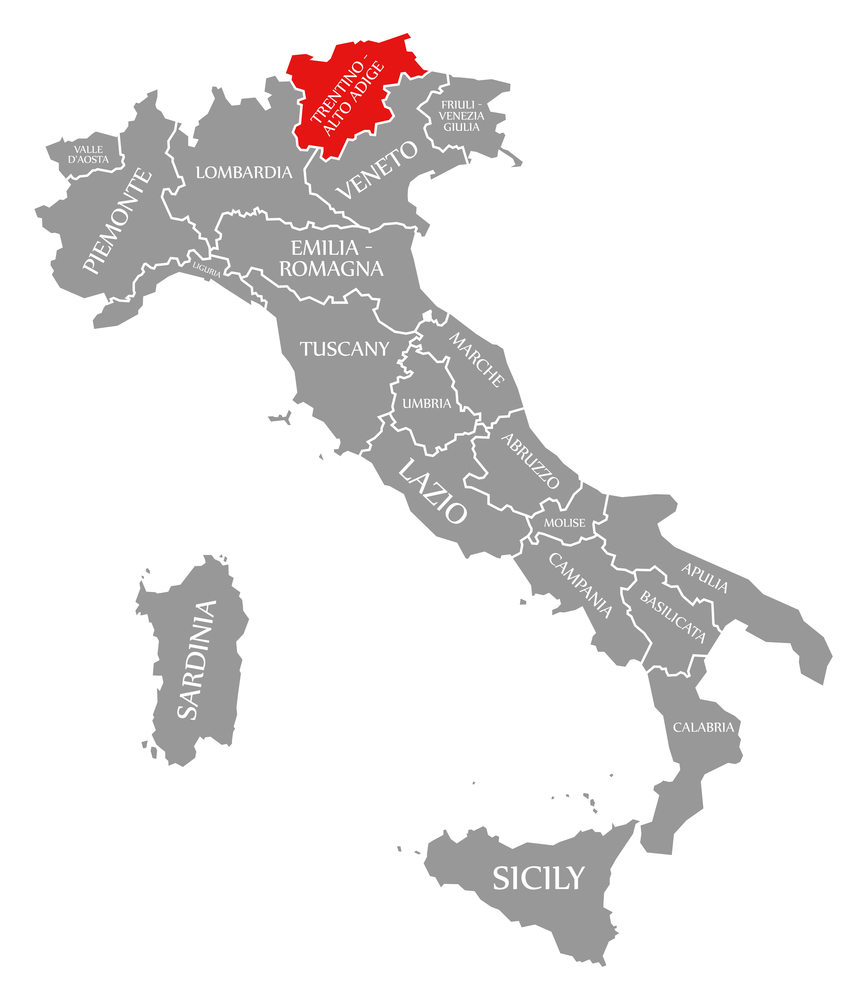
It’s an autonomous region of Italy and is split into 2 provinces. Trentino covers the southern area of the region and is known as the province of Trento. While the area closest to Austria, Bolzano province, is known as South Tyrol in English or Alto Adige, the Italian name. You may also see the German name, Südtirol, which is referring to the same area.
So to be clear, South Tyrol is in Italy, geographically speaking. However, there is a strong Austrian/German influence throughout the region. South Tyrol was actually part of the Austrian Empire until after the first World War when the region was annexed to Italy. And as you travel throughout the region, you’ll notice many places have 2 different names, one in Italian and the other in German.
If you’re a little confused by the different languages, don’t worry! I was, too, when I first spent time traveling throughout the region of Trentino-South Tyrol.
The map of Trentino-Alto Adige below shows in greater detail where the region’s cities and towns are in relation to one another. Trento and Bolzano are the region’s biggest cities and gateways to the unparalleled UNESCO World Heritage Site, the Dolomite Mountains.
For a fuller look at the north of Italy, take a look at this map to orient yourself.
6 Top Reasons to Visit Trentino Alto Adige
A trip to Trentino, as Italians call the region, will take you to a unique and awe-inspiring area of northern Italy! Trentino is important for its cultural heritage, with the region being home to a number of charming castles and historic towns. But it’s also impossible to ignore the magnificent 360° panoramic natural landscapes.
Trentino is for you whether you’re looking to have an outdoor adventure, discover the history and blended culture of the region, drive the winding roads for an epically beautiful road trip, or just settle in among the green valleys and mountains for total rejuvenation.
1. The Dolomite Mountains Dominate the Region of Trentino-Alto Adige.
If I could only give you 1 amazing reason to visit Trentino, it would be the spectacular Dolomite Mountains. Quite simply, they will take your breath away!
The Dolomites, with their snowcapped peaks and dizzying slopes, are a UNESCO Natural Heritage site . The surreal mountain landscape is perfect for outdoor activities and sports all year round. From late spring when the wildflowers bloom to the golden yellow landscape of early fall, there are hundreds of open trails where you can hike and trek, no matter your ability level. The trails lead you through verdant forests, past alpine lakes, and to remote villages and rifugios (mountain huts).
If you prefer, hop on a mountain bike (or e-bike) and ride to the towering summits for some of the most unforgettable views you will ever see! Trentino is a dream for cyclists. In fact, the Giro d’Italia, Italy’s biggest cycling race, goes through the Dolomites.
The Val Gardena and its main village Ortisei, as well as the Cortina D’Ampezzo area, are ideal as a base for any season in the Italian Alps. Ortisei also offers non-hikers the chance to go up into the mountains via the Seceda Cable Car and the Alpe di Siusi/Seisler Alm Cable Car. Both are easily walkable from the heart of Ortisei and whisk riders up to mountain restaurants and hiking trails. Regardless of your plan at the top, the views are epic and shouldn’t be missed!
If you’re planning to visit Trentino in winter, there’s nothing better than skiing in the Dolomites for endless winter thrills! Ski resorts dot the area from Ortisei to Cortina, catering to a range of ability levels. After descending the mountain slopes on skis or by snowboard, take a break in a cozy alpine hut for a traditional meal.
Non-skiers can enjoy winter activities like fat biking, snowshoeing, and sledding all while still experiencing the incredible mountain vistas.
2. Trentino’s Lakes and Valleys
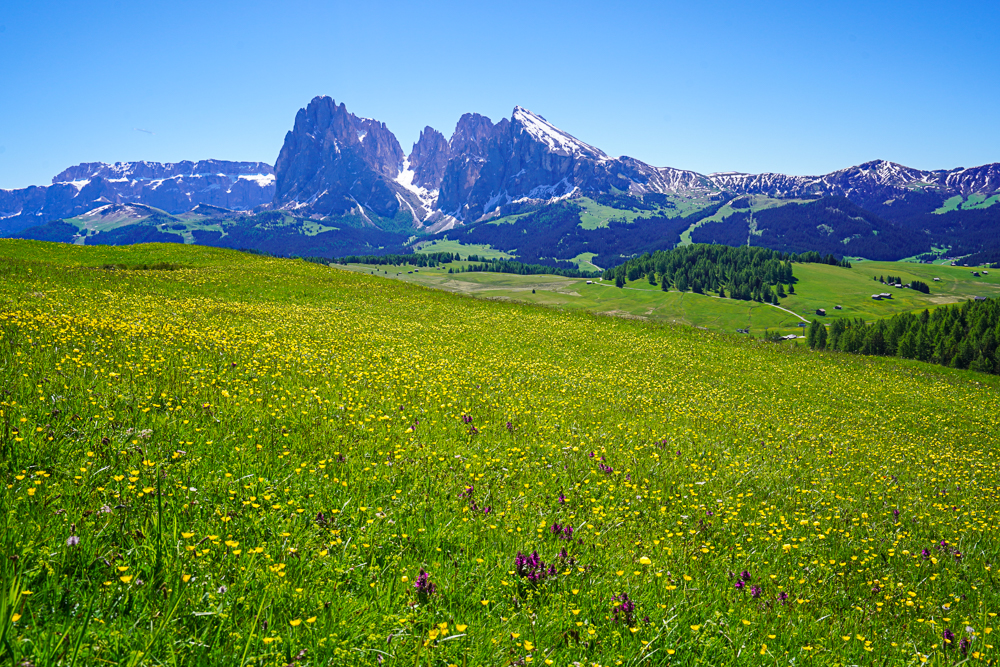
Trentino’s spectacular mountain landscape offers much more than peaks and slopes. Grassy meadows awash in white, purple, and yellow wildflowers and alpine lakes are everywhere in the Trentino region, and are among the top things to see and experience in the Dolomites!
Trentino’s territory includes an array of 297 gorgeous lakes in every shade of blue and green you can imagine.
The most well-known is Lago di Garda, or Lake Garda, Italy’s biggest lake. The northern tip of Lake Garda is in Trentino-Alto Adige, while the rest is split between Lombardy and the Veneto region.
Lake Garda is a popular destination for water sports lovers! If you’re into sailing, windsurfing, kayaking, or even cycling and hiking, you’ll have a blast visiting Lake Garda’s shores in the summertime. Lake Garda is also home to beautiful towns along its shores where you’ll find lakeside beaches, stunning castles, and hidden-gem historical sites.
Two other renowned lakes in the region are Lake Ledro, legendary for its crystal-clear waters and prehistoric stilt dwellings, and Lake Molveno, right next to the Brenta Dolomites, which has been been awarded the title of the most beautiful lake in Italy several times.
Lake Braies (Lago di Braies or Pragser Wildsee in German) is further north in the South Tyrol (Alto Adige) area. The lake’s pristine aquamarine water and surrounding mountain peaks have made it Insta-famous.
Besides lakes, Trentino has plenty of peaceful, postcard-perfect valleys and expansive pastures to explore. Val Gardena is one of the most popular valleys in the region. In the Val Gardena, you can enjoy a multitude of outdoor activities, relax in the silence of nature, and discover little villages where the local communities embrace their ancient heritage. From the town of Ortisei, ride the funicular up to Alpe di Siusi/Seisler Alm to see Europe’s largest Alpine meadow.
Another amazing valley to check out is the Val di Sole, where you can hike in the incredible Stelvio National Park. The Noce River, revered for its thrilling white water rafting, flows through the national park.
Val di Non is a valley located northwest of the city of Trento. It’s often overlooked by travelers in favor of the Val Gardena. But for those who do travel this way, gorgeous vistas and tiny towns await, all away from the well-trodden tourist path. There are so many things to uncover in the Val di Non including the beautiful Lake Santa Giustina, castles from a bygone era, caves, and canyons.
3. Historic Medieval Castles
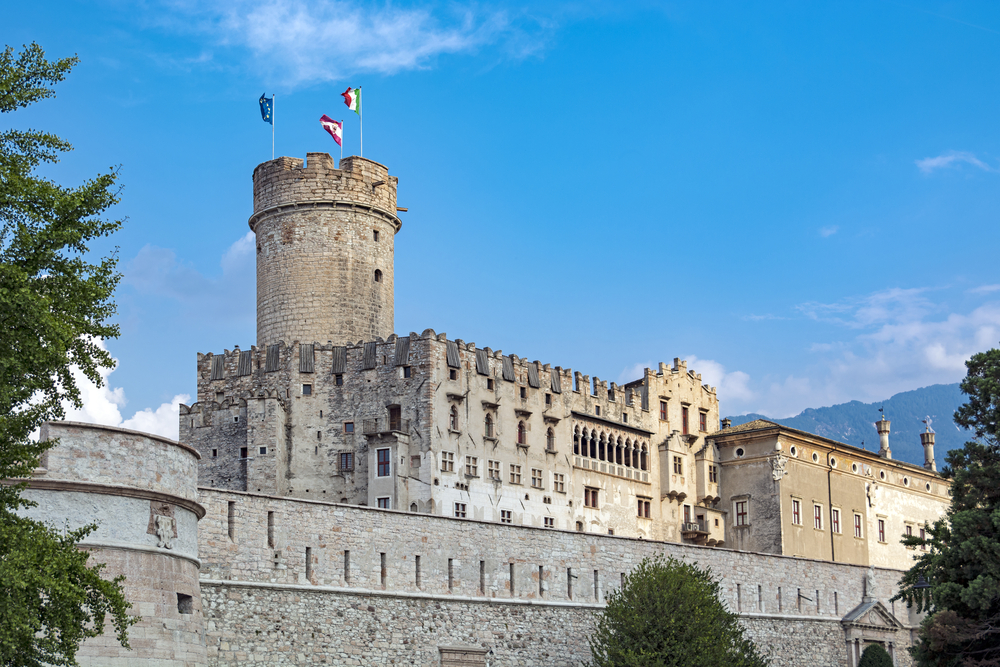
Trentino has a fascinating history dating back to well before the Roman Empire. In fact, the Parco Archeo Natura di Fiave is just one of the 19 places in Italy where you can see prehistoric dwellings recognized by UNESCO.
However, today, much of the visible surviving history can be explored through the region’s historic castles and forts.
The largest castle is Castello del Buonconsiglio, where the prince-bishops of Trento lived from the 13th to the 18th centuries. This castle became the symbol of Trento and is a must-see while in the area.
One of the most famous castles in Trentino is Castel Thun, beautifully located among the apple orchards in the Val di Non and once the home to a powerful noble family. The castle’s interior has been preserved and together with its architecture makes this castle a must-see whether you’re a history lover like me or are just giving your legs a break from the many incredible Dolomites hiking trails!
Another incredible castle is the 13th-century Castel Pergine, which is now a hotel where you can spend the night from the spring to the fall seasons. This castle is perched high atop a hill with views of the Dolomites and once belonged to Austrian nobles. This ancient manor is also said to be haunted by a ghost! If you’re brave, spend the night to see if the lady in white appears!
The Castello di Rovereto is a medieval castle fortress built in the 14th century. Today, the castle houses the Italian War History Museum but you can still admire the castle’s impressive defense towers and walls.
Lastly, Castel Roncolo, or Runkelstein Castle, is near Bolzano sitting atop a rocky outcropping that overlooks the Val Sarentino and some of the region’s vineyards. The castle is a fantastic representation of life in the Middle Ages! Through the stories depicted in the castle’s frescos, visitors can learn all about courtly life. If you’re up for a hike, there’s a trail from Bolzano called the Oswald Promenade (Passeggiata Sant’Osvaldo) that leads you through the gorgeous landscape to the castle in less than an hour.
4. Trentino-Alto Adige’s Gorgeous Cities, Towns, and Villages
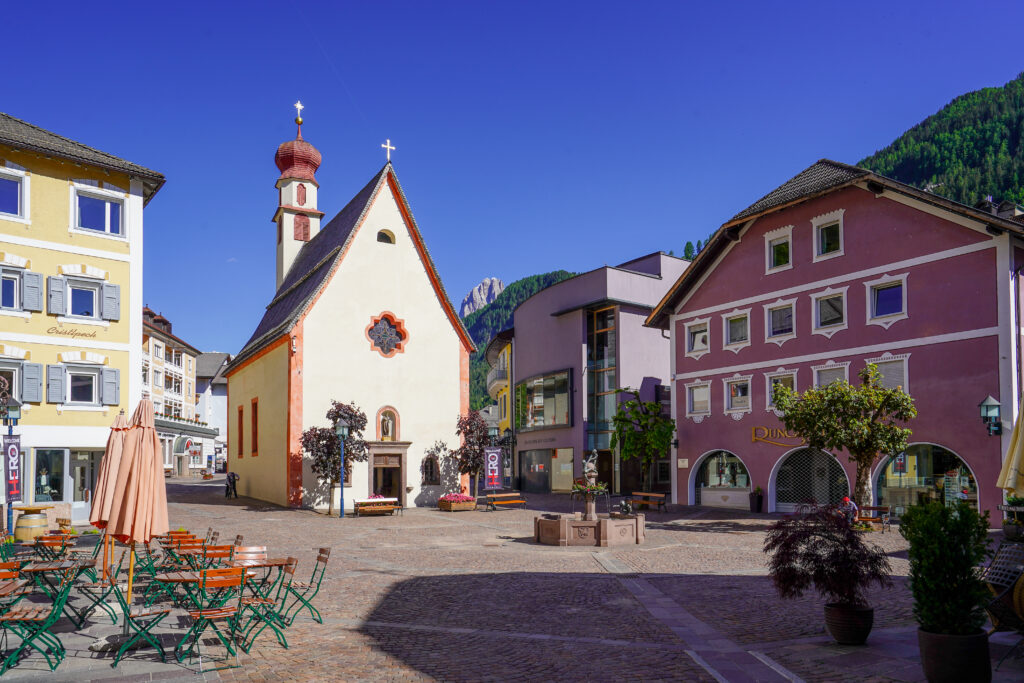
There are many beautiful towns in Trentino-Alto Adige to discover! Trento and Bolzano are the region’s major cities. However, there are many small towns and villages to enjoy as you explore the region.
There are so many things to do in Trento, the capital of Trento Province. Known as the painted city because of the frescoes that adorn many buildings, the city is a can’t-miss!
Start in the historic city center, Piazza del Duomo, with a visit to the 11th-century San Vigilio Cathedral (Duomo di Trento) and to see the sculpted Neptune Fountain. The historic Buonconsiglio Castle is also within walking distance from the city center.
Bolzano is the provincial capital of the South Tyrol/Alto Adige area. The city is a reflection of the region’s German influence blended with the Italian culture and traditions, along with plenty of history to uncover and beautiful landscapes to gush over!
Visit Bolzano’s duomo just near the city’s central square, Piazza Walther. Also, don’t miss the chance to visit Otzi, the Ice Man! He’s a glacier mummy of a man who lived in the Alps over 5,000 years ago and was discovered preserved in the ice. He’s now on display at the South Tyrol Museum of Archaeology in Bolzano. If you’re in Italy at Christmastime, head to Bolzano for one of Italy’s best Christmas markets!
Ortisei is a picture-perfect town situated in the spectacular Val Gardena and surrounded by the Dolomite Mountains. It’s an ideal base for easily accessing the mountains above by riding the cable cars in the center of town. The Seceda cable car brings you nearly eye-to-eye with jaw-dropping mountain peaks and leaves you at the start of numerous trailheads. The Alpe di Siusi cable car whisks you up to the largest Alpine meadow in Europe, of course always with the mountains in sight!
If you’re visiting Ortisei during the holidays, you’ll find several Christmas markets and a festive atmosphere around the village.
Cortina d’Ampezzo is one of the most popular winter destinations in the world and is set to host the 2026 winter Olympics along with Milan. Cortina has a gorgeous mountain panorama and all types of winter sports thanks to the surrounding Dolomite peaks. The city boasts luxury hotels, haute-couture boutiques, and if you’re lucky, celebrity sightings!
Rovereto is a lesser-known city northern Italian city, south of Trento but well worth a visit! It’s known for its art and history museums, including the Italian War History Museum in Rovereto Castle. Be sure to stroll Rovereto’s historic center, too. The art and architecture throughout the city are stunning!
Outside of these main cities and towns, you’ll inevitably stumble upon one adorable alpine village after another, from Santa Cristina to Castelrotto to Riva del Garda along Lake Garda’s northern shores. A Dolomites road trip is a great way to search them out!
5. Trentino-South Tyrol Museums
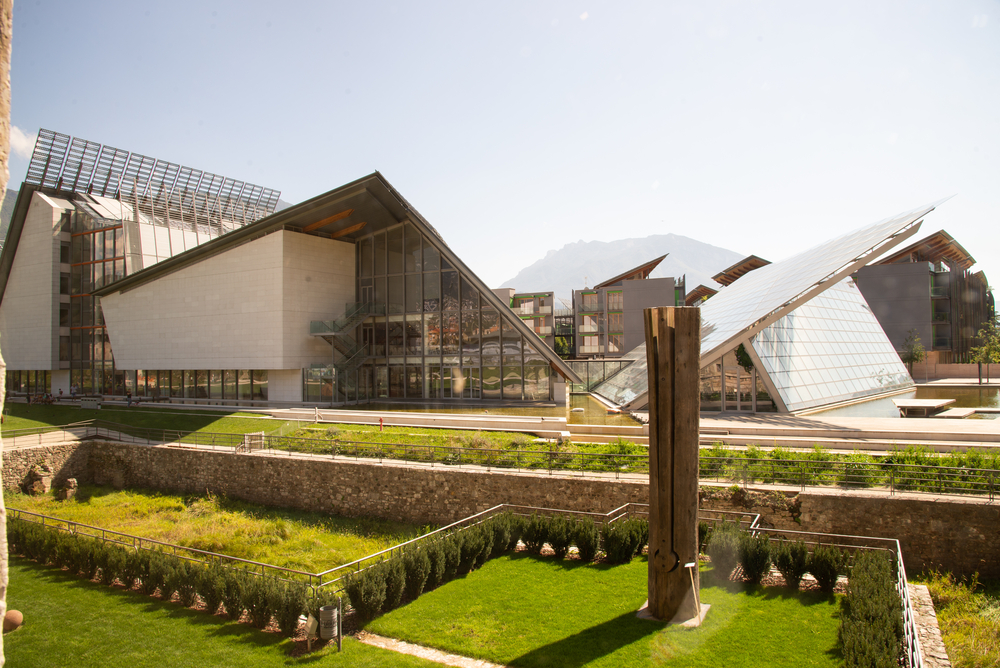
Trentino-Alto Adige is rooted in art, history, and culture.
The city of Trento is one of the best cities to discover Trentino’s past but also world-class art and science exhibitions. Visit the MUSE, designed by famous architect Renzo Piano, to learn all about science and nature. If you’re into religious art, stop at the Museo Diocesano, housed in the gorgeous Palazzo Pretorio.
In Rovereto, the MART is a museum of contemporary and modern art. It houses a large permanent collection of futurist artworks and 20th-century artists like De Chirico and Fontana. And as mentioned above, don’t miss the opportunity to see and learn about Otzi the glacier mummy at the South Tyrol Museum of Archaeology in Bolzano.
The Arte Sella Museum in Valsugana has a special area that will lead you to the woods, where an open-air museum displays a contemporary art collection made from natural elements.
For something truly unique to the region, the Fassa Ladin Museum in Vigo di Fassa tells the story of the Ladin people from pre-historic times until now. This ethnic group in northern Italy speaks a native language called Ladin and has their own culture and traditions. Since they are only found in this region along the Italian-Austrian border, you can only learn about them here in Trentino-Alto Adige!
6. Trentino’s Food and Wine

Every Italian region has its traditional cuisine, and Trentino-Alto Adige’s dishes are uniquely a mixture of Austrian and Italian influences. Specialties have distinct Alpine flavors, making them dishes hearty and delicious.
A local product is speck, a type of salt-cured pork, which is a prominent ingredient in many local dishes. The gnocchi with butter, herbs, and greens like I had at a restaurant in Ortisei was delicious, as were the half-moon-shaped spinach and ricotta ravioli!
A popular local dish you should try is Canederli Trentini, bread dumplings mixed with speck, cheese, and spinach. Polenta is another common dish you’ll find everywhere in Trentino. It’s versatile, cozy mountain food that can be served with meat and mushrooms. Another must-try if you eat meat is deer carpaccio, usually served as an appetizer.
The high altitude and Trentino’s fertile soil are the perfect combination for producing exceptional white wines, in particular. Trentodoc is a sparkling wine similar to Prosecco, which will be your drink of choice while in the region, I am sure!
Is Trentino Worth Visiting?
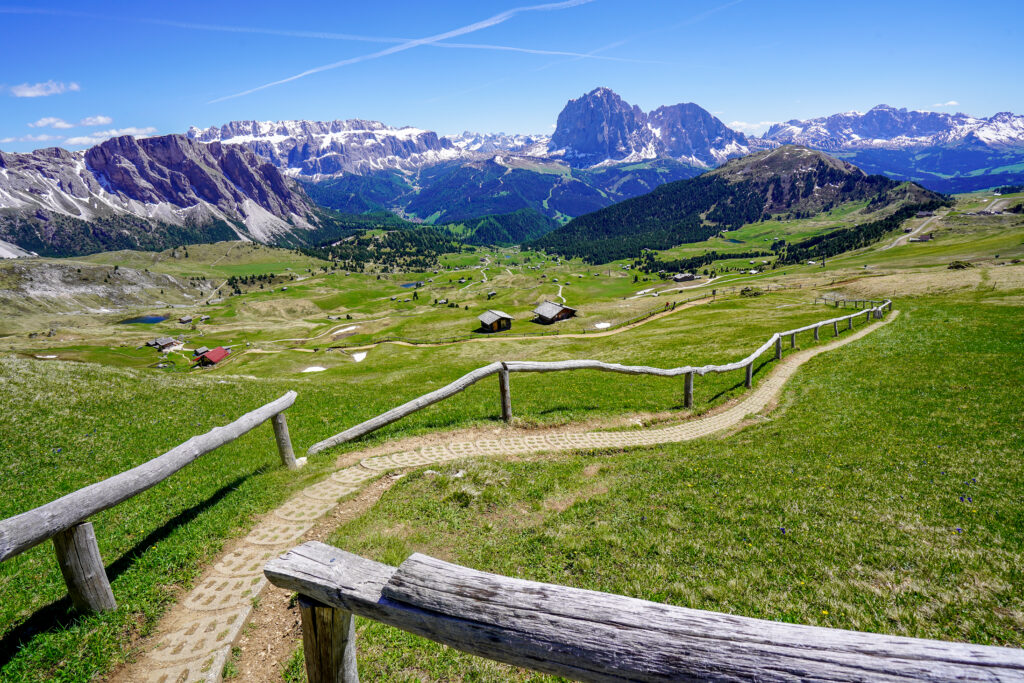
Yes! Trentino-Alto Adige (or Trentino-South Tyrol) is one of the most beautiful regions in the north of Italy and deserves your consideration when planning northern Italy travel!
The Dolomites will take your breath away with their majestic beauty! Along with the outdoor activities like hiking, biking, and winter sports that the mountains provide, the grassy fertile valleys, aquamarine lakes, art and history-rich towns, century-old castles, amazing food, and a unique blend of regional customs will make your time in Trentino like nowhere else in Italy.
So, what questions do you have about the Trentino Alto Adige region?
Like this post? Please share it using the social media buttons.
About The Author
Jackie Sills-Dellegrazie
Leave a comment cancel reply.
Your email address will not be published. Required fields are marked *
Save my name, email, and website in this browser for the next time I comment.
Trentino-Alto Adige, Italy: travel guide and places to visit

Visit Trentino-Alto Adige
From Lake Garda to the south and then into the dolomites to the north, the range of scenery in Trentino-Alto Adige and the opportunities for exploring the countryside are the main attraction for visitors
Trentino-Alto Adige - a guide and places to visit
For a summary of the most popular sights in the region see also Trentino-Alto Adige places to visit .
The Trentino-Alto Adige region is the most northerly region of Italy, and includes much of the Dolomites , and continues north into the Alps
It is largely a region known for its outdoor pursuits and winter sporting activities, and also for it's summer lake activities - for example, part of Lake Garda (including Riva del Garda ) falls in this region.
To the south of the region and in the pretty countryside of the Adige Valley you can discover the attractive town of Trento and its mountainous backdrop, and the castles of Rovereto and Castello di Avio (among many others, including Arco ) - there are numerous castles in the region.

The area around Madonna di Campiglio is a popular region for exploring the countryside of southern Trentino and the Dolomites. Further east the picturesque towns of Cembra, Cavalese and San Martino di Castrozza , each also in lovely settings of meadows, streams and lakes, are also good bases for exploring these mountains.
Moving further into the dolomites are the towns of Bolzano , Ortisei and Canazei - each again with its own particular charm. Ortisei in particular offers convenient access to the fine mountain scenery.
Advertisement
Continuing north into the Alps, discover the towns of Brixen , Bruneck and Vipiteno with an architecture quite different to the southern parts of the region.
Passing towards the north-west of Trentino pass by Merano and onto the town of Malles Venosta - yet again a town in a lovely setting, preferably stopping at Glorenza (listed as a 'most beautiful village in Italy) en route.
Trentino highlights - a photo gallery

Most Beautiful Villages - Trentino-Alto Adige
The following Italian towns and villages in Trentino-Alto Adige are listed among the ' most beautiful villages in Italy ': Canale / Chiusa / Glorenza / Rango / San Lorenzo in Banale / Vipiteno
Orange Flag Tourism towns in Trentino-Alto Adige
The following Italian towns and villages in Trentino are listed among the ' Orange flag towns in Italy ' (a national tourist award): Ala, Caderzone, Molveno and Tenno.
Map of Trentino-Alto Adige and places to visit
Trentino-alto adige places to visit.

Select your language
Site search

Montepulciano

Amalfi coast

Italy This Way - copyright 2009 - 2024 :: privacy policy

14 Top-Rated Tourist Attractions & Things to Do in Trento
Written by Barbara Radcliffe Rogers Updated Dec 23, 2023 We may earn a commission from affiliate links ( )
From its 13th-century castle to a collection of rare aircraft and the state-of-the-art MUSE science museum — a landmark of contemporary Italian architecture — Trento is full of surprises. Although its location at the junction of the trading route from Venice up the Val Sugana with the road over the Brenner Pass made it an important city since Roman times, its place in history was assured when the Council of Trent met and deliberated here from 1545 to 1563.
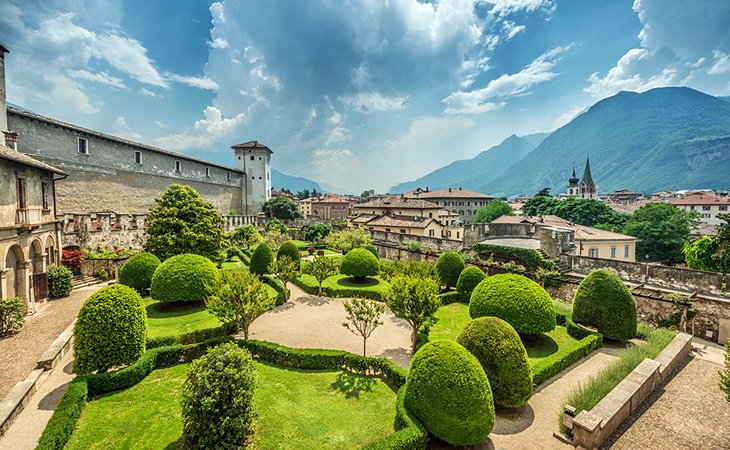
Prompted by the Protestant Reformation, the council laid down the rules and forms of the Counter-Reformation that shaped subsequent Roman Catholic doctrine into modern times. Between 1814 and 1918, Trento belonged to Austria, and after the peace treaty of Saint-Germain at the close of World War I, it became part of Italy, along with the rest of the Sudtirol region.
But unlike Bolzano and towns to the north, it has a distinctly Italian character. Along with seeing the tourist attractions, be sure to explore its streets and piazzas to admire the colorful frescoes that decorate the facades of many of Trento's buildings. Learn more about the best places to visit in and around this northern Italian city with our list of the top tourist attractions and things to do in Trento.
See also: Where to Stay in Trento
1. Castello del Buonconsiglio and Torre Aquila
2. muse (museum of science), 3. piazza del duomo and neptune fountain, 4. duomo (cathedral), 5. orrido di ponte alto, 6. museo diocesano tridentino (diocesan museum), 7. museo dell'aeronautica gianni caproni (museum of aeronautics), 8. via belenzani, 9. giardino botanico alpino viote, 10. museo degli usi e costumi della gente trentina (ethnographic museum), 11. day trip to lake garda, 12. santa maria maggiore, 13. roman tridentum, 14. visit rovereto, where to stay in trento for sightseeing, map of tourist attractions & things to do in trento.
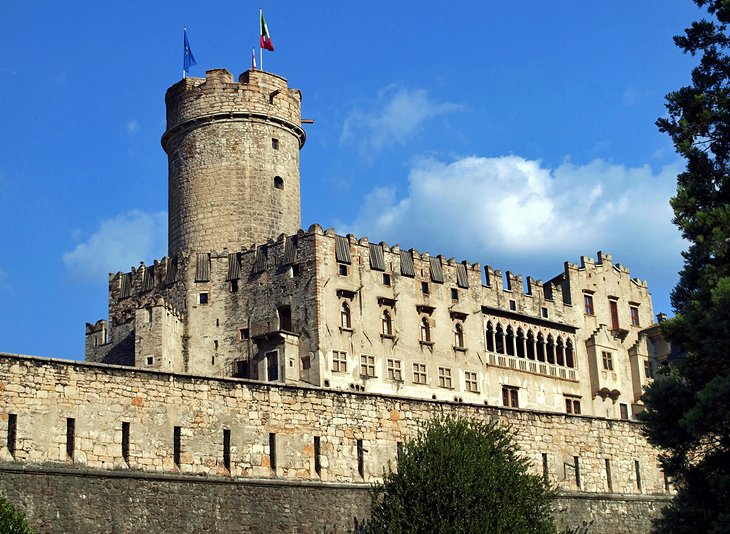
The largest castle complex in the region, Castello del Buonconsiglio was the residence of the prince-bishops of Trento from the 13th century to the end of the 18th century. A massive round tower dominates the 13th-century Castelvecchio, the oldest part, expanded with an Italian Renaissance-style Magno Palazzo in the 16th century and the Baroque Giunta Albertiana in the late 17th century.
At the south end is the Torre Aquila , whose interior is decorated with the exceptional 15th-century Cycle of the Months , one of the finest cycles of secular art from the late Middle Ages. It depicts court life and outdoor activities month by month.
Inside the Magno Palazzo, walls are decorated by another cycle of frescoes painted from the late Middle Ages to the Renaissance period. The Castello houses the Museo Provinciale d'Arte , with sculptures, period furniture, archaeological, and ethnological collections and the Museo del Risorgimento . These exhibits relate to Italy's struggle for unification and liberation from the Austro-Hungarian Empire.
Address: Via Bernardo Clesio 5, I-38100, Trento
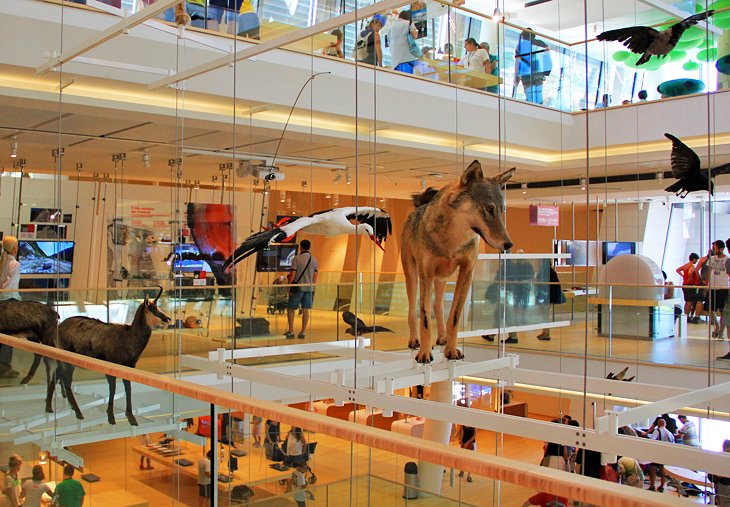
MUSE, the Museo delle Scienze di Trento (Museum of Sciences of Trento) opened in July, 2013 in a stunning building, a major showpiece of Italian architecture created by Renzo Piano Building Workshop. The LEED gold-rated building itself is worth seeing, the dramatic outline of its soaring glass walls echoing the silhouettes of the surrounding mountain peaks and slopes.
Inside, its various levels present the local mountain environment from the geologic formation and fossil record through prehistoric times and into the present natural environment of flora, fauna, landscapes, glaciers, and avalanches.
Throughout, it is filled with hands-on, multimedia, and sensory experiences that bring the artifacts and the subject to life. Although it is among the most popular places to go for families, this is not a museum just for children, but a dynamic introduction to the Alpine landscapes of northern Italy.
Address: Corso del Lavoro e della Scienza 3, Trento
Official site: www.muse.it
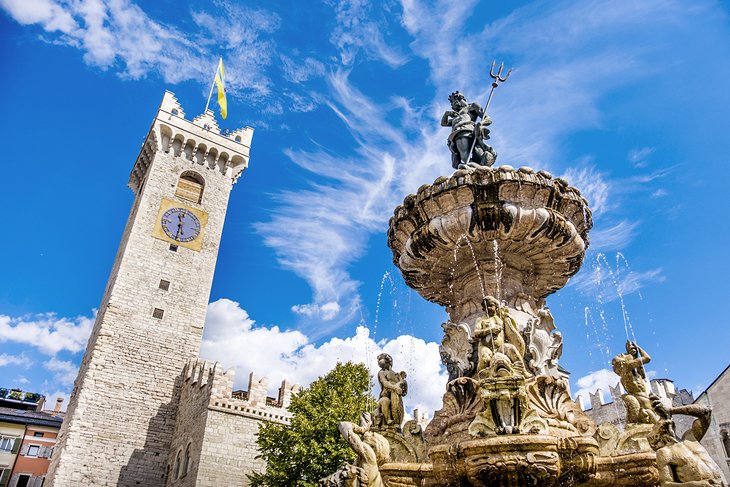
In the heart of Trento, Piazza del Duomo is the city's political, religious, and social center, as well as where you'll find many of its tourist attractions. At its center is the large Neptune Fountain, sculpted by Francesco Antonio Giongo in 1768.
Around the piazza are several places to visit, including the cathedral and Palazzo Pretorio, which houses the Diocesan Museum. The crenellated Vanga Tower overlooks the square from the ends of the palace. Opposite the Duomo, the arcades of Case Cazuffi-Rella support a richly painted façade.
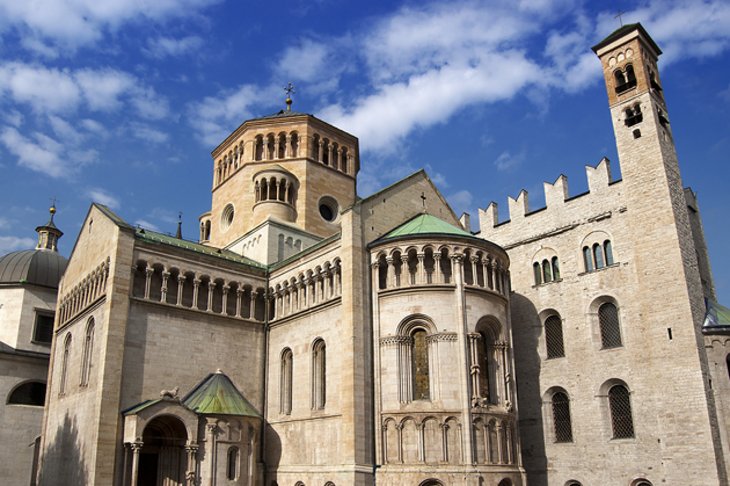
The cathedral, built in the 11th and 12th centuries, was remodeled inside at the beginning of the 13th century, and is remarkable for the combination of Lombard Romanesque style with the high vaulted ceiling more common to later Gothic architecture.
Also unusual are the two staircases built into the side walls leading up to the two bell towers. The interior has 13th- to 14th-century frescoes from Venetian, Lombardian, and late Gothic schools. Under the cathedral are the remains of an early Christian basilica (sixth century), with a fine mosaic floor.
The Council of Trent met in the church from 1545 to 1563, and in the south aisle, the Alberti chapel contains a large crucifix, in front of which the decrees of the Counter-Reformation were announced at its close.
Address: Piazza Duomo, Trento
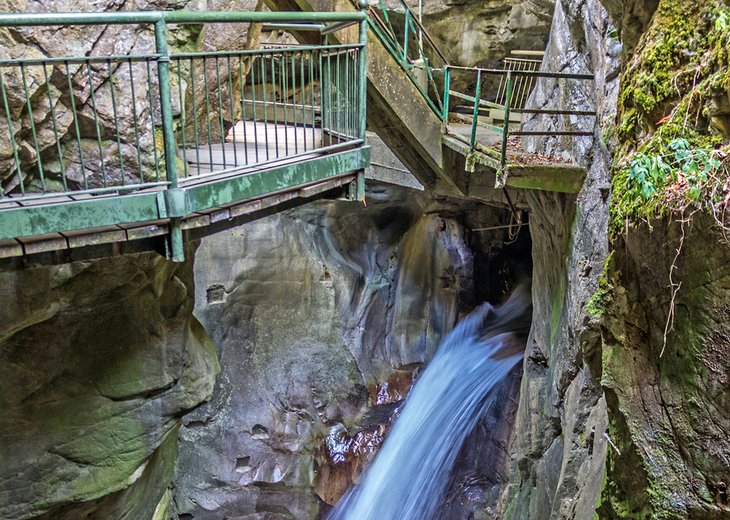
Near Trento, in the village of Cognola, two waterfalls plunge into a narrow canyon carved into the rock by the force of rushing water. Narrow walkways allow visitors to walk through the canyon to see the progression of rock walls sculpted into ever-more-fantastic shapes. The pair of spectacular waterfalls drop more than 40 meters between the rock cliffs.
It is not a good place for anyone with acrophobia, and you must go through with a guide, who explains the geology and history of the gorge (in the summer there are tours in English). The history is interesting: this is the site of some of Europe's most ancient hydraulic works, built in the early 1500s to protect the city from flooding.
Address: Via alla Cascata, Trento
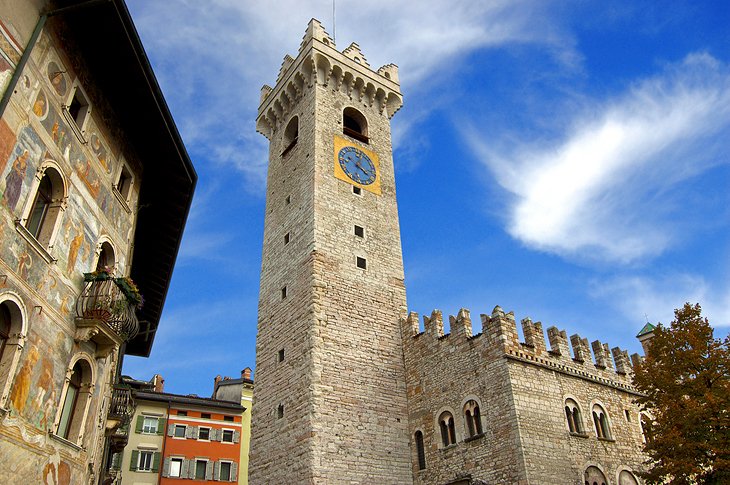
On the east side of the Piazza del Duomo is the Palazzo Pretorio , with the imposing Torre Grande (clock tower). Inside the palace is the Diocesan Museum, whose collections, although religious in nature, document the development of local artistic styles and techniques from the 11th through the 19th century, especially in wood carving and sculpture.
The rich treasury includes fine silver and gold work, early embroidered liturgical vestments, rare illuminated manuscripts, paintings, and 16th-century Flemish tapestries. A multimedia station illustrates the successive stages of building the cathedral.
Address: Piazza Duomo 18, Trento
Official site: www.museodiocesanotridentino.it
Italy's oldest aviation museum lies next to the Trento Airport, dedicated to the memory of Gianni Caproni, the Italian aeronautical engineer and aircraft designer. More than two dozen aircraft are exhibited in the museum, including a number of Caproni planes, a Lockheed F-104G Starfighter, and the only surviving fuselage of a Fokker D.VIII.
Eight other aircrafts on display are the only surviving examples in the world. Many of these are prototypes built by Caproni, including the Caproni Vizzola C-22J, designed in 1980 for the US Air Force as a training craft. The Lockheed F-104 Starfighter is a 1950s prototype of fighter planes used until 2000.
Address: Via Lidorno 3, Trento
Official site: http://www.museocaproni.it/index.php/en/
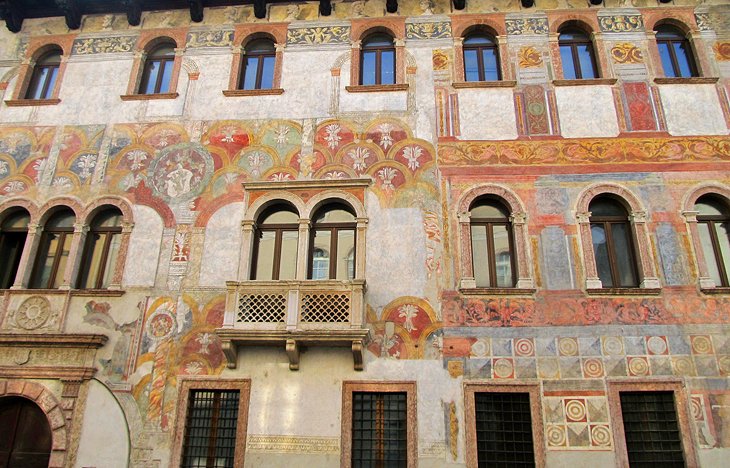
The wide street, Via Belenzani, runs north from the Piazza del Duomo , and you should follow it, looking upward to see some of the best of Trento's painted facades. This is the finest street in town, with a series of palaces painted with historical, classical, and mythological motifs and faux architectural details.
Near the north end of the street, on the right, is the 16th-century Palazzo Municipale , with the 15th-century Casa Geremia opposite. Built by the son of a Veronese nobleman, Casa Geremia is known particularly for the restored frescoes on the façade. You'll also find a chocolate shop, bookstore, and gelateria on Via Belenzani and more on the nearby streets; this is a good neighborhood for shopping in Trento.
Address: Via Belenzani, Trento
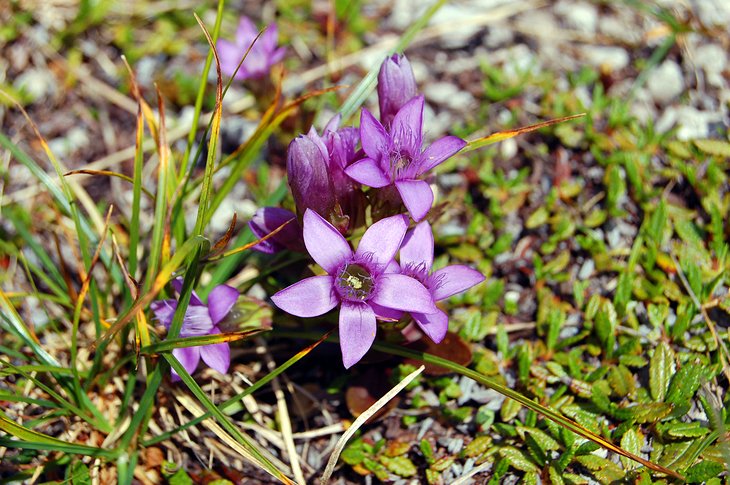
No matter what route you take to get to Viote, it's a 40- to 50-minute drive on curving mountain roads. But for those interested in the Alpine regions of the world and in their plants and geology - or who enjoy exploring the ragged landscapes of the Adige valley, this garden is worth the trip into the mountains.
One of the oldest and largest in the Alps, the garden protects a collection of about 2,000 species of high altitude plants from all over the world, many of them rare and endangered. An unusual addition for a botanic garden is the Geological Garden, which shows the many unusual rocks from the various valleys of the Trentino province.
Address: Località Viote, Trento
One of Italy's best and largest museums of culture and popular traditions, and one of the best anywhere in the Alpine region is just outside of Trento, in the Adige Valley. The Trentina Ethnographic Museum fills 41 exhibit rooms on four floors.
Its specialty is the agricultural traditions and methods of the Alps, and it includes tools and implements for haymaking, timber cutting, cheesemaking, beekeeping, and a complete water mill for grinding grains. Other sections cover artisans such as woodcarvers, wood-turners, cartwrights, wheelwrights, and metal workers forging copper and iron.
A textile section includes wool preparation, spinning, and weaving, and the museum also displays a large collection of kitchen implements, pottery, copper vessels, and bronze pans from the 16th and 17th centuries. Folk costumes, folklore, carnival masks, musical instruments, religious customs, nuptial traditions, hunting, and wine making round out the exhibits.
Address: Via Mach 2, San Michele All'Adige
Official site: http://www.museosanmichele.it/?lang=en
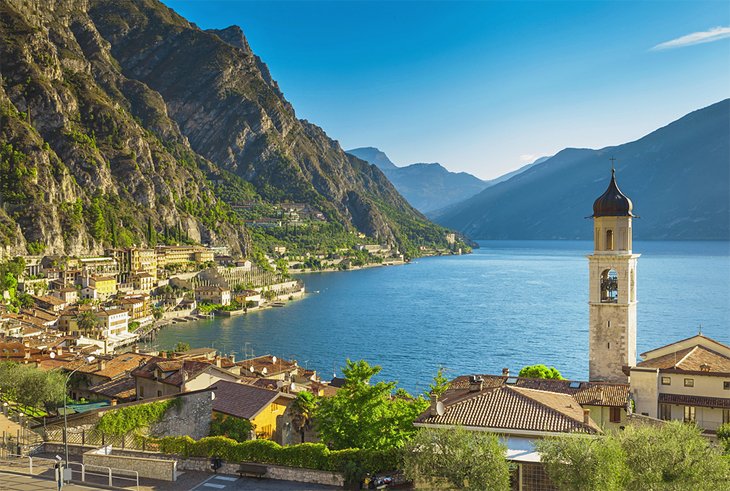
Route SS45 leads through a verdant valley and the beautiful town of Arco to Riva del Garda, 40 kilometers from Trento. Riva sits at the head of Lake Garda, a tourism magnet known for its magnificent scenery and for water sports - Torbole, just east of Riva is the windsurfing capital of Italy.
Roads hug the shore for almost the entire perimeter of the lake, which is 52 kilometers in length. You could drive around the entire lake in a day, but a better day trip from Trento is to drive down the eastern shore, where the most interesting villages are, with times for stops to explore Malcesine's narrow streets and linger in other lakeside towns. Or you could take a lake steamer from Riva to visit Malcesine and its castle, from which you'll see some of the most beautiful views of Lake Garda and its dramatic western shore.
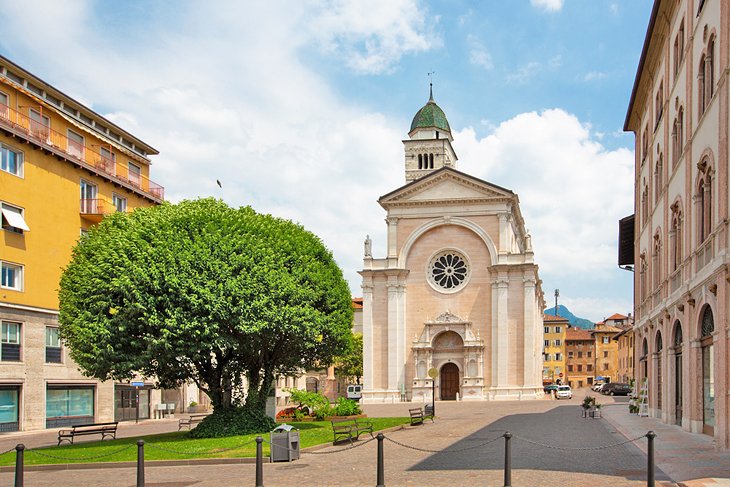
Renaissance church of Santa Maria Maggiore (1520-23), northwest of the cathedral, is built of red marble and white limestone. In the choir are a beautiful organ gallery from 1534 and a fresco from 1563 showing likenesses of the members of the Third Session of the Council of Trent, which met here.
One of the side chapels has an especially beautiful Baroque altar. The church's campanile, bell tower, is the city's tallest, at 53 meters. The column beside the church commemorating the 300th anniversary of the Council of Trent was placed there in 1845.
Address: Piazza Santa Maria Maggiore, Trento
Under Trento lie remains of the buried Roman city of Tridentum, about 1,700 square meters of excavations, which reveal part of the city wall, a long stretch of stone-paved street, sections of houses with mosaics, courtyards, a well, and workshops. It's not a very large site, but it is well interpreted to give a picture of Roman Trento.
Because this Roman city was built upon for two millennia, the excavations represent successive eras, with remains from the Middle Ages and the Renaissance. If you are not visiting the Roman sites farther south in Italy, this is a good place to go with children, so they can glimpse life in the time of ancient Rome.
Address: Piazza Cesare Battisti, Trento
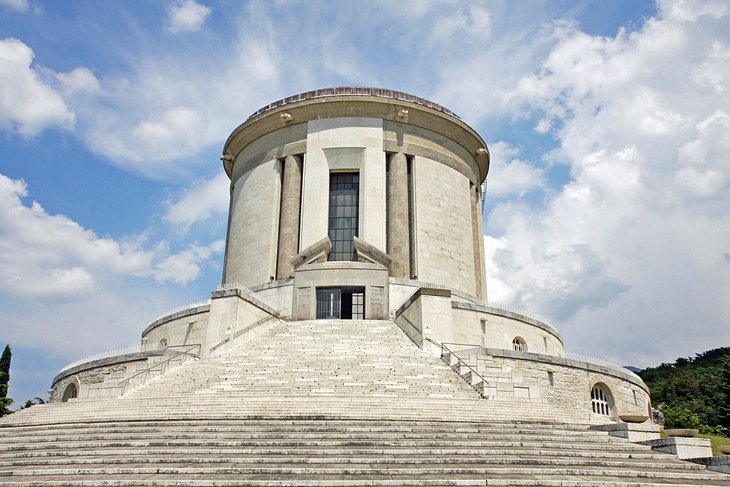
South of Trento is Rovereto, crowned by the 14th-century Castello with beautiful views of the town below and the mountains rising from the Adige Valley. Inside is one of the region's best museums of the two world wars — especially the first, which was fiercely fought in this valley — and their effect on local towns. The artifacts are so well curated and displayed, and so complete, that you don't need to read Italian to get a clear picture of the times.
Near the center of town, the Museo Civico explores local silk manufacturing and has worthwhile collections of Greek and Roman artifacts, as well as local dinosaur finds. Ask here for directions to dinosaur tracks on the hillside above town. On the way here, you'll pass a circular building, the Sacrario di Castel Dante , containing the remains of more than 20,000 dead of the First World War. Above it is a gigantic bell cast in 1965 to commemorate the dead of all nations, which is rung each evening.
With all the things to see in the historic center, we recommend these well-located hotels in Trento, close to the old town and other other top places to go:
- The old-world feel of the Grand Hotel Trento is enhanced by crystal chandeliers, etched glass windows, and coffered ceilings. Guest rooms are well decorated, and many are large enough to accommodate families. Despite its central location there is parking for guests.
- The mid-range Hotel America is steps from the old town, with spacious rooms and great buffet breakfasts.
- Also with a central location, Hotel Buonconsiglio has modern décor; rooms have refrigerators, safes, and hair dryers.
- B&B La Malvasia offers comfortable rooms, some with extra beds for families, within an easy walk of the central attractions. Breakfast is included.
More Related Articles on PlanetWare.com
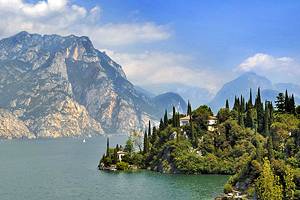
Places to Visit near Trento: Trento is well-located for exploring the Alto Adige region and the tourism highlights around it. If the underground excavations here make you want to see more Roman sites, head south to see the well-preserved Roman arena and other historic sights of Verona . On the way, you may want to take some time to drive along the shores of Lake Garda .
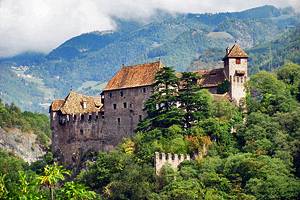
Places to Visit North of Trento: Perhaps after visiting Italy you are stopping in Trento on your way north into the Austrian Tirol. You'll feel as though you're already here when you see the charming blend of Italian and Germanic cultures in Bolzano and Italy's Südtirol . Beyond, in the heart of the Austrian Tyrol, is the former Hapsburg imperial city of Innsbruck; you'll find suggestions of places to visit here in our article on the Top Tourist Attractions in Innsbruck & Easy Day Trips .
More on Italy

Fearlessly Italy
Best Things To Do In Trento, Italy
Capital of Trentino Alto Adige and one of its most important hubs, the many things to do and places to visit in Trento make it for a perfect stop in the region.
Whether you are planning a holiday in the Dolomites or a trip to discover the other cities of the Trentino Alto Adige region , you can’t miss a trip to Trento.
We stayed in Trento for three weeks, making it our base to explore the region. This had two advantages: it’s well-connected to the other provinces as well as the Dolomites by public transport and there are so many things to do in Trento that we had something to see every day. Read on and discover this dynamic city with us.
If you ask me, Trento has it all. History, art and nature, whatever way you want to spend your Trento holiday, you will be covered.
Visiting places like the Duomo, Castello del Buonconsiglio and the internationally-renowned Museum of Natural Science, you can discover the local culture. Taking some easy day trips from Trento, you will be immersed in their breathtaking nature.
Castles, churches, ancient ruins are only some of the things to see in Trento. Here is our city guide for first-time visitors as well as for those of you who wish to discover more.
Table of Contents
Castello del Buonconsiglio, one of the first places to visit in Trento
The Buonconsiglio Castle is by all means one of the very first places to visit in Trento. The residence of the local Prince-Bishops, this is the most important castle in Trento and Trentino region.
The most ancient part of the castle dates back to the 12th century, while other parts like the Aquila Tower were built in the 14th century. The Aquila Tower is very beautiful as it’s fully decorated on all its walls with wonderful frescoes depicting the cycle of the months. The frescoes are a great example of the local Gothic art and depict the noble as well as farmers’ life at the end of the 14th century in Trentino.
The castle is very big also because every century, every new occupant added sections, areas, halls, decorations, paintings and frescoes.
During WWI, this is where the trial of irredentists Cesare Battisti, Fabio Filzi and Damiano Chiesa took place. The three were executed in the courtyard of the castle.
Today Castello del Buonconsiglio is the venue of several temporary exhibitions.
Address: Via Bernardo Clesio, 5. Opening hours: Summer 9.30 am-5 pm, winter 10 am-6 pm. Closed on Monday, January 1st and December 25th. Entrance fee: Adults 10€, for over 65 8€, between 15 and 26 years old 6€. To visit also Torre Aquila is 2€ extra. Contacts: +390461233770 – email: [email protected] – website: https://www.buonconsiglio.it/index.php/en/Castello-del-Buonconsiglio
INSIDER’S TIP: If you are staying in Trento or other Trentino cities for at least two nights, you are entitled to the Trentino Guest Card, included in the stay. It will give you free entrance to several landmarks in Trento and Trentino and public transport including some trains and cablecars. Click here for more info and to see what hotels joined the initiative.
Piazza Duomo, one of the top things to see in Trento
The heart of the city is in Piazza Duomo, where all roads start and where they meet. In the middle is the Neptune Fountain and all around are the landmarks symbol of the city.
First you will see the imposing Cathedral of San Vigilio and the Museo Diocesano Tridentino inside Palazzo Pretorio. Further turning around the fountain are the impressive Cazuffi Rella houses. Decorated with beautiful Renaissance frescoes representing Justice and Fortune, they are a perfect subject for the photographer in you.
Duomo di Trento, one of the top tourist attractions in Trento
Cattedrale di San Vigilio is one of the most important Trento landmarks.
The construction of Trento’s Duomo started in 1212 by the will of bishop Federico Vanga, who contributed to developing the arts and the urban planning of the city. The aim was to build a new Duomo on top of the early-Christian Basilica of San Vigilio that we can visit today in the undergrounds. The style of the cathedral was Romanic, and the project was commissioned to Adamo d’Arogno.
The ancient basilica was built by Bishop Vigilio to give a resting place to three martyrs killed in Val di Non in 397. Here is also where the Bishop Vigilio, after whom the cathedral has been named, has been buried, next to three saints.
Trento Cathedral is also where they issued the decrees of the Council of Trent that took place between 1545 and 1563 as a Counter-Reformation compelled by the Protestant Reformation.
Don’t miss the early-Christian Basilica in the undergrounds of Trento Cathedral. You can access it from a small door near the Duomo.
Address: Piazza Duomo. Opening hours: The Duomo is open daily 6.30 am-12 pm, 2.30-8 pm. Visits are not allowed during the functions. The archaeological site of the underground basilica is open Monday-Saturday 10 am-12 pm, 2.30-5.30 pm, closed Sunday, 1st and 6th January, Easter Week and Easter Sunday, 26th June, 15th August, 1st November, 25th December. Entrance fee: Free for the Duomo, 2€ for the underground basilica. Free with the Trentino Guest Card.
Museo Diocesano Tridentino, one of the main museums in Trento
Right beside the Duomo is the Museo Diocesano Tridentino, one of the main Trento tourist attractions. Set in the Pretorio Palace, it was the main bishops’ residence in Trento.
At the Museo Diocesano you will see a pretty vast and diverse collection of artwork dating back from the 13th to the 19th centuries. On displays are paintings, wooden sculptures, polyptych altarpieces (Flügelaltäre), precious gold articles, ancient embroideries, liturgical vestments, Flemish tapestry from the 16th century.
There is also a section devoted to icons and testimony of the Council of Trent.
Upstairs in the Museum you will find a door from where you can access a narrow balcony to have a view inside the Duomo.
Address: Palazzo Pretorio, Piazza Duomo 18. Opening hours: Summer daily except Tuesday 10 am-1 pm, 2-6 pm. Winter daily except Tuesday 9.30 am-12.30 pm, 2-5.30 pm, Sunday 10 am-1 pm, 2-6 pm. Entrance fee: Adults 7€, 2€ for university students and younger than 26, 5€ for over 65, free with the Trentino Guest Card.
MUSE, one of the best things to do in Trento with kids
The Museum of Natural Science (MUSE) is one of the best things to do in Trento with kids and one of the most famous museums in Italy . It’s divided into several floors, each with different topics.
My suggestion is to start from the underground floor to discover the first traces of life on earth, the DNA and visit a fantastic reproduction of a tropical forest in the hot and humid tropical greenhouse.
The ground floor has a space for interactive science your kids will love, while from the first to the third floor, you will discover the Alpine world, its prehistory, sustainability and innovation, the geology of the Dolomites mountain range, its resources and biodiversity.
The fourth floor explores the world of glaciers and the living organisms in different climates.
Address: Corso del Lavoro e della Scienza 3. Opening hours: Tuesday-Friday 1- am-6 pm, Saturday, Sunday and holidays until 7 pm, Monday closed. Entrance fee: Adults 10€, reduced 8€. Family fees: 2 parents with underage children 20€, 1 parent with underage children 10€.
Palazzo delle Albere, off-the-beaten-path Trento
The Albere Palace is right in front of the MUSE. So if you are not too tired, this is also one of the worthy Trento attractions.
Palazzo delle Albere is a 16th-century palace built by the will of prince-bishop Cristoforo Madruzzo between 1550-1560. Its name comes from the two lines of poplar trees that led to the entrance.
This is a beautiful noble residence that during the Council of Trent was a place of feasts and tournaments to welcome princes and ambassadors.
Today it’s the venue for temporary exhibitions (we saw a fantastic one about the First World War). On the walls of the first and second floors, you can see stunning frescoes from the 16th century.
Address: Via Roberto da Sanseverino 45. Opening hours: Tuesday-Friday 1- am-6 pm, Saturday and Sunday until 7 pm, Monday closed. Entrance fee: Free.
Santa Maria Maggiore Church, one of the important historical places in Trento
Santa Maria Maggiore is the church where the main gatherings in preparation for the third phase of the Council of Trent took place. It was built between 1520 and 1524 with a project by Antonio Medaglia commissioned by the prince-bishop Bernardo Cles. This church is what to see in Trento for history buffs.
Like many churches, it was built on the ruins of the ancient city, which here was the Forum of the Roman settlement Tridentum.
A beautiful pipe organ by sculptors Vincenzo and Girolamo Grandi, the altar by Giovanni Battista Moroni, Pietro Ricchi, Francesco Unterperger and Giambettino Cignaroli, and paintings by Giovanni Maria Falconetto decorate the interior.
Address: Piazza Santa Maria Maggiore. Opening hours: Daily morning and afternoon. Entrance fee: Free.
Museo della Società Alpinisti Tridentini, for adventurous travelers in Trento
In Trento, the Trentino’s Alpine Mountaineers Society set up a museum in the city center right near the train station in Piazza Dante. Their aim is to display the history of the group and the relationship with the local irredentism.
From the mountains of Trentino Alto Adige, the residents experienced both World Wars the harshest way. Life in the trench was extremely hard and still alive in the collective memory. This is why they devoted one of the sections of this museum to the fight and like during WWI in the mountains.
You will see documents, weapons, objects, the luggage they carried up in the mountain during the war, letters, uniforms and more. Although close to my hotel, it didn’t capture my attention among the places to see in Trento. I entered almost by chance but I’m truly glad I did.
Address: Via Manci 57. Opening hours: Monday-Friday 9 am-1 pm, 2-6 pm. Entrance: Free.
S.A.S.S. Underground Archaeological Trento Ruins, what to do in Trento for history buffs
Just like many parts of Italy and Europe, also in Trento you can visit some Roman ruins. You will see the ancient Roman settlement of Tridentum, the name Trento was founded with.
This fantastic archaeological site shows the urban planning of the ancient Tridentum as well as a fascinating itinerary into the daily life in Trento in Roman times.
You will have the chance to see pieces of the ancient streets paved with large stones, the sewage system and even some private spaces including a house ( domus ). Definitely one of Trento landmarks I suggest visiting.
Address: Piazza Cesare Battisti. Opening hours: 9.30 am-1 pm, 2-6 (in winter opens at 9 am and the afternoon until 5.30). Entrance fee: Euro 2.50.
Palazzo Lodron Archaeological Site, more things to do in Trento for ancient history lovers
This is linked to the S.A.S.S. as it’s another archaeological site underground Trento. Here you visit a district of the ancient Tridentum, it’s basically the continuation of the site described above.
The site consists of different areas like a section of the southern city walls, a stretch of a road, a tower, a private house with its heating system, a house where it’s visible also a rare example of sitting toilet, and a wine shop.
Address: Piazza Lodron 31. Don’t be mistaken, the main entrance is in common with the bank Banca Popolare-Volsbank. Access the archaeological area from a different door after the main entrance. Opening hours: Wednesday, Thursday and Friday 10 am-12 pm, 2.30-4.30 pm. Closed on holidays. Entrance fee: Free.
Trento Monumental Cemetery, one of the unusual things to do in Trento
Close to the MUSE and some 10 minutes walk from the city center is the big monumental cemetery.
The construction of the cemetery started in 1826 and includes a main chapel dedicated to the Redeemer and several smaller chapels. There are also different themed areas such as the memorial for the war victims.
Many tombs are decorated with sculptures by artists such as Andrea Malfatti, Stefano Varner, Stefano Zuech, Eraldo Fozzer, and Othmar Winkler.
This is one of the unusual places to visit in Trento but the artwork makes it worth it.
Address: Via Giuseppe Giusti. Opening hours: Daily 7 am-7 pm, in winter until 6 pm. Entrance fee: Free.
Piazza Dante, one of the central parks in Trento
This is the place of the public gardens. In fact, you will see families with kids playing especially on weekends. In the middle is a tall monument statue of important Middle Age Florentine writer Dante Alighieri.
Right here, every Saturday morning from 7.30 am to 1 pm (holidays excluded), they set up an organic veggie market. On the other side, there are dancing fountains and some benches to enjoy the greenery.
The piazza is located between Trento’s main train station and Grand Hotel Trento , which was where we stayed. Inside the gardens, there is also a small coffee shop for drinks and casual snacks. Sitting on one of the benches is what to do in Trento if you are after some relaxation.
Cable car to Sardagna, for a beautiful view of Trento
On a clear day, take the cable car and climb up to Sardagna for a full view of Trento and the Bondone mountain up close.
It takes a few minutes to go up and gradually the view of the city and the mountains unfolding both sides is very beautiful. Once up in Sardagna, known as Trento’s panoramic terrace, you can have a walk around the little village, the natural path that keeps going up on the hill and once there, a coffee or lunch.
Sardagna is some 600 meters from sea level. When the cable car is going up it seems going right in the mountains. So if you high altitudes make you dizzy, you probably shouldn’t do it.
Address: From the main train station you head towards Piazza Da Vinci and the Adige river. On the Lung’Adige Monte Grappa, right before Ponte San Lorenzo bridge, you will find the cable car station close to a bar. Opening hours: Daily 7 am-10.30 pm. Fee: If you have the Trentino Guest Card, the fee to go up is included, otherwise a normal bus ticket will do.
Take a day trip
There are many fantastic day trips from Trento that can make your holiday even better. Without going too far, you can visit the gorgeous Castel Thun or the scenic sanctuary of San Romedio. If you are into nature, you can opt for one of the lakes, Lake Tovel or Molveno Lake, both with stunning views of the Dolomites that make for some of the best European holidays in July as well as in winter.
If you are not tired of cities, with an easy train ride you can get to Bolzano , Merano, and Bressanone.
Where to eat in Trento
We tried quite a few restaurants in Trento. One that saw us several times is Antico Pozzo (Vicolo della Sat 6), great pizza, salads, pasta and both fish and meat dishes from all Italian regions .
Another restaurant in Trento close to the Duomo we tried a few times was Ristorante Chistè (Via delle Orne 4). Also here, very nice pizza, diverse salads, first and main courses. And delicious desserts.
If you want to enjoy a vegetarian/vegan buffet, take a bus towards Via del Brennero and enjoy a light lunch at the cafe Pappami , on the ground floor of the shopping center Top Center (Via del Brennero 320). They have a menu of first and main courses, sandwiches and salads.
You don’t fancy anything from the menu? You can compose your own salad. Some of the salads are served on a bread-dish that you can also eat. We liked this place and we went some twice or three times. Simple and very affordable.
Worth trying during your Trento sightseeing are also Osteria Le Due Spade (Via Don Arcangelo Rizzi 11) for traditional cuisine and the restaurant of Grand Hotel Trento for fancy and delicious dishes.
Where to stay: top hotels in Trento
We stayed at Grand Hotel Trento and we loved it. This 4-star accommodation in Trento city centER is very comfortable and equipped with all THE services. The room is modern and furnished with a wardrobe, TV, writing desk, chairs, a small fridge. Included are tea and coffee-making facilities, while the fridge stock is extra. Rooms include independent air-conditioning/heating system and WiFi.
Some other good hotels in Trento are Hotel America in the city centER, the luxurious Hotel Villa Madruzzo or the more budget options like B&B La Loggia Del Castello and Al Cavour 34 .
If you prefer the privacy of a house, some of the favorites are TrentoApartment , Lainez Rooms & Suites and Cinquanta4 Charme Apartment .
Search for more hotels in Trento and compare the prices.
WANT TO READ IT LATER? PIN IT TO YOUR BOARD!
2 thoughts on “Best Things To Do In Trento, Italy”
Thanks for the great information. My husband and I will be in Trento for a month in Late August early September 2023. After which we will travel to Florence and stay there for a month till early October. Will follow your instagram page and look out for further articles from you.
Thanks, Deb! Fantastic itinerary, if on the way, you can stop also in Bologna, you will visit a very elegant city. Let me know if there is any particular information you need about Trento or Florence!
Leave a Comment Cancel reply
Save my name, email, and website in this browser for the next time I comment.
![visit trentino alto adige AWW Media [US]](https://img-s-msn-com.akamaized.net/tenant/amp/entityid/BB1kdTYO.img)
AWW Media [US]
16 Underrated Towns in Italy You Must Visit
Posted: April 26, 2024 | Last updated: April 26, 2024
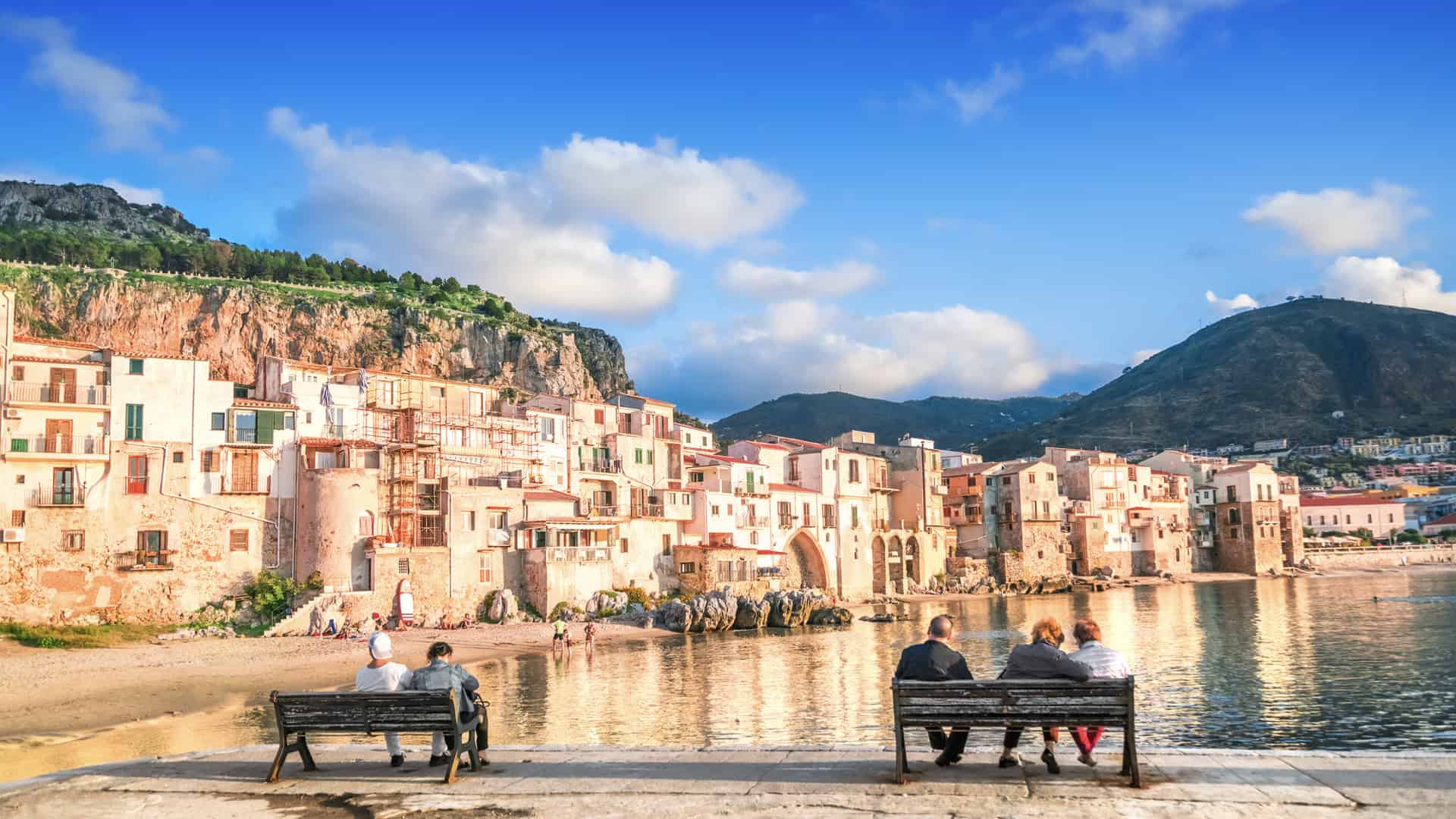
Many great and beautiful Italian coastal towns and small towns inland attract millions of tourists each year. However, if you want to avoid crowds and have more space to get the most out of your trip to the country, you will be interested in the best small towns in Italy.
That is what we are going to look at in the following post. With an emphasis, as ever, on frugal vacations and traveling, we will look at the unsung heroes, the towns that do not get the hype or acclaim they should. So, let’s dive right into it with our first of the most underrated towns.
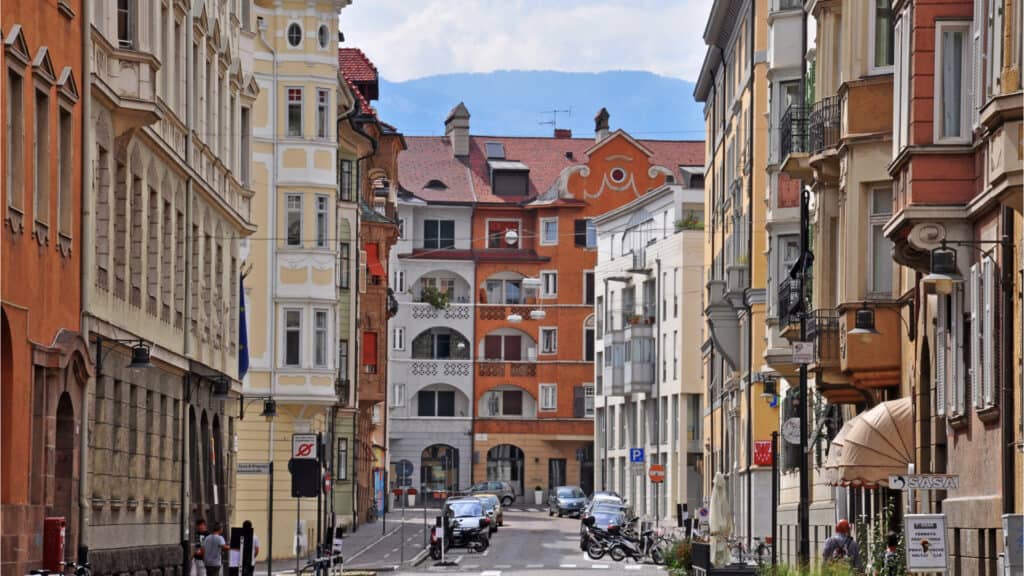
1. Bolzano, Alto Adige
To kick off our guide to the underrated and best small Italian towns to visit, we wanted to highlight the stunning Bolzano. Found in northern Italy in the South Tyrol province, this is a bilingual town. Around 75% of the locals consider Italian their first language, while 25% state that it is German. The Austrian and German influence is not just in language alone, as you will find this in the architecture and many of the key sites around the town.
If you want to explore the Dolomites in the Alps, many see Bolzano as the gateway to the mountain range. Aside from the mountains, there are many medieval castles and hill-based vineyards. Make sure you allow time to explore the Tyrol Museum of Archeology, home to many artifacts, including Otzi, the Neolithic mummy. You should also stop at the Duomo di Bolzano Cathedral and Mareccio Castle, first built in the 13th century.
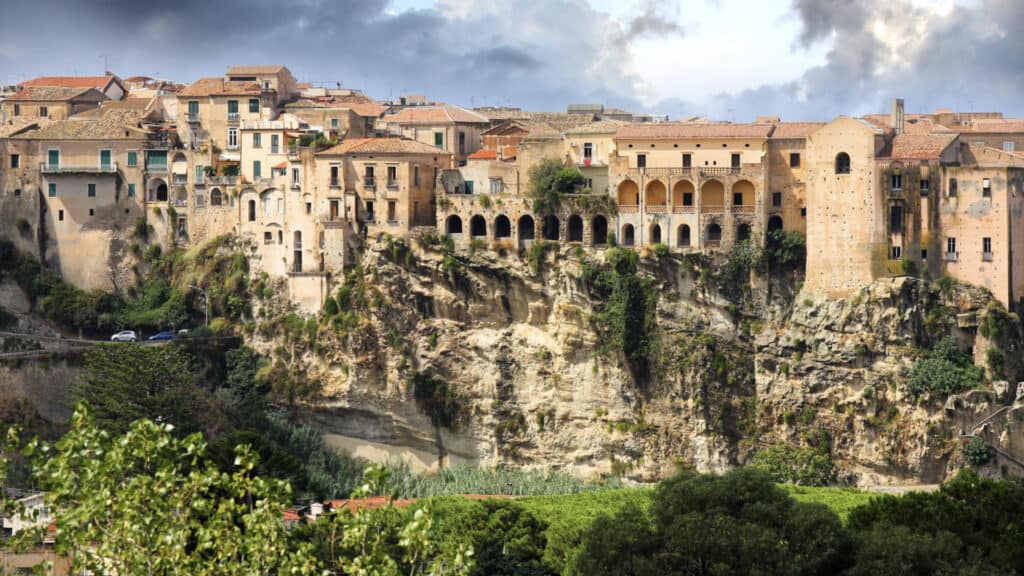
2. Calabria
Moving further down the county to the opposite end, Calabria is one of the best towns to visit in Southern Italy. Surprisingly, the town often referred to as Italy’s boot toe is one of the least popular with tourists. Many locals, however, know better and frequently visit Calabria on vacation. Why? Perhaps the 800 km pristine coastline with an incredible variety of stunning beaches is one of the draws to this part of the county. Aside from the seaside attractions, there are many fantastic buildings from different architectural and cultural eras and many great places to eat local cuisine with fresh, locally sourced ingredients.
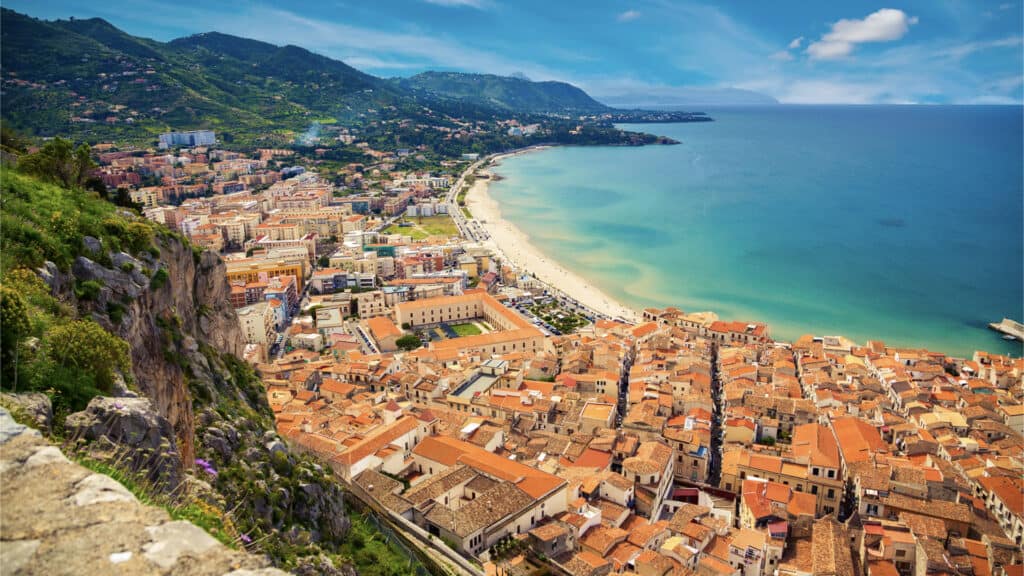
3. Ragusa and Cefalù, Sicily
There is plenty of interest in the island of Sicily off the coast of Italy in the Mediterranean Sea. It is the biggest island and one of the 20 main regions of the country. As spectacular as it is to visit Sicily, many people don’t realize that there are many must-visit towns in Italy that are found on and around Sicily. Take Ragusa, for example, located in the gorgeous Hyblaean Mountains; it is not too busy or exciting but is home to many impressive baroque-style buildings and structures. Not too far away is another must-visit place, known as Cefalù. An island and a town, it is home to many photo-worthy pizzas and an imposing Norman cathedral that dates back to when the Normans occupied the region.
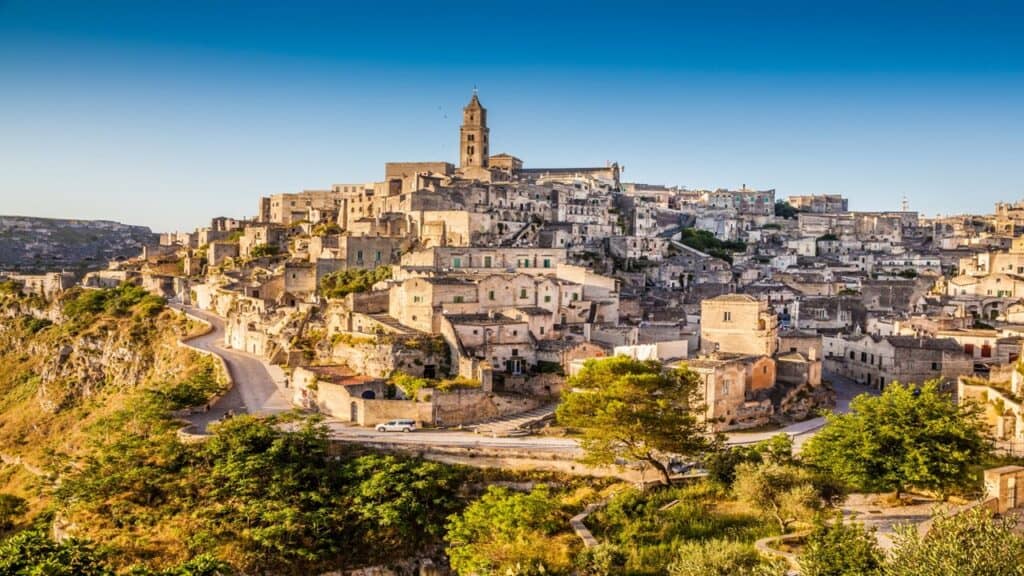
4. Matera, Basilicata
Although it was once considered one of the poorest towns in the county in the past, Matera has transformed into one of the most beautiful Italian towns to visit. The capital of the Province of Matera and located in the geographically stunning region of Basilicata in the south, it has a long and intriguing heritage and history thanks to its continuous occupation there since the Paleolithic era, around the 10th millennium BC.
The town stands in a very steep canyon, and it is home to an incredible network of cave dwellings, also known locally as Sassi, where people have lived for more than 12,000 years. The caves were excavated during the 1960s due to overcrowding, but they are not home to hotels, restaurants, galleries, or cafes. Film buffs who saw The Passion of Christ, directed by Mel Gibson in 2004, will likely know it was filmed in Matera.
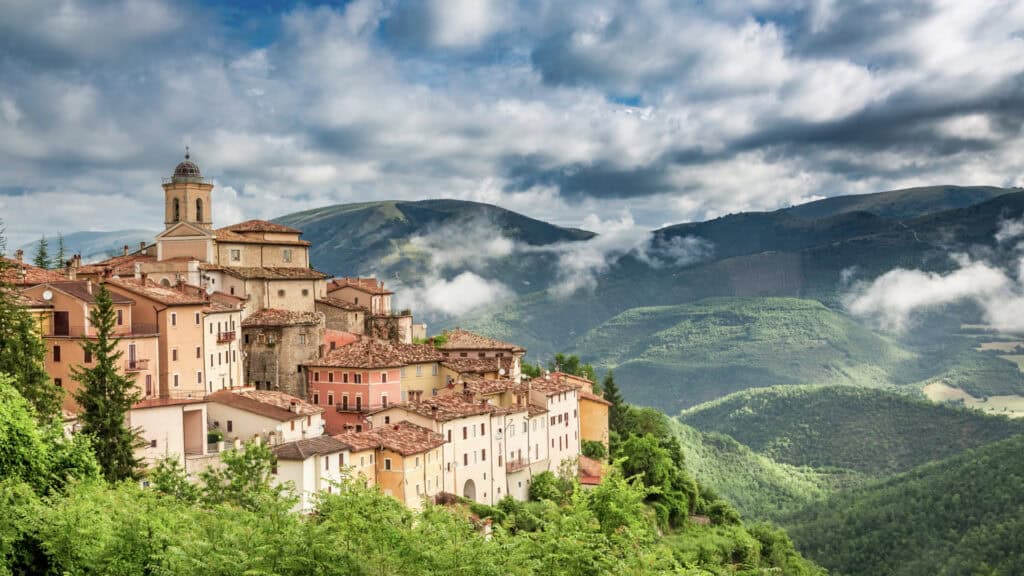
When planning your trip, consider the spellbinding region of Umbria for a genuinely Italian vacation experience if you are looking for towns near Florence. It sits between Florence and Rome and allows you to use it as a base to see those more popular locations while sampling the various regional dishes and visiting towns like Assisi, the birthplace of San Francesco Assisi, Montefalco, a sleepy hill-town famous for its red wine and Castelluccio, a village at the highest point of the Apennine Mountains.
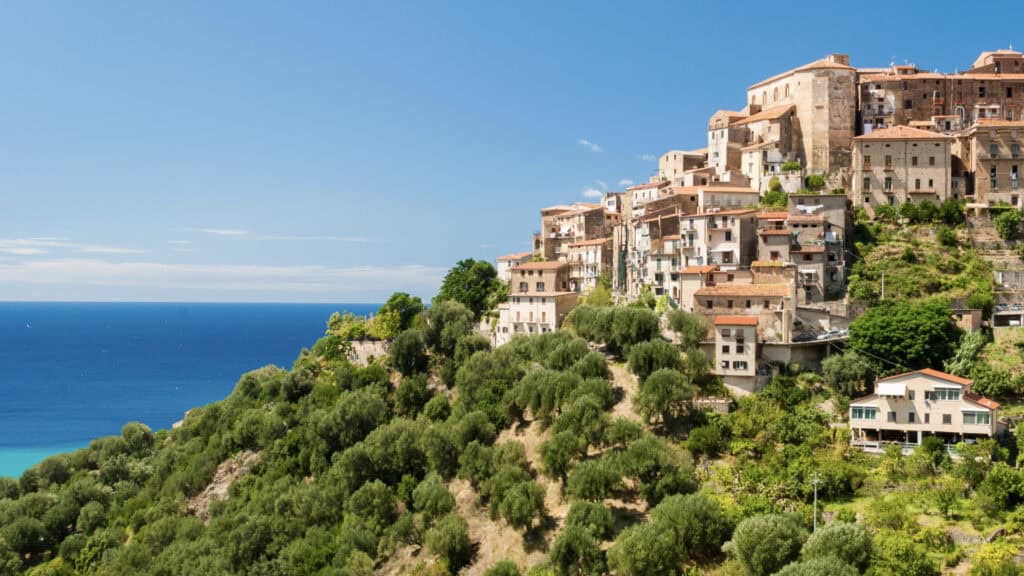
6. Pisciotta, Campania
As the country has around 7,900 km of sea-hugging land, Pisciotta is one of the best Italian coastal towns to visit and one that should be more popular. Located within the breathtaking Cilento National Park in the Campania region, the town and surrounding area are covered in beautiful olive groves.
The town is home to a fully reserved medieval urban plan. It features eye-catching stepped alleyways that date back centuries and lead to a collection of tiny houses, piazzas, hidden chapels, and a castle on top of the hill. Mythology and legends of the town state that it was established by the Trojans, who survived the fall of the ancient city of Troy.
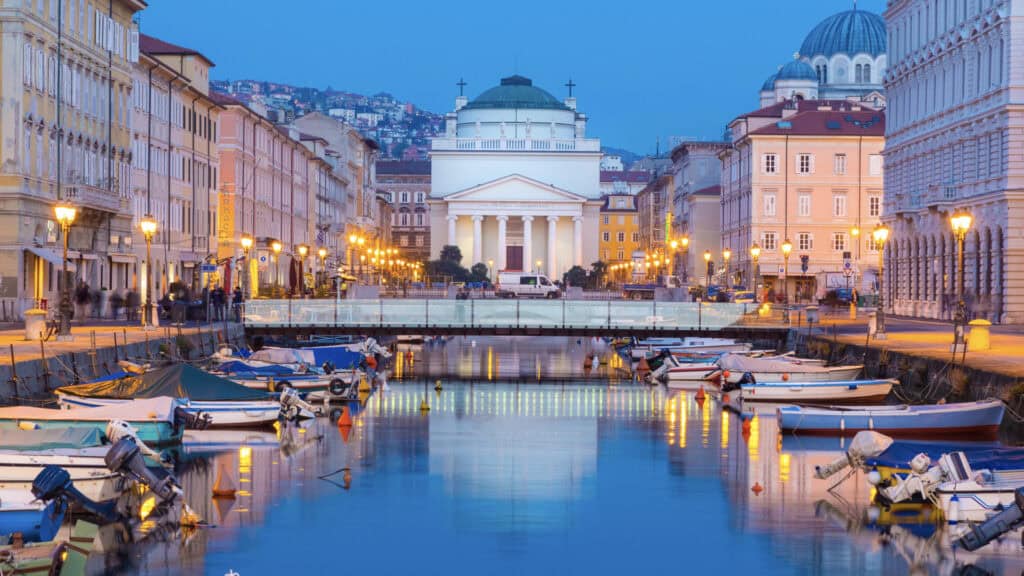
7. Trieste, Friuli Venezia Giulia
A port town that was once a center of culture in the region, Trieste is now overlooked in favor of other towns and cities. Despite the decrease in popularity, and perhaps benefitting from that fact, Trieste is the best town to visit in Italy if you want a quiet experience. There is a genuinely fascinating and cosmopolitan atmosphere at the Italian-Slovenian border, close to Croatia. While there, visit Città Vecchia, the old town with twisting and turning cobblestone-clad streets and beautiful medieval homes, the 2,000-year-old Roman Theater, and the intriguing Austrian Quarter.
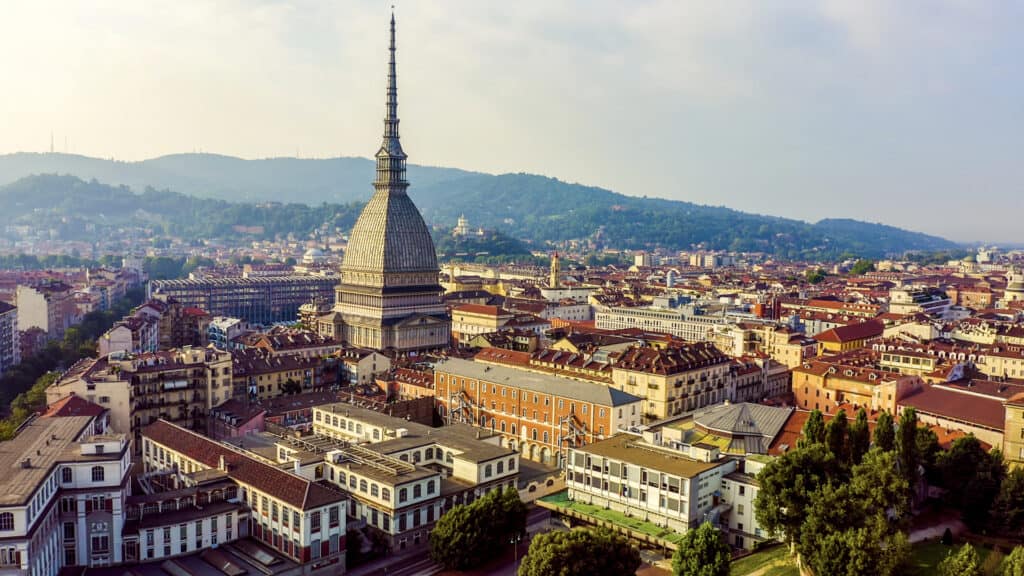
8. Turin, Piedmont
Despite being one of the biggest industrial centers in the country, Turin is nevertheless overlooked. It is one of the many small towns in Italy worth visiting. It is home to a rich and diverse history and culture with many intriguing attractions and sites, including theaters, museums, art galleries, castles, and churches.
One of the key attractions that the town is synonymous with is the Turin Shroud in the Egyptian Museum. At one point, it was the first capital city of the unified Italy and where the Royal House of Savoy was located.
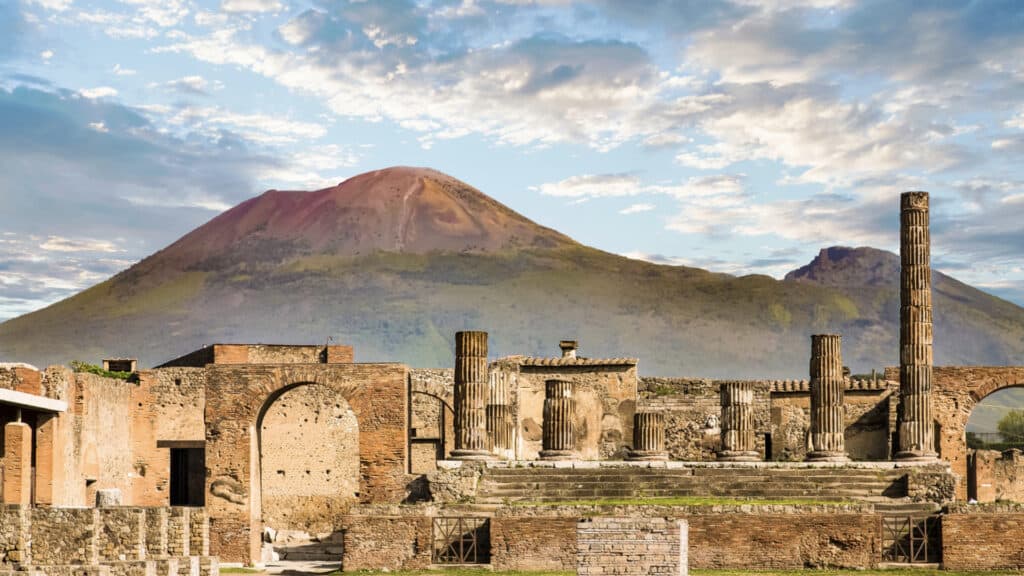
9. Herculaneum, Campania
If you want to learn more about Pompeii, the site of the Mount Vesuvius eruption in 79AD that destroyed the town, one of the best Italian coastal towns to visit is Herculaneum. While Pompeii welcomes thousands of visitors yearly, Herculeum is less prevalent. You may already see the more significant, popular site and want a quieter place. Herculeum is around 10 miles north of Pompeii.
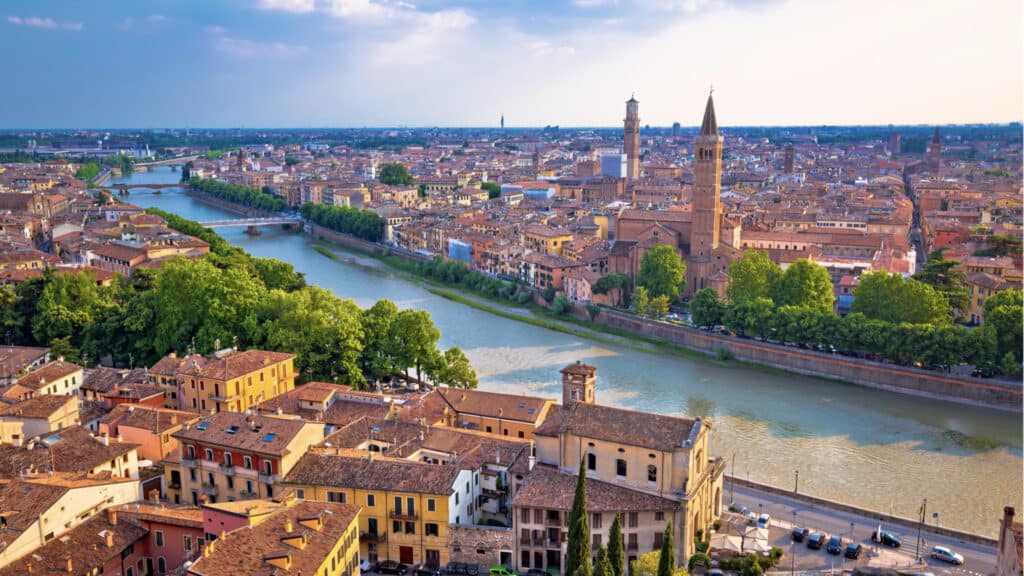
10. Verona, Veneto
Surprisingly, the setting for the famous Shakespearean tragedy of Romeo and Juliet, Verona, must be appreciated more. That being said, it is one of the best small towns in Northern Italy. It is home to beautiful architecture, such as the Juliet balcony and the town’s spectacular amphitheater that has been there since Ancient Roman times. While in Verona, you are suitably placed for exploring Treviso and its famous walled center, which is seen as being Venice in small, without the overcrowding and necessary.
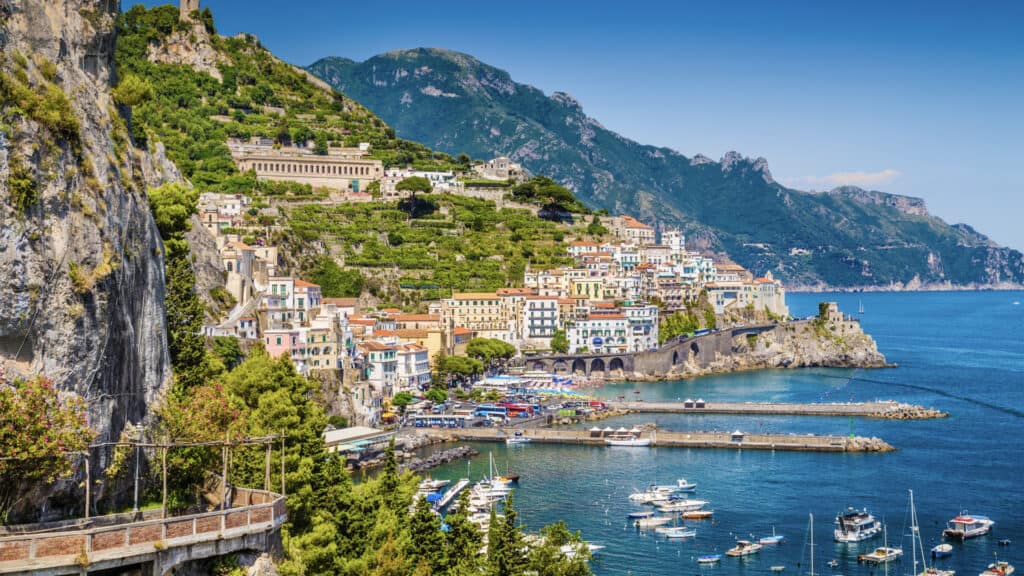
11. Ravello, Amalfi Coast, Campania
Many towns around the Amalfi Coast are popular with tourists, like Positano, Capri, and Amalfi, which overlook Ravello. Interestingly, though, only a few people go to Ravello. Located on the top of a stunning hill, looking out over the coast, it is perhaps the best town to visit in Italy on a budget, especially if you are looking to experience eye-catching terraces and gardens without having to deal with the traffic and crowding that the other towns in the region.
So, if you want to enjoy a frugal trip to Italy, Ravello is a great place to work into your itinerary.
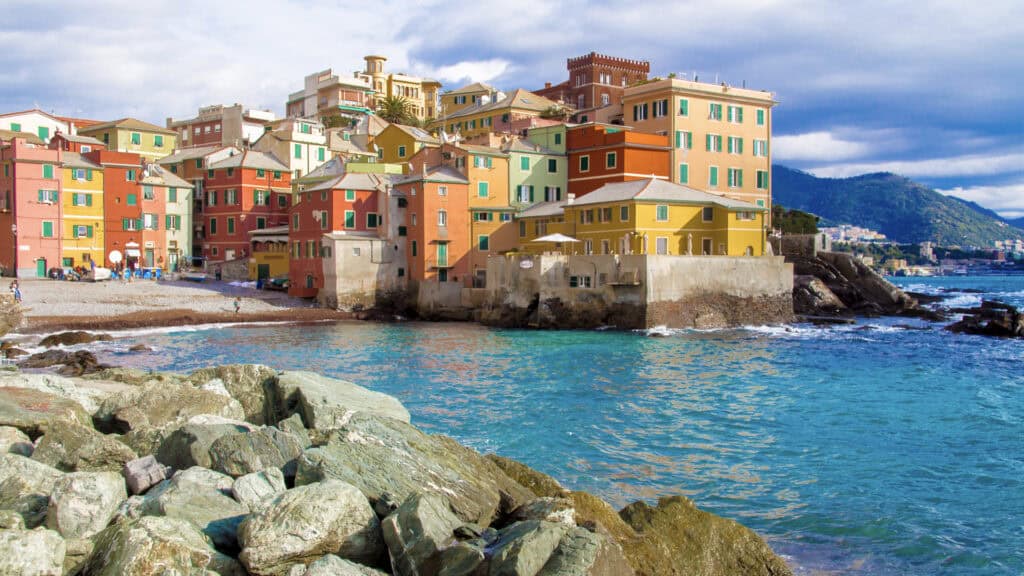
12. Genoa, Liguria
The atmospheric and spectacular Cinque Terre dominates the Liguria region. However, one of the best Italian towns to visit in winter is Genoa. Genoa is the region’s capital, though, and it is fantastic. It offers a truly authentic tourist atmosphere, has remained a busy trading center, and is known as the birthplace of the explorer Christopher Columbus.
Many beautiful galleries are around the town, like the Raccolte Frugone and Palazzo Rosso and the biggest aquarium in Italy, the Acquario di Genoa. You will also find lots of delicious food there, like focaccia bread and pesto.
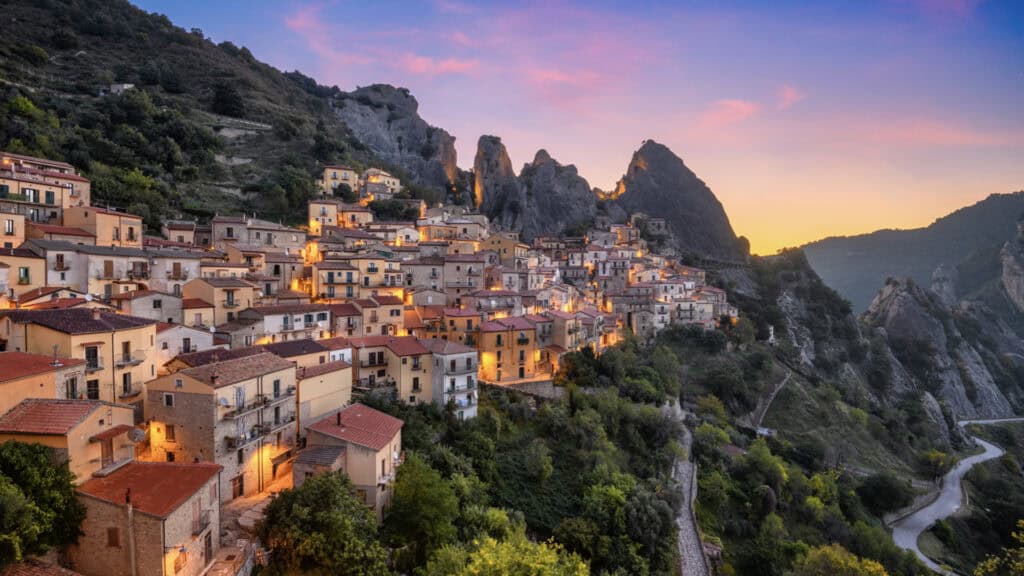
13. Castelmezzano, Basilicata
Castelmezzano in Basilicata is one of the best small Italian towns to visit, even though you may never have heard of it. The town has an old-world charm, which is unsurprising as it was first established in the 10th century. With the Dolomiti Lucane as its backdrop, the city is spectacular, whether viewed from within the town or from a distance from the neighboring town of Pietrapertosa, which can be accessed in high-speed fashion taking the Flight of the Angel, a specially designed, zip-line between the two towns.
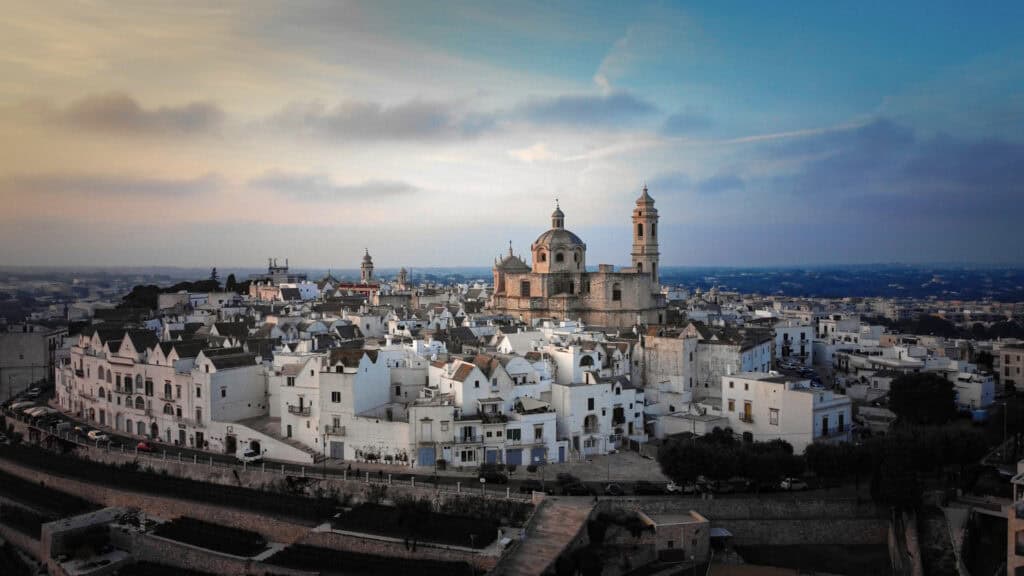
14. Locorotondo, Puglia
One of the most beautiful Italians to visit that you may not have heard of is Locorotondo in Puglia. Its curious name comes from the shape the two were built in, though you would be hard-pushed to notice this from the ground level. That aside, this town is gorgeous and has an almost dream-like atmosphere and overall aesthetic, with white-washed walls bordered and brightened by the pink and purple flowers blossoming from pots.
While here, dine in one of the many quaint little restaurants to try local Italian cuisine and gelato. The cost of the food and accommodation there makes it ideal for anyone looking into frugal options.

15. Mantua, Lombardy
Among the many small towns in Italy worth visiting, Mantua in the Lombardy region is underrated not just within the country but also on the continent of Europe. This is even more surprising when you consider it is home to the biggest residential building in continental Europe outside of the Vatican and is full of architectural and art-loving gems.
That’s not all, as three astonishing artificial lakes surround the town, one covered in lily pads. However, the most impressive thing about this town is the grand interior of the buildings found throughout the town. This is primarily a thank you to the Gonzaga rulers who oversaw the construction of these structures and headed up their design. The Ducal Palace, sprawling and intimidating but beautiful and ornate, has around 600 rooms. Okay, so only a few are open for members of the public, but those few are filled with some awe-inspiring art and grandiose frescos.
While there, you should also visit the Te Palace, which has many grand halls, and the Teatro Bibiena.
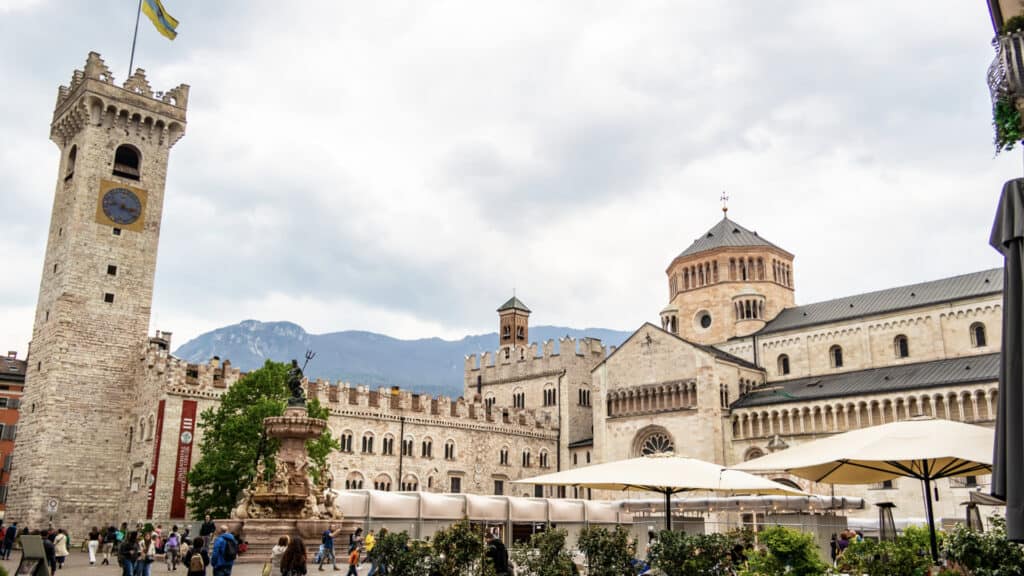
16. Trento, Trentino
Finally, to close out our guide, one of the small towns in Italy worth visiting is Trento, the capital of the stunning Trentino region. If you want a quieter and more relaxed Italian break, it is perfect as it is just the right size. There is still plenty to see and do, including many cultural spots of interest, great places to check out local and national art, and an exceptional range of eateries where you can sample some of the finest food in the region.
If you want a bit of quiet and more space to explore easily, you will like the lack of tourists and the general cleanliness of the town. Make time to check out the spectacular Bunoconsiglio Castle.
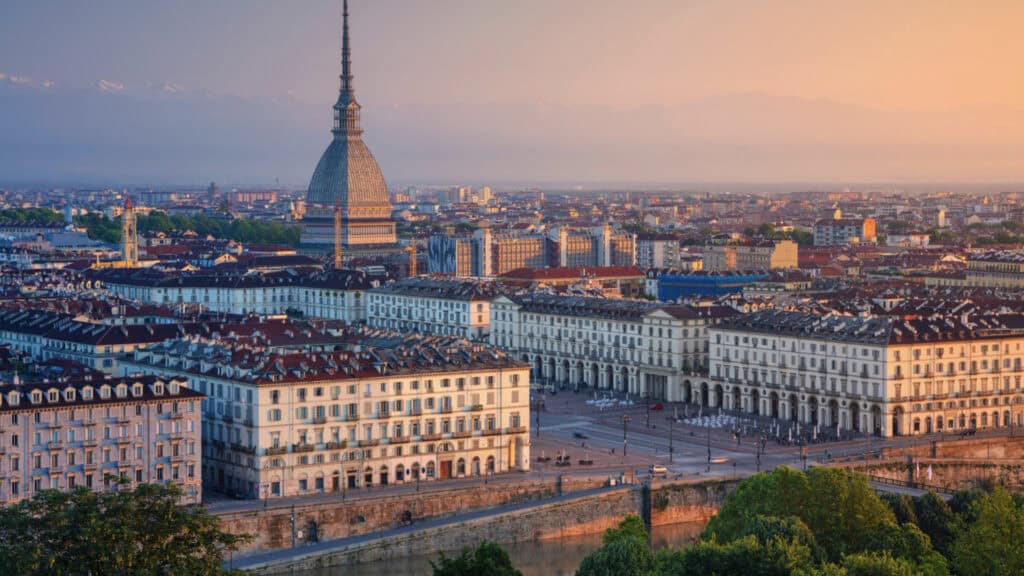
Small Towns in Italy To Enjoy
There you have it – some of the best small towns to visit in Italy if you want to avoid the tourist-heavy places or have already visited towns and cities like Pompeii, Rome, and Venice. Italy is rich in heritage and history and benefits from a culturally diverse population.
Wherever you go, whether along the coast, in the north, south, east, or west, you are bound to have an unforgettable experience. This is especially true if you take them to the sensory delights of the fascinating, underrated towns listed above.
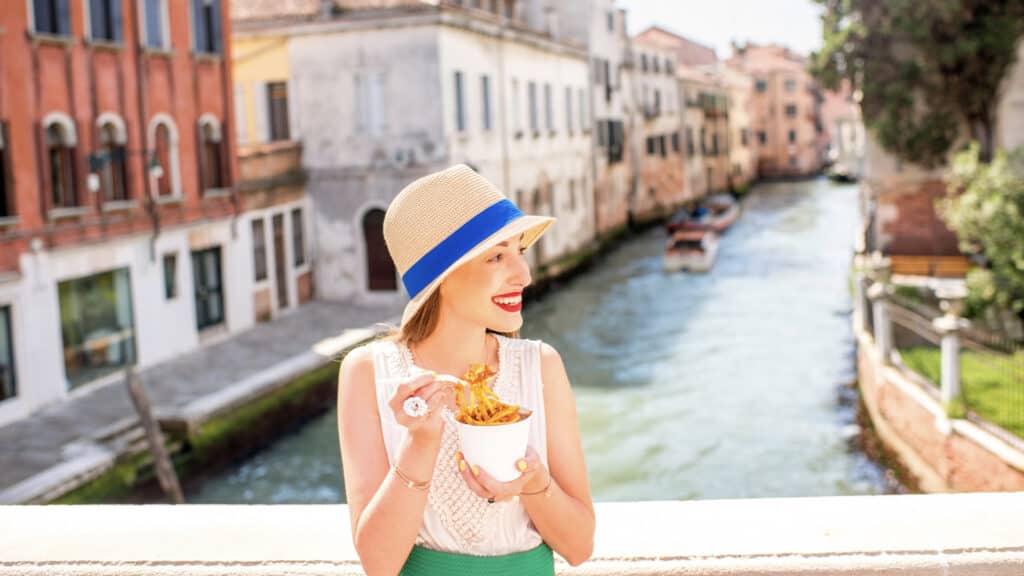
16 Common Travel Mistakes in Italy and How to Avoid Them
Italy is one of the most popular countries to visit for a summer vacation and with good reason. There are thousands of things to see and do: new experiences, history lessons, sunbathing at out-of-this-world beaches, and much more. Many people must realize that although you may come across many English speakers and expat Americans living in Italy, it is a different place with different rules and customs.
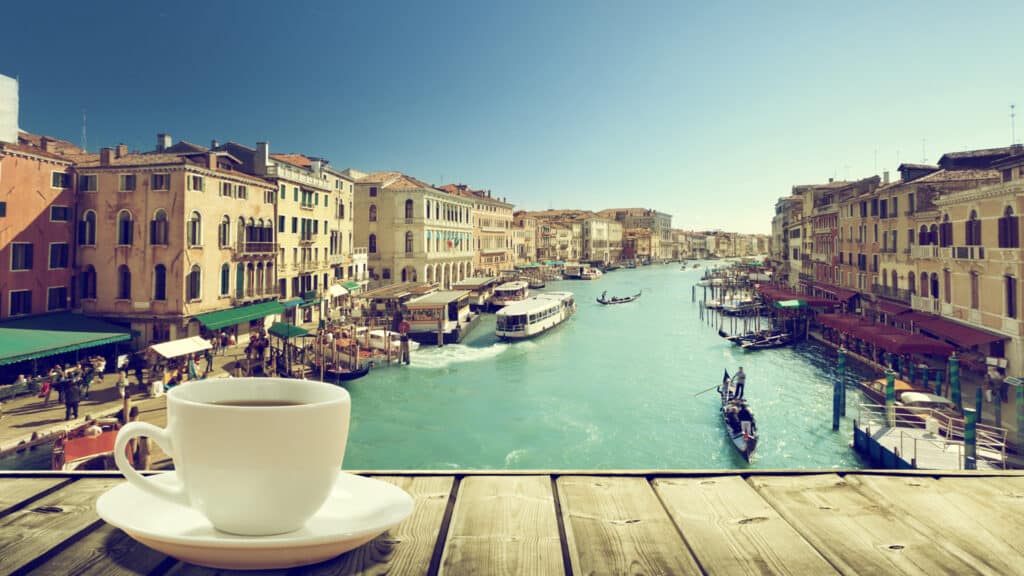
How to Plan a Summer in Italy: 15 Things That Should Be on Your List
If you go to Italy for your next summer vacation, you will have a memorable experience. Lush countryside, busy and modern metropolitan areas, quaint little villages, massive and imposing mountains, and coastal areas home to many fantastic beaches offering dramatic views of the Mediterranean Sea.
More for You
Harvard psychologist shares 5 toxic things 'highly narcissistic' people always do in relationships
What Is the Average Height for Women?
Average US annual salary by age revealed – see how you compare
Putin is using 'nuclear blackmail' — and Russia defeating Ukraine could spark global chaos and economic disaster, Jamie Dimon warns
Do I have to pay off my spouse's debts when they die? Here's what you're responsible for and what you aren't after a loved one's death
Steelers Vision for the Future Becoming Clear as Khan Puts Stamp on Team
Barack Obama shares his No. 1 piece of advice for his own daughters: Don't let your hunger for success ruin your happiness
How Much Beer You'd Have To Drink To Equal A Single Shot Of Liquor
Here’s What the US Minimum Wage Was the Year You Were Born
We Ordered 7 Fast-Food Breakfast Sandwiches to Find the Best One
Last letters of pioneering climber who died on Everest reveal dark side of mountaineering
iPhone users in 92 countries received a recent stark warning
Harvard psychologist: If you say 'yes' to any of these 9 questions, you're 'more emotionally secure than most'
'10-foot-tall people' discovered by archaeologists in Nevada cave
Another Two Insurance Companies Intend to Withdraw From California Amid State Insurance Crisis
Martin Lewis issues warning to people choosing air fryer over oven
Southwest Airlines Is in Trouble
China could force Putin to leave Ukraine in 'major shockwave to Moscow'
Here's No. 1 thing mentally strong couples 'never' do, says relationship therapist of 20 years
Unsellable Houses' Lyndsay Lamb Says Buyers Are Moving Away From This Color Trend

IMAGES
VIDEO
COMMENTS
Breathe, you're in Trentino. Picture yourself leisurely enjoying the wonders of nature. Picture yourself taking your time and exploring Alpine woods, valleys, rivers and lakes. Picture yourself discovering a fresh sense of balance and well-being as you walk in the mountains, relax on the snow or sit and savour a glass of sparkling Trentodoc wine.
Madonna di Campiglio. Madonna di Campiglio is certainly one of the most iconic places in Trentino. The town has just 800 inhabitants and is located at 1500 meters above sea level between the Brenta Dolomites and the Adamello glaciers. Famous for winter sports, it has 156 km of slopes of different difficulty levels.
Organizza la tua vacanza in Trentino. La tua vacanza in montagna tra le Dolomiti e il lago di Garda organizzata in pochi click. Informati e Prenota Online dal Portale Ufficiale del Trentino.
Provinces of the Trentino Alto Adige Region . The Trentino-Alto Adige region is broken into two provinces. The southern province of Trentino is mostly Italian speaking while in the northern province of the Alto Adige, called Sudtirol or the South Tyrol, the inhabitants speak mostly German and towns have both an Italian and a German name.The South Tyrol was part of Austria-Hungary before being ...
Trentino-Alto Adige is a region in northeastern Italy, known for its natural beauty, culture, and unique traditions. The region comprises two autonomous provinces, Trentino and South Tyrol, and offers a wide range of attractions for tourists, mainly related to mountains and winter. Bordering Austria, Lombardy, Veneto, and Switzerland, it has as its regional capital the city of Trento, of Roman ...
The Buonconsiglio Castle is the largest and most important monumental complex of the Trentino Alto Adige region. It was the residence of the prince-bishops of Trento from the 13th century to the end of the 18th century, and is composed of a series of buildings of different eras, enclosed by walls and positioned slightly higher than the city.
Visit Trento, the capital of Trentino Alto Adige. Your holiday in Trentino Alto Adige has to include Trento. Actually, you might as well spend here a couple of days or even make it the base for exploring the region. To visit Trento, two or three days would be enough, depending on how much you want to see.
A paradise for those who love sport, untouched nature, uncompromising mountains and traditional flavours: the Dolomites, the legendary mountain range of the Eastern Alps, a UNESCO World Heritage List site. The so-called "pale mountains" are distributed over three regions, Trentino Alto Adige, Veneto and Friuli Venezia Giulia.
Rough Guides® is a trademark owned by Apa Group with its headquarters at 7 Bell Yard London WC2A 2JR, United Kingdom. Plan your visit to Trentino-Alto Adige, Italy: find out where to go and what to do in Trentino-Alto Adige with Rough Guides. Read about itineraries, activities, places to stay and travel essentials and get inspiration from the ...
The Buonconsiglio Castle is the largest and most important monumental complex of the Trentino Alto Adige region. It was the residence of the prince-bishops of Trento from the 13th century to the end of the 18th century, and is composed of a series of buildings of different eras, enclosed by walls and positioned slightly higher than the city.
South Tyrol Newsletter. Join us for a fresh pack of exclusive offers, fun adventures, breathtaking views, local recipes and much more. Make the most of your vacation! Find out here, the things you can like about South Tyrol. Choose your accommodation, events and local products for your holiday in South Tyrol - such as Alto Adige wine, Speck ...
Trentino-Alto Adige is made up of two provinces, the Italian-leaning Trento (or Trentino) in the south and the Germanic-leaning Alto Adige (or Südtirol, and also called Bolzano-Bozen, just to keep things interesting) in the north. Home to numerous picturesque towns, castles and historic sights, the main attraction here is the mountains.
Trentino Alto Adige, also known as Trentino-South Tyrol or Südtirol, is an autonomous region in Northern Italy located in the Alps.The capital city is Trento, and the region covers an area of 13,607 km2 with a population of around 1.1 million. With its combination of Alpine peaks, green valleys, lakes, medieval castles, and modern cities, Trentino Alto Adige offers stunning natural scenery ...
Top Trentino-Alto Adige Landmarks: See reviews and photos of sights to see in Trentino-Alto Adige, Italy on Tripadvisor. Skip to main content. Discover. Trips. Review. USD. ... At the end of the visit (7 euro per person) you can also buy some goat cheese from his shop nearby. A bit disappointed by the prices of cheese in the end. :-)
5. The castles of Val di Non. In Trentino you can find many castles, Val di Non has the most and is on our list of ten unmissable places. Visiting them is a great emotion, talking to the owners is an unforgettable experience. The first to open to the public was Thun Castle and this gave a hint to the others.
Trentino-Alto Adige's towns are packed with art and history. Visit Trento to see Buonconsiglio Castle and a beautiful Romanesque cathedral. Meander through the narrow streets of Bolzano, where pastel-colored terraced houses overlook the Piazza del Municipio. War history is a popular subject in Roverto. The topic is especially well-covered in ...
6 Top Reasons to Visit Trentino Alto Adige. A trip to Trentino, as Italians call the region, will take you to a unique and awe-inspiring area of northern Italy! Trentino is important for its cultural heritage, with the region being home to a number of charming castles and historic towns. But it's also impossible to ignore the magnificent 360 ...
Trentino-Alto Adige - a guide and places to visit. For a summary of the most popular sights in the region see also Trentino-Alto Adige places to visit. The Trentino-Alto Adige region is the most northerly region of Italy, and includes much of the Dolomites, and continues north into the Alps
Learn more about the best places to visit in and around this northern Italian city with our list of the top tourist attractions and things to do in Trento. See also: On This Page: 1. Castello del Buonconsiglio and Torre Aquila. 2. MUSE (Museum of Science) 3. Piazza del Duomo and Neptune Fountain.
The environment is our greatest wealth, and we go to great lengths to take care of it. For this very reason, the landscapes of Trentino aren't simply about picture-perfect panoramas, but rather they are living entities maintaining a delicate balance between plants, animals and humans.You can sense it when you explore our enchanted valleys, forests and mountains: it would be a pity to return ...
Best Places To Visit in Trentino-Alto-Adige. 1. Bolzano: Located in the heart of Trentino-Alto-Adige, Bolzano is a charming city that offers a unique blend of Italian and Austrian cultures.The city is famous for its stunning architecture, with the Piazza Walther being a must-visit spot. Bolzano is also a gateway to the breathtaking Dolomites, making it a perfect base for outdoor enthusiasts ...
Trentino-Alto Adige/Südtirol (US: / t r ɛ n ˌ t iː n oʊ ˌ ɑː l t oʊ ˈ ɑː d iː dʒ eɪ /, UK: /-d ɪ dʒ-,-ˌ æ l t oʊ ˈ æ d ɪ dʒ eɪ /; Italian: Trentino-Alto Adige [trenˈtiːno ˈalto ˈaːdidʒe]) is an autonomous region of Italy, located in the northern part of the country. The region has a population of 1.1 million, of whom 62% speak Italian as their mother tongue, 30% ...
Capital of Trentino Alto Adige and one of its most important hubs, the many things to do and places to visit in Trento make it for a perfect stop in the region. Whether you are planning a holiday in the Dolomites or a trip to discover the other cities of the Trentino Alto Adige region , you can't miss a trip to Trento.
Bolzano, Alto Adige To kick off our guide to the underrated and best small Italian towns to visit, we wanted to highlight the stunning Bolzano. Found in northern Italy in the South Tyrol province ...